



Opening Event: Saturday 13 October 2012, 1-4pm
co-hosted with The Festival of Mint – A Celebration of Local Growing – serving mint tea and mojito
Contact: info@furtherfield.org
DOWNLOAD PRESS RELEASE FOR PRINT HERE
+ See images of the exhibition on Flickr.
To be alive is to be wild. And we humans have a will that shapes the world with language, song, lust, labour and play. And for those of us who connect with it, a network of machines now extends our reach, amplifies our urges and quickens our exchanges.
The artists in this exhibition work and play with living organisms and technical things, systems and language, to explore how our relation to the natural world is changing. They introduce us to the unruly life going on in other natural webs of communication, knowledge and feral exchange. Gallery visitors (humans and dogs) are invited to view videos, interact with art installations and social media and undertake walks in the surrounding park with its other animals and edible plants.
Mary Flanagan travels overland and undersea in virtual worlds. Her journeys in the worlds are caught on video. Her avatar scouts the boundary lines of ‘heritage’ landscapes built by “residents”. Her walks are inspired by Thoreau, the great American writer and walker, who knew that ‘all good things are wild and free’.
![Aquitaine from the [borders] series by Mary Flanagan](http://www.furtherfield.org/wp-content/uploads/2012/08/borders-acquitaine-web.jpg)
Andy Deck calls attention to echoes of the wild in language. Despite the many entertaining digital visions of nature beamed to the flat screen, a wealth of intuitions relating to nature still survive in colorful expressions passed down for centuries. He invites you to help him build a bestiary of animal idioms using social media and a gallery installation.*
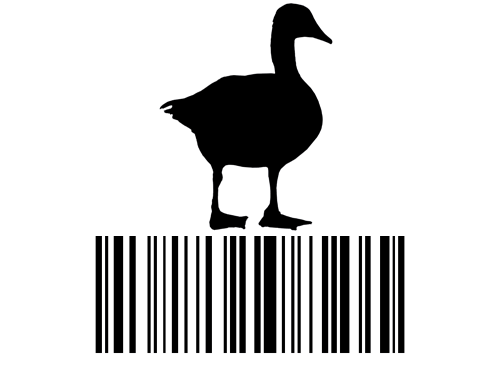
Sarah Waterson has invented a set of cartographic tools for dogs (and their human friends) to develop an interspecies psychogeography. Her electronic mapping system generates sniff data, routes and photographic journals supporting communication, collaboration and knowledge-sharing between companion species.
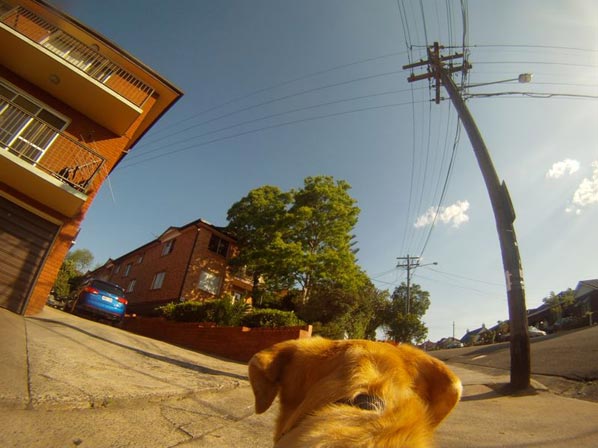
Helen Varley Jamieson and Paula Crutchlow dramatise the private actions and global consequences of our domestic lives in a long-running series of networked performances located in peoples’ homes. Dave’s Quiz (part 2) is an interactive extension of their provocation to discuss and appreciate relationships between personal, state and corporate responsibility around issues of consumption and disposal in late-capitalism.
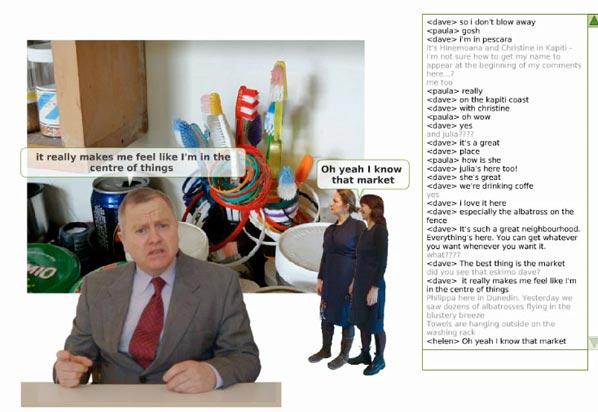
Artists duo Genetic Moo invite us to discover a dark, interactive sea of wiggling, luminescent creatures that gorge on torch light. They fantasize an evolutionary digression through the lens of human sensuality, drawing on images made by early scientists as they first found micro organisms or Animacules swarming in every sea, pond and pool of saliva.
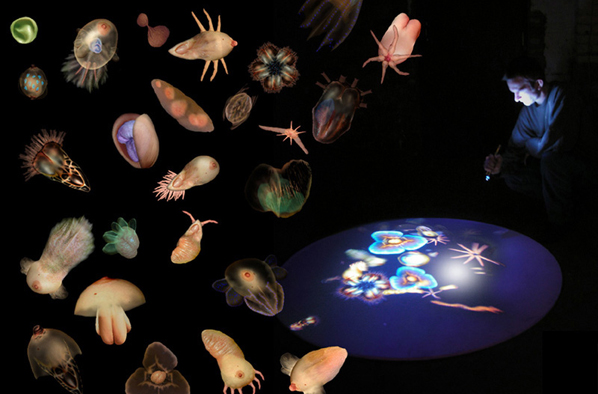
Disquieted by the environmental impact of constant technological upgrades, Dominic Smith works with open knowledge from the DIY mycology movement to create a system that combines the waste products from the tools and fuels of the contemporary coder. Out-of-date software manuals and coffee grounds are shredded to create a compost for fruiting oyster mushrooms to be harvested and consumed by visitors.**

This exhibition is dedicated to Jay Griffiths, author of WILD: An Elemental Journey (2006).
* Crow_sourcing is a 2012 Commission of New Radio and Performing Arts, Inc. for its Turbulence website. It was made possible with funding from the Jerome Foundation. http://Turbulence.org/Works/crow_sourcing
** Dominic Smith developed this iteration of the shredder concept, originated by Julian Priest, David Merritt & Adam Hyde, as part of the geekosystem project. It is an experimental transposition of software development methods taking an organic, material form. It’s also worth noting that in his 1998 net art work Shredder 1.0 Mark Napier took the texts and images from pages of the WWW and jumbled them in colourful abstractions to reveal their ‘rawness’ once freed from the strict orthodoxies of web page design.
Crow_sourcing by Andy Deck
[borders] by Mary Flanagan
Animacules by Genetic Moo
make-shift: Dave’s quiz (part 2) by Helen Varley Jamieson & Paula Crutchlow
Shredder by Dominic Smith
Laika’s Dérive – The dogs de Tour by Sarah Waterson
Paula Crutchlow
Paula Crutchlow is a performance maker and director who co-authors live events across a variety of forms. As a co-founder and director of Blind Ditch she combines digital media and performance to engage audience and participants in distinct and active ways. Her work often uses a mix of score/script, improvisation and structured interaction to focus on boundaries between the public-private, and issues surrounding the construction of identity and the politics of place. Paula is currently the Creative Advisor for Adverse Camber directing work with some of the UK’s leading storytellers, she was an Associate Lecturer in Theatre at Dartington College of Arts, Devon 2001-10, and teaches Digital Performance Practice at the University of Plymouth.
Andy Deck
Andy Deck specializes in collaborative processes and electronic media. As a Net artist and software culture jammer, Deck combines code, text, and image, demonstrating patterns of participation and control that distinguish online presence and representation from previous artistic practices. In addition to numerous online exhibitions, his work has appeared in exhibitions like net_condition (ZKM), Unleashed Devices (Watermans Art Centre), and Animations (PS1-MoMA). He is also a co-founder of Transnational Temps, a media arts collective concerned with making Earth Art for the 21st Century.TM After showing in EcoMedia, a ground-breaking series of european exhibitions, Transnational Temps mounted the 2010 oil-related exhibition Spill>>Forward in New York. In 2011 Deck received first prize in the interactive division of the LÚMEN_EX Digital Art Awards. Deck’s work, currently shown by the Whitney Museum of American Art’s Artport and the Tate Online, has been commissioned by these and other prestigious institutions. Deck lives and works in New York City.
Mary Flanagan
Mary Flanagan is an artist focused on how people create and use technology. Her collection of over 20 major works range from game-inspired systems to computer viruses, embodied interfaces to interactive texts; these works are exhibited internationally at venues including the Laboral Art Center, The Whitney Museum of American Art, SIGGRAPH, Beall Center, The Banff Centre, The Moving Image Center, Steirischer Herbst, Ars Electronica, Artist’s Space, The Guggenheim Museum New York, Incheon Digital Arts Festival South Korea, Writing Machine Collective Hong Kong, Maryland Institute College of Art, and venues in Brazil, France, UK, Canada, Taiwan, New Zealand, and Australia. Her three books in English include Critical Play (2009) with MIT Press. Flanagan founded the Tiltfactor game research laboratory in 2003, where researchers create game interventions for social change.
Genetic Moo
Genetic Moo build living installations in pixels and light. The duo have been creating interactive art since 2008. Virtual creatures are constructed from choreographed video clips, combining elements of the human and the animal. They respond in a variety of life-like ways to audience motion, sound and touch and vary in size from the tiny Animacules to the all encompassing Mother. The works are driven using Open Source and Flash Software utilizing a variety of interactive interfaces. The programming behind the work is just complex enough to make the creatures appear more believable and create rich user driven narratives.
Schauerman and Pickup both gained Masters degrees from the Lansdown Centre of Electronic Arts. Their work has been exhibited extensively including the De La Warr Pavilion (2010); Watermans (2010) The Wellcome Collection (2011) and Glastonbury (2011). One of their works, Starfish, received a John Lansdown Award for Interactive Digital Art at Eurographics (2007) and was nominated for an Erotic Award (2012).
Helen Varley Jamieson
Helen Varley Jamieson is a writer, theatre practitioner and digital artist from New Zealand. In 2008 she completed a Master of Arts (research) at Queensland University of Technology (Australia) investigating her practice of cyberformance – live performance on the internet – which she has been developing for over a decade. She is a founding member of the globally-dispersed cyberformance troupe Avatar Body Collision, and the project manager of UpStage, an open source web-based platform for cyberformance. Using UpStage, she has co-curated online festivals involving artists and audiences around the world. Helen is also the “web queen” of the Magdalena Project, an international network of women in contemporary theatre.
Dominic Smith
Dominic Smith is an artist who engages with project hierarchy, ownership of ideas and heuristic curatorial strategies. Dominic is a founding member of ptechnic.org. He has exhibited and performed at Govett-Brewster Art Gallery in New Zealand, at the ICA in London, CCA Glasgow, AV Festival, Newcastle and Eyebeam NY. He has a doctorate with CRUMB at Sunderland University that examines the relationship between open source production methods, and art/curating methods. Dominic is also the current curator of thepixelpalace.org through which he also developed and runs basic.fm
Sarah Waterson
Sarah Waterson has practised as a new media artist for the past twenty years. Her works include electronic installations, collaborations with performers, video and audio work, generative and software based artworks, VR environments and data visualisations and ecologies. Interdisciplinary and collaborative practice informs the development and ultimately the design of these artworks. Her current interests include data mapping, data ecologies and cross species collaboration.
Sarah’s recent interactive installations have included: Laika’s Dérive (Performance Space, Carriageworks 2011), 33ºSouth (collaboration with Juan Francisco Salazar, Casula Powerhouse 2009), a custom made data mapping system that juxtaposes the cities of Sydney (Australia) and Santiago (Chile) trope, a e-literature project developed for the Second Life environment (SWF 08, ongoing), subscapePROOF (collaboration with Kate Richards, Australian Centre for the Moving Image, Melbourne), and subscapeBALTIC (ISEA2004, Helsinki, Finland). Sarah is a senior lecturer in interactive media at the School of Humanities and Communication Arts, University of Western Sydney, Australia.
Furtherfield Gallery
McKenzie Pavilion, Finsbury Park
London N4 2NQ
T: +44 (0)20 8802 2827
E: info@furtherfield.org
Furtherfield Gallery is supported by Haringey Council and Arts Council England
Part of Furtherfield Open Spots programme.
Please join us for a drop-in ‘clipsourcing’ workshop led by Swedish artist Josefina Posch in collaboration with artist and new media developer Mike Blackman (UK).
Using online tools specifically created for the project, participants will identify who the speakers are, contribute keywords, and rate short movie clips from the online public domain Film Noir Archive. The contribution will help shape the final interactive piece that will be streamed live at Futherfield Gallery in December 2012.
See images of the workshop on Flickr.
{crowdsourced} Noir / Love Beyond Recognition is a process-based artwork encompassing a sculptural installation and an interactive stream across the World Wide Web. The origin of both parts of the project is based upon the notion of ‘crowdsourcing’. The principle being that more heads are better than one. By canvassing a large crowd of people for ideas, skills, or participation, the quality of content and idea generation will be superior. In this instance, crowdsourcing will be applied through the use of clipsourcing tools which have been developed to aid in project-related tasks that can only be achieved through human interaction/intervention. This way, the crowd will help the artist achieve these tasks whilst adding a democratic element to the final outcome of the project.
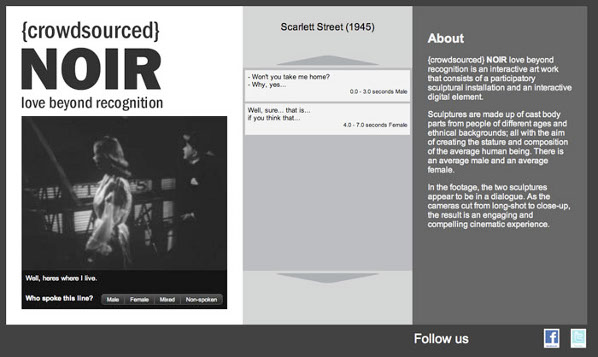
During Spring and Summer 2012, an interested public will be able to both participate and contribute to the project’s creative process in two distinct ways: in Sweden as models, whereby a cast will be taken of a chosen body part (the body parts will later be assembled to full figure sculptures) and in the UK by taking part in a workshop at Furtherfield Gallery to help source short clips from the Online Public Domain Film Noir Archive through our online tool. The final iteration of the project will be exhibited in Gothenburg, Sweden in December 2012 with live interactive streams at Furtherfield Gallery, London.
Josefina Posch
Josefina Posch is a Swedish artist that has worked and exhibited extensively abroad, including at the 52nd Venice Biennale, Fondazione Pistoletto’s Cittadellarte, Sculpturespace NY and a residency at Duolun Museum of Modern Art Shanghai. During her 3 month residency at Art Space, Portsmouth, in Autumn 2010, she began her collaboration with artist and new media developer Mike Blackman in the development of her digital concepts.
The project is supported by Arts Council England/British Council and the Gothenburg City Arts Council.
Featured image: Still from Me and Mrs Sloan (Susan Sloan (2007). Motion-captured animation of artist’s mother.
Susan Sloan’s exhibition of motion captured portraits on The Wall at The Photographers Gallery raises issues in terms of data object relations and computer animation – or ‘animatography’.
In critiquing the work by Susan Sloan, currently on show on The Wall, what emerges is the artist’s concern with the essential qualities of the data space that she is utilising. What has become apparent is the distinct new medium of animatography, as used in virtual reality art works like Sloan’s, as well as in the more ubiquitous moving image; a language which is not composed uniquely by the author/animator, but also by the apparatuses of computing and software development which are then engaged with by artists and other individuals, “they [photographs] are produced, reproduced, and distributed by apparatuses, and technicians design these apparatuses. Technicians are people who apply scientific statements to the environment.” [1] In this way, a piece of proprietary software like SoftImage, can be seen as an apparatus much like a camera or an easel.
In answer to the Photographers Gallery’s questioning of the impact the digital is having, I would argue that the critical and theoretical discussion of computer animation use in virtual art works should focus on the creative exploration of data object relations. I am also suggesting that the term animatography be applied when talking about the medium of computer animation, and the following discussion focuses on the development of an awareness of how this language is utilised in art in virtual space.
The medium of animatography can be explored as an essentially synthetic medium which extends the languages of animation into one of data object descriptions; the use of data to describe virtual objects, and the complexity of these descriptions. Sloan’s work very much explores the nature of applying data to ‘objects’ or rather, as it means in psychoanalytic terms, subjects. The work is composed of complex object descriptions, comprising 3-D modelling techniques as well as motion capture data.
First it is necessary to look at data object relations in terms of psychoanalytic theory, then its applicability to animatography. Susan Sloan’s work, highly explorative of this as it is, is looked at to further elucidate the relationship between data, psychoanalytic theory and animatography.
To understand this approach it is first necessary to outline a theory of object relations as explored by Peter Fuller in relation to art works. Fuller applied D.W.Winnicott’s major psychoanalytic concept of the ‘potential space’ [2] and found that he could relate this theory to his study of aesthetics, and it has informed the development of a theory of animatography, which is based on our relationship with ‘data objects’, in aesthetic and cultural terms.
Winnicottís theory describes a baby’s gradual development and awareness of herself as a ‘separate autonomous human being’ [3] in relation to, at first, her mother. While up until that point she has felt at one with her mother, several months after birth, at a key moment, this recognition of autonomy starts to occur. Fuller writes, “This process of discovery seems to be a vital period of human growth. During it, the baby, necessarily posits the idea of a ëpotential space.” [4] He quotes Winnicott’s definition of potential space as: “the hypothetical area that exists (but cannot exist) between the baby and the object (mother or part of mother) during the phase of the repudiation of the object as not me, that is at the end of being merged in with the object.” [5]Fuller then points out that “Much in Winnicott’s view, depended on this ‘potential space’ between the subjective object and the object objectively perceived, between me-extensions and the not-me.” [6]
Potential space, Fuller explains, is important to creativity and to understanding aesthetic experience. The ‘location of cultural experience’ is derived from the ‘potential space’ where ” – if he has sufficient trust in his environment – the individual can explore the interplay between himself and the world, not as mere fantasy, but as cultural products which can be seen and enjoyed by others.” [7]
Similarly the cultural products of computer animation and therefore the aesthetics of animatography can be seen to derive from a relationship to the potential space, as transitional objects of meaning and value generated through a type of work and/or play. For Winnicott, “play is the paradigm of cultural activity” [8] and “cultural activities are those in which the experiences of the potential space are still operative.” [9] If we take Winnicott’s and Fuller’s theories, the potential space exists for artists, animators and a participating audience in which a play of separation; where a perception of what is me and what is ‘not-me’, takes place. There is no essential difference here between traditional media and animatography, apart from the specific differences of the nature of data itself, and therefore how we relate to data object descriptions.
If we add to this theory of ‘potential space’ with feminist psychoanalytic theory, which, in contrast to a generally masculine approach sees positivity in closer connectedness: “Chodorow herself suggests that care and socialisation of girls by women produces attributes which could (and should) be regarded positively; a personality founded on relations and connection, with flexible rather than rigid boundaries, and with a comparatively secure sense of the non-hierarchical nature of gender difference.” [10] We can see Sloan’s work as a carefully constructed interplay between artist and subject. Also, what does it mean to be described by data, which has automation at its heart, and yet requires a lot of skill to achieve this level of detail?
In virtual environments, the avatar is a key aspect for enabling a realisation of the ‘world’ to take place through human-computer interaction. In the works currently on show, Sloan looks intensely at the animated portrait, which inevitably relates to the condition of the avatar, while raising questions of perception to do with notions of reality and authenticity. Portrayed through animatography, the data object of the portrait model is related to as a me-extension, as well as sometimes being felt to be not-me, but a representative of the self, in terms of the freedom of self portrayal in this genre. In this sense, Sloan’s work suggests avatars ‘which really look like you’, through which the complex psychological reaction of what is me and not-me can be apprehended.
As such animatography could be said to have a physicality, in terms of the data it is composed of. Projecting the imagination into a notional space, the artist can at the same time make that space pragmatic in symbolic terms. A fantasy, and yet a data driven reality. This paradox between perceiving the physicality of data and the perception of the animatographic illusion as simply a fantasy lies at the heart of this relationship.
Susan Sloan’s Me and Mrs Sloan (2007), explores data object relations in the form of a motion captured portrait of her mother synthesized with motion captured movement by herself. It is a work about the potential space itself. In this instance, the artist has modelled the head and upper torso of her mother, in 3-D animation software, and then animated the head and shoulders, based on subtle motion captured material of herself. In this way, the data object is her mother combined with herself in terms of the motion captured material. It is Sloan’s work, and therefore the dialogue with what is ‘not-me’ is a fascinating one. The motion captured material is also ‘not-my-mother’, and instead it is a record of Sloan’s slight movements. In terms of locating ‘cultural experience’ (Fuller, 1980) this is a study of whether and how the potential space exists, when working with animatography. What is isolated or exposed, is that we relate to the ‘data object’ in the form of Sloan’s mother, as if the essence of potentiality in the relationship is somehow captured, in a way that explores what it means to relate to data that is ‘all-there-is’. This helps to establish that there is a cultural experience in the work, by the subject of the work itself.
The work explores synthesis in data terms, the portrait model with the motion captured movement used to animate it. In this sense identity is blurred artificially, and a synthetic effect is created, yielding a potential space in animatographic terms. In this work a synthetic identity, in this case between mother and daughter, becomes possible, which is like an advanced form of the avatar in multi-user platforms.
The concept of ‘potential space’ can be used to understand the nature and significance of data object relations in animatography, the me-extensions and the not-me, through programming a computer or manipulating a computer program to make animation is what this work points to in technical terms.
Animation is principally iconic, which means that there is more me-ness in its structure and execution than the traditional film image, which is partly composed of the indexical. [11]It can be argued that the engagement animatographers have with the portrayal of data object relations is precisely what identifies the need for animatography as a separate discipline, one which can culturally embody the unavoidable relationship we now all have with data objects in a more ubiquitous sense.
Data object relations in terms of Sloan’s work, has been considered in relation to psychoanalytic theory and its applicability to animatography. Through analysing a preoccupation with object relations, and specifically ‘the potential space’ as found in Winnicott’s theory, evidence of the potential space is found to exist as subject matter within Susan Sloan’s work. This is potentially an important aspect in critiquing art which explores subtle synthesis as an aspect of data object relations.
Dr Stephen Bell and Susan Sloan at the NCCA (National Centre for Computer Animation) in Bournemouth, United Kingdom
An interview with Katrina Sluis, Digital Curator at the Photographers’ Gallery By Marc Garrett
http://www.furtherfield.org/features/interviews/interview-katrina-sluis-digital-curator-photographers-gallery
Lies, Lawlessness and Disbelief: An Attempt at Thinking Art and Capital is an essay by Canadian artist & critical thinker, Katie McCain. McCain discusses how capitalism has become on the one hand all-encompassing and on the other utterly unreal. Arguing that we need to focus on moments of paradox, illogic and the impossible in order to rethink capital, this essay explores and succumbs to the circuity of it’s own thinking. Drawing on a host of sources, it attempts to weave an account in which system failure is seen as a point of rupture, whether in legislation, bureaucracy or thought itself.
Moments of paradox are seen as a space in which to re-orient our capacity for thought, and in doing so find a place for art as a point of resistance. It promotes a negative approach to capital, a re-imagining of nihilism, and fosters a general penchant for the illegal and the illogical. Ultimately it seeks the expansive space contained within what is impossible or unknown, although this is known to be impossible.
Download PDF of Lies, Lawlessness and Disbelief: An Attempt at Thinking Art and Capital
We are collecting childhood rhymes from around the world spoken by many generations of local residents of the borough for a sound installation as part of the Cultural Olympiad Festival.
Please come to Furtherfield Gallery in Finsbury Park on Saturday 21 July, 11-3pm to take part!
See images of the launch on Flickr.
Artist and composer Michael Szpakowski has worked with local children and their families to create a generative sound sculpture that invokes the collective memory of childhood, drawing on the memories of Haringey residents from all over the world.
A collective memory of childhood will be launched on Saturday 28 July 2012, 2-5pm.
To add your voice to this sound installation come to the gallery on Saturday 21 July between 11am and 3pm. You will meet the artist Michael Szpakowski who will be recording with you and other local residents any childhood rhymes, skipping songs or lullabies.
+ For more information please contact Ale Scapin
Michael Szpakowski is an artist, composer and film-maker who devises and facilitates many of our Outreach projects with young people. Participants create films, games and performances that explore the tools and processes of co-co-creation in a digitally connected world. The work engages young people, meeting them where they are in a constructive, imaginative and inclusive way. With DVcam in hand he finds poetry in the everyday, music in a London pavement and if called upon could find a way to inspire the imaginations of curbstones with his enthusiasm, experience and skill-sharing abilities.
www.somedancersandmusicians.com
Featured image: “Born in 1987: The Animated GIF” from the site’s page.
Marc Garrett interviews Katrina Sluis, the new curator of the Digital Programme at The Photographers’ Gallery, London. We discuss about the gallery’s recent show Born in 1987: The Animated GIF and what kind of digital exhibitions and projects we can expect from the gallery in the Future.
An edited selection shown on the London Photographers’ Gallery’s new digital wall, during the final weeks of the show. http://thephotographersgallery.org.uk/the-wall-2
The exhibition microsite. An open conversation where anyone can join in and contribute their own GIFs. http://joyofgif.tumblr.com/
Marc garrett: You have joined The Photographers’ Gallery and as part of the new digital programme launched the exhibition “Born in 1987: The Animated GIF”. Could you tell us about this project?
Katrina Sluis: The digital programme presents projects both online and offline, which respond to recent dramatic shifts in the digital image as it becomes increasingly screen-based and networked. As part of this new programme we have launched ‘The Wall’ – a permanent exhibition space on the ground floor of the Gallery, visible both to visitors and passersby on Ramillies street. The Wall itself is a 2.7 x 3m Sharp video wall which we installed after considering a number of different technologies. We were conscious not to use digital projection as it would locate the project within traditions of cinema and video art, and we wanted the screens to respond to the reception and distribution of images within wider visual culture.
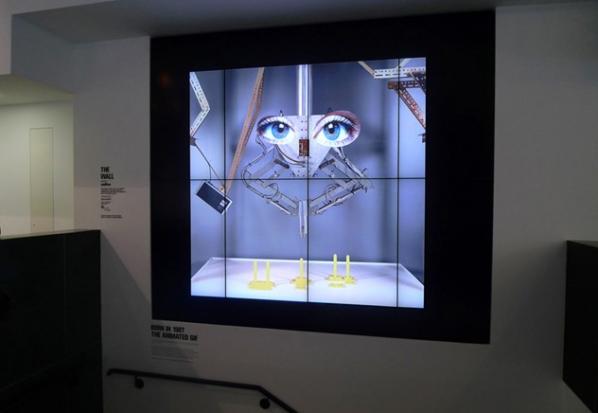
For the opening show, we decided to focus on the animated gif for a number of reasons. Firstly, the gif is a uniquely screen-based image format, in which the specific characteristics and limitations of the image file are inherent to the form, in contrast to the other kinds of images the gallery might show which might adopt digital techniques but result in traditional print-based photographic work destined for the gallery space.
I also wanted to disrupt certain expectations about the screens – the fetishisation of resolution and image quality, and what kinds of photographs The Wall’s programme might seek to address. The animated gif in this sense is very interesting – it is one of the first image file formats native to the web, and although it is 25 years old this year it has been undergoing a resurgence on platforms such as Tumblr. In a commissioned essay for the show, Daniel Rubinstein speculates that current resurgence of the gif “is not only part of the nostalgic turn towards the blurred, the unsharp and the faded but it is also a marker of a moment when the history of the network becomes the material from which the digital image draws its living energy.”[1] Frequently authorless and contextless, the gif image works on a different economy in which its value is based not on its uniqueness and scarcity (as in certain forms of art) but its circulation and proliferation. Although there have been significant practitioners of the gif form, it is a format which ultimately resists canonization. And, in the context of a photography gallery, it opens up other debates concerning medium specificity and the ‘post-photographic’.
In approaching the exhibition, I was keen to ask a diverse range of photographers, writers, organizations and other practitioners to contribute a gif for the show. In keeping with the unmonumental nature of the form, I asked contributors to respond within a short timeframe of 7 days. For many contributors, this was the first time they had made a gif; but other contributors already had large followings on Tumblr and some were established net artists. This opening show and associated Tumblr site (http://joyofgif.tumblr.com) became a starting proposition for the project in order to then open up The Wall to gif contributions from the wider public. We will continue to update The Wall with public responses on a daily basis until the final day of the show on 10th July.
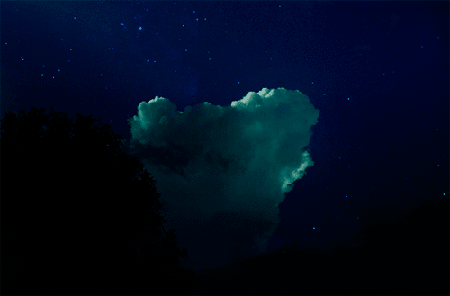
MG: At first, some may assume that the first part of the exhibition title ‘Born in 1987’, refers to the fact that today so many young people using computers these days were born in 1987. Yet, the GIF format, short for ‘Graphics Interchange Format’, was introduced to the world of computers by CompuServe in 1987. Was the title of the show deliberately playing with both notions?
KS: I like this idea! The title does self consciously play with the way in which the digital is valorised for its endless ‘newness’ and novelty but yet has this long and frequently overlooked history of creative experimentation. You can also see this reflected in the recent hype around the work of Kevin Burg and Jamie Beck who have (problematically and entrepreneurially) re-branded the gif as the ‘cinemagraph’.
MG: Do you consider this project to be net art, if so, how does it relate to other forms of net art?
KS: The project (and The Wall’s programming) does pose certain problems as it seeks to relocate certain forms of online practice(s) into the space of the art museum. At the same time, the project exists in an online context with its own very different life on Tumbr, where the work circulates in a very different context with a very different audience. I think there are many interesting opportunities which emerge from this intersection of the institutional frame of the museum (with its associated issues of cultural and curatorial authority and the legacy of aesthetic modernism) and the values and politics which inform certain kinds of networked arts practices.
But I also think the project also needs to be understood in the specific context of The Photographers’ Gallery, its history and audience. Whilst the project shares the concerns of net art by raising questions concerning authenticity, authorship and ‘the social’, it is also motivated by the need to rethink familiar notions of photography and temporality, indexicality and the economy of the image – concerns which presently haunt the field of photography theory.
![Kennard Phillipps. GIF image by Peter Kennard and Cat Phillipps. Born in 1987: The Animated GIF. The Photographers' Gallery 2012 [2]](http://www.furtherfield.org/wp-content/uploads/2012/07/fuck-the-markets-latest1.gif)
![Rad Racer glitch 3. GIF image by tracekaiser. Born in 1987: The Animated GIF. The Photographers' Gallery. 2012 [3]](http://www.furtherfield.org/wp-content/uploads/2012/07/tumblr_m5tqfl62wl1qew2moo1_400.gif)
MG: In what way do you see this form of creativity relating to others who may not be so well versed with net art culture, or digital networked practices?
KS: The Wall presents an opportunity for the Gallery to collaborate with diverse communities who can bring their distinct expertise and experiences to the programme, and the net art community has much to offer in this respect. For this reason, we aim to develop The Wall’s future programme through the framework of ‘collaborative research’, in which our audience, along with the organizations we partner with, are potential co-researchers. The co-researcher model developed as an approach to research democracy in the Social Sciences, particularly in the approach of Action Research in the NHS but in a more relevant cultural example was used extensively in the Tate Encounters: Britishness and Visual Culture research project. Co-research recognises both the collaborative and collective nature of meaning construction, through a process which attempts to trace and reveal the complex manufacture of meaning.
At the same time, there is still another related project to be done in highlighting and responding to digital projects whose life is online – this is of course something I admire Furtherfield for doing so brilliantly. On a smaller scale and with a more narrow focus, we hope to launch a blog which will draw attention to online work which relate to photography as it becomes polluted, valorized, hybridized and networked.
![GIF image by Paul Flannery. Born in 1987: The Animated GIF. The Photographers' Gallery. 2012 [4]](http://www.furtherfield.org/wp-content/uploads/2012/07/tumblr_m442xish4q1rvlji4o1_500b_0.gif)
MG: Some, may view this this exhibition as relating to Internet Folk Art. There is an interesting article by Kenneth Goldsmith[1] where he discusses the digital theorist Rick Prelinger’s claim “that archiving is the new folk art, something that is widely practiced and has unconsciously become integrated into a great many people’s lives, potentially transforming a necessity into a work of art.”
Now, this is not directly relating to the show itself, but it resonates something regarding the inclusiveness of the show. So, in respect of it ‘possibly’ possessing aspects of Folk Art, what connections do you see as relevant or not, and what does it mean to you?
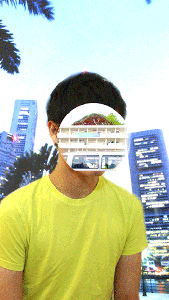
KS: By focusing on the gif the show does problematise the distinction between artist and audience, in which participation, openness and the ‘crafting’ of the image becomes key. However I have reservations about the use of the term Internet folk art, which could be construed as imposing a certain modernist logic on the discussion, burdening it with an analogue modeling of high and low culture. The research approach has been adopted precisely to avoid the trap of binary nominalism, and to problematise the tendency to shoe horn internet practices into the language of cultural studies and aesthetics.
MG: The Photographers’ Gallery was the first independent gallery in Britain devoted to photography and has been going since the 70s. It is the UK’s primary venue for photography and has been dedicated in establishing photography as an essential medium, representing its practice in culture and society. It seems that The Photographers’ Gallery is going through another transition. You have already mentioned how hybridized and networked the nature of future projects will be. So what kind of exhibitions and projects can we expect in the future?
KS: Because digital technology is not in itself a new photographic medium, but essentially a hybrid and converged set of technological practices, it raises many interesting problems, both theoretical and practical for a Gallery focused on photography. To the computer, the photograph is indistinguishable from the other binary blobs of data we used to call books, films and songs. The crisis of digitization and medium specificity now extends to the domain of the camera – Digital SLRs are coveted for their ability to shoot high quality digital video, and we turn to our mobile phones when we want to take snapshots. This is a very rich context for the programme to explore, and ideally the future projects will respond to the technical, creative and cultural languages of photography as produced by computer engineers, web developers, photographers, artists, networked communities, social scientists and other practitioners.
Our next show on The Wall (opening 13th July) features the practice based research of Susan Sloan into portraiture using motion capture and 3D animation techniques widely used in entertainment, medicine and the military. Her motion studies refer to the traditions and conventions of portraiture and the changing role of the camera as a recording device. At the same time, her work raises questions concerning the convergence of painting, animation, film and photography in the digital realm.
The future digital programme which will occupy different spaces and address various photographic practices including augmented reality, social media, electronic publishing, interactive media, mobile computing and synthetic imaging.
The Joy of GIF – the London Photographers’ Gallery’s new digital wall. Article by Wendy McMurdo.
http://www.foam.org/foam-blog/2012/may/photographers-gallery
Featured image: corporations are not people – the Overpass Light Brigade
Overpass Light Brigade in Tosa from Overpass Light Brigade on Vimeo.
Wisconsin has arguably been ground zero for union busting, DIY social movements, corporate takeover of government, and divisive – and often misinformed – political debate in the US for more than a year. And the Overpass Light Brigade (OLB), initiated by Milwaukee artists Lane Hall and Lisa Moline, have been a guiding light – literally – in how ground-up messaging and change can happen. Now a collaboration between many people, the OLB relies on an ever-widening community of activists, artists, thinkers, and do-ers for their “Signs of Resistance.” After a few rounds of local rye whiskey at Milwaukee’s Riverwest Public House Cooperative – one of the only co-op bars in the country – I did an email back and forth with OLB co-founder Lane Hall to find out more about what makes them tick, how they see themselves, and where the movement they are a part of is headed.
Nathaniel Stern: What is OLB? It feels more “struggle-” rather than “goal-” orientated, despite that its first mainstream recognition is in relation to a specific campaign. Can you talk a bit about its history: how it started, where it headed, and what it might become?
Lane Hall / Overpass Light Brigade (OLB): On November 15 of last year a rally was organized by grassroots groups in Wisconsin in order to kick off the Recall Walker campaign. It was to begin right after work, at 5:00 pm. Both Lisa Moline (co-founder of OLB) and I had been very active in what we now think of as the Wisconsin Uprising, and we asked ourselves the simple question, “How do we achieve visibility for graphic messages when it is dark at 4:30?” We began to tinker with off-the-shelf Christmas lights, and found some battery-powered strings of LEDs. We built our first sign, a 3′ x4′ panel that spelled out RECALL WALKER. When we arrived at the rally, we were immediately asked to be behind the speakers. That sign got on the Rachel Maddow and Ed Schultz show that evening, so we knew we had hit on something that afforded powerful visibility. That first sign is now, incidentally, in the archive of the Wisconsin State Historical Society.

We then proposed a second design challenge to ourselves: how do we get messages out to masses of people, since we can’t command the airwaves like Walker’s Koch-fueled campaign? Once we decided to go out on highway overpasses, we “scaled-up” the letters so that we could spell out words, refrigerator magnet style, one letter per 2′ x 3′ placard.
Our first night out was on an overpass in South Milwaukee. It was very cold, fairly miserable really, with freezing winds kicking up from the passing semi-trucks. We had a few fellow activists to help, and our idea was to bungee-cord the signs to the fence while we stood by. We were accosted by a right-wing nut, a Young Republican, who was vehement in his insistence that we were breaking the law by affixing the signs to the fencing. He ended up in a physical altercation with Lisa in his insistence to rip our signs off the fence as well as forcefully take Lisa’s video camera, since she was capturing his vigilante actions on video. When the police came, they did reiterate that nothing could be affixed to the bridges, though also supported our right to be there. From that night on, we realized that for OLB to work, we needed Holders of the Lights – one person per letter, as well as “spotters” for safety and a couple of people to take video and photos. This was a profound tweak of the original idea, in that it shifted our actions from mere signage to a form of witness or testimonial. It is very powerful to see one person per placard, positioned high above the highway, committed to the politics of physical presence.
We began to go out around the area, scoping out different overpasses, hooking up with different grassroots groups in Madison and Racine and Kenosha and Milwaukee. For about two months we took out RECALL to various locations, often getting hassled by people, questioned by cops, pushed to defend our rights to be out in these odd public spaces. We began to add letters and attract more volunteers who were attracted to our strange mix of Fluxus happening and focused message. RECALL WALKER, then 1% WALKER, then JOHN DOE (referring to an ongoing investigation into alleged campaign corruption when Walker was Milwaukee County Executive), then WALKER=JOBS FAIL and WALKER LIES and WALKER IS A CROOK, etc. We have always tried to index the message to what is breaking in the broader mediascape, so that there is resonance between multiple layers of information and our activist response.
Once Walker was officially recalled (he was “recalled to election”) things really picked up. We were getting invited to hold actions around the state – Madison, Fond du Lac, Portage, Appleton, Kenosha, Racine – and more and more people began to join us. The 2 hour overpass occupations began to take on a real festive quality, with people bringing food, making music, chatting, singing, chanting and enjoying the angry and happy honks from the freeway. Our messages expanded, and our Bridge Parties have become somewhat legendary, with anywhere between 40 and 120 people commonly showing up. We even have a bagpiper who often leads us on and off the overpass.
A big part of the success of OLB is its mediagenic quality. Photographs and videos have been distributed freely and widely, at times even virally. We’ve been highlighted in the NY Times, CNN, Time Magazine, the Milwaukee Journal Sentinel, countless blogs and Facebook sites too numerous to even itemize. Our Facebook “reach” was hitting 182,000, and I was getting constant queries about the project. Our community of activists is extremely diverse, which is one of the things I am most appreciative of. It is odd how powerful holding a sign over a highway is, how many conversations happen in the two hours of bearing witness, and how compelling the action remains for our volunteers.
We immediately went out the night after the disappointing results of the recall. I felt that what I call “essential visibility” was even more important for the progressive community. WE SHALL OVERCOME and SOLIDARITY FOREVER graced the bridges, and we subsequently began to help some striking workers in Milwaukee pizza factory with BOYCOTT PALERMO’S. Since the recall, I feel we have gotten stronger and deeper, no longer relying on the easy binary of our disaffection towards our tea-bagger governor. Our issues are bigger and broader, more national. We just went out in Madison with CORPORATIONS ≠ PEOPLE and 56 volunteers showed up, along with some projector-shine activists, live-streamers, and a phalanx of videographers. We have also taken out QUESTION AUSTERITY and are integrating it with a social media #questionausterity campaign. I see the synthesis of physical and virtual space as the future of OLB actions, as well as our growing ties with the Occupy movement.
NS: This is more than inventive campaigning or even creative activism, but protest art with heavy political, aesthetic, ethical, and technological implications. The Graffiti Research Lab was first to use high technology to ask, “Can any public space be a blackboard?” You take that as given, provide the chalk, and ask for important messages to be broadcast on said blackboards. I’d like for the both of you to write a bit about your practice as artists, as activists, where they are one and the same, and where sometimes they differ.

OLB: The Graffiti Research Lab is a continued inspiration for us in terms of their open-source ethos, and their bold pushing at the “public” aspect of “public space.” I have great admiration for what they accomplished, yet have always felt frustrated that their messages generally stayed within existential parameters. That is, their presence in urban space was implicitly political, but their projections were generally, “I exist” with variations on the theme such as “Fuck you!” However, the way their events brought people together in the streets is also noteworthy. OLB has achieved some of these same dynamics, though with very directed and explicit political messaging. We are a fluid mix of relational aesthetic, Fluxus happening, street party and progressive messaging, all part of an inherently ethical practice. We think of ourselves as “the people’s bandwidth,” having found an open venue that takes a lot of dedication but only a small outlay of capitol, which is intrinsically public to thousands of passersby.
Our own work has been collaborative for a long time. Before the Wisconsin Uprising, our art – often about environmental issues and animal subjects – was implicitly political, but rarely pushed the boundaries of sanctified institutional spaces. Once the Uprising began, we got very involved with activist work, and took our creative efforts to the streets. We were inspired, set up a PAC called The Playground Legends with some other activists, and began working within some of Milwaukee’s African American communities on voter education and Get Out The Vote campaigns. We set up “parties in the parks” for neighborhood groups, and used these relational activities to help create cohesion around a political purpose. This was exhausting and finally not sustainable for us, but some larger groups such as Wisconsin Jobs Now emulated our inventiveness and have really made a difference in spite of the Right’s coordinated campaigns of disenfranchisement.
After working with this PAC, and struggling with the official requirements of a 501C3 and meetings with minutes and budgets and fundraising and reports, we chose to make OLB as flexible and open as possible. We are a loose affiliation of activists who show up on bridges and hold signs. It is very simple. Anyone can join. All ideas are welcome for consideration. Our community of activists is really the heart and key to sustainability with OLB. Most of them don’t care whether this is art, or what the cultural precedents might be. All of them value this odd form of engagement, where they can see a beautiful and directed message reflected back through social media, and be a part of a much larger – and historical – emergence of a progressive political movement.
NS: Who do you want to follow your lead? Who do you want to help OLB progress to more innovative interventions? How can we help you help us?
OLB: We freely share the instructions for making the signs. They are very easy in concept, very DIY, and need only basic wood shop fabrication skills, akin to stretching canvasses or making a woodcut print. However, each sign does take a lot of concentrated construction, which can discourage some who have wanted to create their own. So far, we have 3 different chapters that have taken to the bridges: OLB-Fox Valley, OLB-Dane County (both in WI) and OLB-Harrisburg. We’ve also seen other iterations, such as a Madison based “Sign Brigade” doing daytime roadside actions. I see that OLB has a function as a model of empowerment, as well as the joy (or anger) one gets from seeing a message “done up in lights.” One thing that hasn’t happened yet is an ongoing series of “hacks” that extend and expand the idea. The off-the-shelf lights get expensive. Could someone figure out how to make battery powered (not big battery + inverter, but lightweight AA batteries) LED light strings so that we could build our own? How about other variations? This would be great to see, especially now that the Graffiti Research Lab’s open inquiry with LEDs seems a thing of the past.
NS: What have been some favorite moments from the bridges?
It always amazes me when some random stranger pulls off the highway and comes to find us. Sometimes, especially at first, this would mean trouble, in that aggressors would want to direct anger at us. But one night in the bitter cold weather of January, an African American man came up to the bridge, told us he saw us and wanted to give us a gift, and offered each Holder a beautiful knit hat. He was a salesman of sports clothes, and had a lot of hats. We each left that night with a new Milwaukee Bucks hat!
Another time, just a few weeks ago, two women – an older woman and her adult daughter – came up to the overpass. Both were public school teachers. The teachers have been so demonized in Wisconsin – it is both ridiculous and shameful, but it obviously works to divide us, and as obviously takes its emotional toll on these new “enemies of the state.” The older woman exclaimed that they were “so grateful to see us out there doing this” and she burst into tears. There were lots of hugs and they hung around for awhile, held a couple of letters, and left. It was very moving, as a lot of our Holders are themselves teachers.
We also hosted the famous “Nuns on the Bus” tour – the politically progressive group of Sisters who are going around the midwest to decry the austerity budgets of Paul Ryan and the Republicans. It was amazing when their bus pulled up by the overpass, and these elderly activists (along with the powerful Sister Simone) approached the bridge and saw the QUESTION AUSTERITY message we had created just for their tour. There were 96 people on the bridge that night, and they all sang happy birthday to one of the Sisters since it was her 72nd celebration that day. That was a wonderful event, and a great example of diverse activist communities coming together based on these joyful actions.

I could go on and on. Each action, each Bridge Party, is a whole narrative – interactions with police, with passersby, with neighbors both supportive and critical, and now and then with aggressors who have busted out our car windows or tried to shut us down. But it is all powerful, all a microcosm of the rifts in our country. The bridge is a forceful metaphor beyond its commanding physical presence over the geospatial distribution network function of our highways. It works both linguistically and architecturally, and affords a curious perch for our loose affiliation of committed brigadiers.
NS: How can we make our own stuff?
OLB: Check out our new site at http://overpasslightbrigade.org/
You can also find “noise of rain” posts on the Daily Kos site
http://www.dailykos.com/user/noise%20of%20rain
Sign up: ale[at]furtherfield.org
See images of the walk on Flickr.
Public exploratory radiation walk around Finsbury Park, measuring mobile phone radiation levels and discovering what type of radiations we are exposed to on a daily basis. As we walk, we will unravel a parallel, hidden story of the local area along with technical data and possible medical effects of the radiation. Participants will measure radiation levels, GPS positions and marked levels on a large map of the area, creating a collaborative artwork (poster sized map of local radiation) to be made available for display as part of the exhibition after the event.
Participants are encouraged to listen to the sounds we will be hunting for (GSM, 3G, Tetra) here.
Dave Miller
Dave Miller is a South London based artist and currently a Research Fellow in Augmented Reality at the University of Bedfordshire. Through his art practice Dave draws out the invisible forces that make life difficult. His work is about caring and being angry, as an artist. His art enables him to express feelings about the world, to attempt to explain things in a meaningful, yet subjective way, and make complexed information accessible. Recurrent themes in his work are: human stories, injustices, contentious issues and campaigning. Recently he’s been very bothered by the financial crisis.
+ Finsbury Park Radiation Walk is part of Invisible Forces at Furtherfield Gallery.
+ More Invisible Forces events.
See images of the event on Flickr
Olga P Massanet and Thomas Aston have built a custom made VLF antenna to monitor ionospheric disturbances caused by solar storms. For this exhibition they invite makers and thinkers to participate in a creative sprint and come up with ideas on how to make these disturbances felt. Whether it’s a device, a visualisation, a sonification, or a poem, participants will design interfaces to tune into some of the most powerful forces that permeate our world.
In a matter of 5 hours participants will experience what the artists have been through in the past 5 months. In teams, they’ll get to build an antenna, tune it, collect the data and conceive or experiment with actual or possible interfaces to make solar storms ever more tangible!
Olga P Massanet
Olga is a media artist and researcher working as co-editor on the Furtherfield website and developing and delivering workshops for the Zero Dollar Laptop project and Furtherfield’s Outreach programme. Olga is currently pursuing a practice-based PhD at Goldsmiths. Her research project looks into assemblages of sunlight, human bodies and machines. She is particularly interested on subtle modes of communication across bodies of radically different nature. She looks at the ways in which electronic circuits, computational systems, endocrine processes and neurological happenings intermingle. The tools she develops are speculations about the undercurrents of body communication.
Thomas Cade Aston
Thomas is an emerging sound artist and electronic musician based out of London, UK and Toronto, Canada. His composition, production and performance work explores the dark and meditative fringes between technical, cerebral and somatic experience. Recent work includes ambient electronic compositions for Space Video (Turbulence/Revised Projects– Vancouver), an interactive soundscape for A Place to Reflect (Nuit Blanche-Toronto) and a highly anticipated electronic A/V performance at NewFormsFestival 11 (Vancouver). Thomas is busy at play in the spectrum, pursuing an MA in Interactive Media at Goldsmiths College, UK and readying for the launch of his debut LP Greenwich Mean Time with Hybridity Music this summer.
+ Technologies of Attunement is part of Invisible Forces at Furtherfield Gallery.
+ More Invisible Forces events.
3 Keys – The River Oracle by the Hexists is the opening act of the Moving Forest 12 hour performance.
+ Listen to the sounds of Act 0 ‘Omen’ for the Moving Forest London 2012
1. Introduction ‘Output 1’
2. Omen Section 1 ‘Output 3 and 4’
3. Omen Section 1 ‘Output 5’
+ And download the score for the Hackney Brook.
Cybernetic systems and game theory are about anticipating and influencing human behaviour using algorithmic code, databases, social media etc – the industries of data-mining, data profiling and data protection can be said to be the new ‘magic’ by which biopolitical control of our bodies and identities is maintained.
3 Keys – The River Oracle with The Hexists is a game of chance and divination in association with The Moving Forest, Act 0. It attempts to invoke the relationship between the divinatory functions of our contemporary ‘influencing machines’ (cybernetic systems and game theory using data-mining, data profiling and data protection) and traditional magical ones, creating new machines in the process. Using tools such as cards, dowsing, stick throwing to interpret phenomena in the landscape, historical and current, ‘readings’ can be cast, allowing associative action, language and thought to determine what might happen in the future, to create a path, an artwork.
In 3 Keys (version 3), participants will follow the Hackney Brook, an old subterranean river that begins near Finsbury Park and ends up in the River Lea near the site of the Olympics, using different exercises to interpret the landscape and cast readings. We will ‘mark’ the route along the way with objects and stories and other inscriptions. The river is the oracle and we are the transmisson. The documentation and divination tools will be made available for display in the exhibition after the event.
IMAGES FROM THE WALK ON FLICKR
Rachel Baker
(The Hexists)
Rachel Baker is a network artist who collaborated on the influential irational.org. Her art practice explores techniques used in contemporary marketing to gather and distribute data for the purposes of manipulation and propaganda. Networks of all kinds are “sites” for Baker’s public and private distributed art practice, including radio combined with Internet (Net.radio), mobile phones and SMS messaging, and rail networks.
Kayle Brandon
(The Hexists)
Kayle Brandon is a inter-disciplinary Artist/researcher, whose work is sited within the public, social realm. She predominantly works in collaborative and collective fields; a working method which informs much of her ethos around the making of art. Her main areas of interest are in the relationships between the natural and urban worlds and Human/Non-human relations. She investigates this field via physical intelligence, provocative intervention, observation, self-guided exploration and collective experiences.
First presented at Transmediale.08. Berlin 2008, Moving Forest London maps an imaginary castle and a camouflaged forest revolt onto the hyper-playground of the London metropolis on the eve of Olympics 2012. Presented by a temporarily assembled troupe AKA the castle, Moving Forest brings together diverse visual/sonic/electronic/digital/ performance artists along with writers, walkers, coders, hackers, mobile agents, twitters, networkers and the general public to realize a contemporary version of a classic play.
http://www.movingforest.net/
DOWNLOAD A PRESS RELEASE HERE
+ 3 Keys – The River Oracle is part of Invisible Forces at Furtherfield Gallery.
+ More Invisible Forces events.
Featured image: “All Hail Damien Hirst!”, Tamiko Thiel, 2012. Turbine Hall, Tate Modern, London.
Interest in Damien Hirst and his commercialized, celebrity status is well known. So when we heard that Tamiko Thiel was making the artwork “All Hail Damien Hirst!”, we were immediately curious. Hirst is an extremely rich individual with powerful allies within wealthy, traditional art establishment circles. This includes Charles Saatchi, and commercially dedicated art mags and art institutions whom have all successfully helped in marketing his particular brand as part of their own economic strategy. With this in mind and acknowledging the potential risk in satirizing a well known art celebrity we thought it was a good idea to interview Thiel about her ideas and experience on the project?
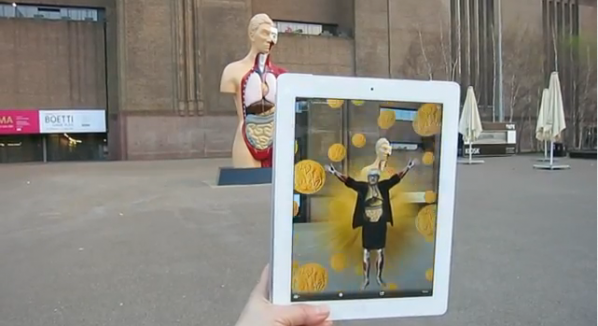
MG: Many are curious about your new augmented reality project “All Hail Damien Hirst!”. It is an art installation and intervention. Why have you chosen to create an artwork aimed specifically at him, during his retrospective exhibition at the Tate Modern?
Tamiko Thiel: As a visual artist my projects start with having a strong image in my mind’s eye that compels me to pursue the project further. When I heard of the retrospective at the Tate I immediately had an image of Hirst – depicted in a style relating to his own working methods – hovering in the vast space of the Tate Modern Turbine Hall. On findng out that the space was not going to be used except for the small room housing his diamond skull, I saw an opportunity to give visitors an experience that would utilize the space beautifully, compliment his own work and bring the contradictory feelings that many have about him and his work into sharper focus.
In my own work I often draw on the power of religious imagery. This aspect of Hirst’s work, and also his themes of the body and death, are very compelling to me. On the other hand, he plays a master hand at making the art market dance to his tune. I find the market value of his carefully ordered spot paintings, for example, in marked contrast to the artistic power of Yayoi Kusama’s spot obsessions, which were exhibited probably not by coincidence at the same time at the Tate Modern.
To top it off, while flipping through a United Airlines onboard magazine I chanced upon an image depicting the value of Hirst’s artworks as an exaggerated – and spotted – version of the movement of the stock market:

I wanted to make a work that addressed multiple issues surrounding Hirst as a person, as an artist and as a force in the art market at a time of extreme tension in the world’s financial markets. I knew however that Hirst is very litigious, so I was careful to use none of Hirst’s actual artworks, so I do not infringe on his copyright!
I had done an earlier augmented reality work, Reign of Gold, as part of the AR Occupy Wall Street project. In this work, viewers all over the world can chose the site at which to view the piece on their smartphones, and then see an animated rain of gold coins superimposed over the live camera view of their surroundings. I have photos of this work against the New York Stock Exchange, the Bank of England in London, TEPCO in Tokyo – the company that brought us the Fukushima nuclear disaster – and other choice sites around the world. You will see a clear visual relationship between the rain of gold coins and Hirst’s spot paintings, which many say are destined to go through a similar boom and bust cycle as are the world financial markets.
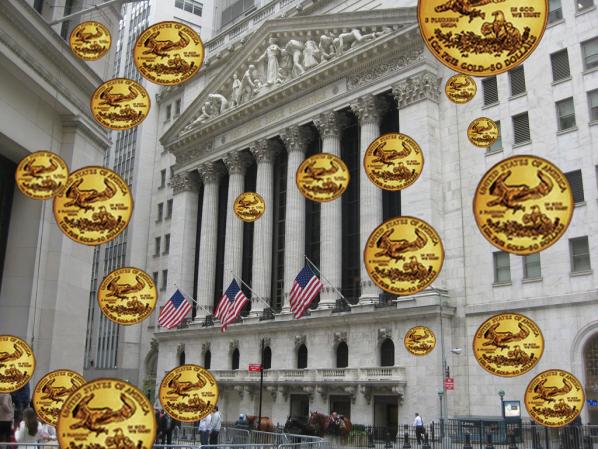
If I was a painter I would’ve gone off and made a painting, and that would have been the end of that. Since I work with augmented reality however I could place the image in and around the Tate Modern itself, the very site of Hirst’s exhibition. This puts a whole different spin on the artwork, as having an artwork “in” a prominent arts venue is seen as a form of “canonization” in the art world, even if the artist places the work there by him- or herself, as did Banksy.
This brought in yet another level to the project, as the work functions now not only visually, but by dint of its location also questions the system by which the art world consecrates artists and artworks. What does the location of an artwork mean, if every artist decides for herself where to place the work? Walls cannot keep us out, nor can walls keep us in. Even Hirst, who is known as a control freak, cannot exercise control over augmented reality.
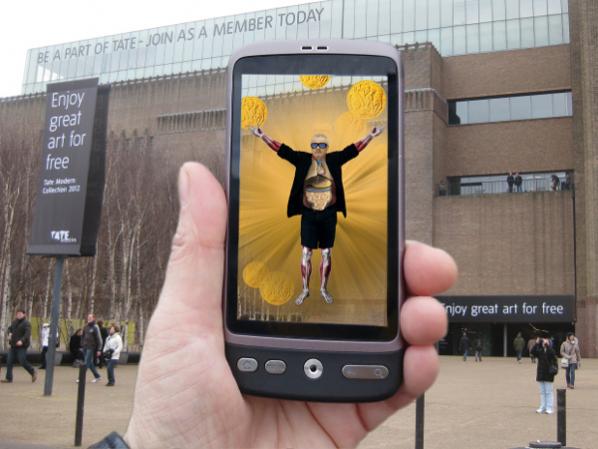
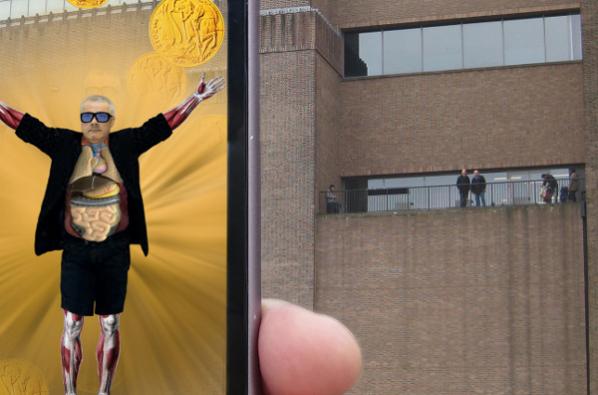
MG: You visited the Tate Modern and interacted with the public. What kind of responses did you receive by visitors to the intervention?
TT: Delight! Most had come to see Hirst’s exhibit with contradictory feelings about the man and his art because of similar issues to those that had motivated me to make my artwork originally. They were delighted at how my artwork spoke to these feelings while leaving the conclusion open for the viewer. They liked the spatiality of the piece, how it surrounded them and filled the cavernous empty space of the Turbine Hall when viewed inside the Tate Modern, and reflected on Hirst’s “Hymn” sculpture when viewed outside by the river. There was also fascination about this new technology which none had ever seen before, and of course some puzzlement about how it worked.
MG: What message are you hoping to communicate with this interventionist project?
TT: What attracts my attention as an artist are topics that provoke contradictory or unresolved emotions in myself. By their very nature I can’t answer these topics with a simple message. Instead I try to create striking images and visual/kinesthetic experiences that evoke the contradictory feelings I have myself, in the hopes that my works can help focus or sharpen the issue, or at least provoke dialog in those who view them.
To cite a different work from my art practice: even in “Shades of Absence,” in which I surround anonymous golden silhouettes of censored artists with terms of censorship, I am myself of two minds about many of the artworks I cite in the linked website on censored artists. I made Shades of Absence as an intervention into the 2011 Venice Biennale, at a time when Ai Wei Wei was imprisoned by his own government. In his case I am strictly against the censorship of him as an artist and a person, but in many other cases I have cited, I myself could not say I would always be against censorship when it could incite hate and physical violence against others.
MG: Is it mainly Hirst you are critiquing here or is he representative of something bigger in art and its culture that you are questioning?
Hirst is the British Jeff Koons! Every era and every country finds such a figure to represent the eternal tension between art as a sublime personal experience and art as the magnet for glamour and status and money. I wonder if it was any different for the artists of the cave paintings?
MG: In the publicity for the project, it says ‘Augmented Reality is the Street Art of the 21st Century!’. Could you elaborate what this means to you, and share with us some examples of other interesting works in this field?
TT: In this regard, to be frank I think the work of my cyberartist collective Manifest.AR is the leading work in the field at this moment, perhaps because we are all so diverse and cross-fertilize each other!
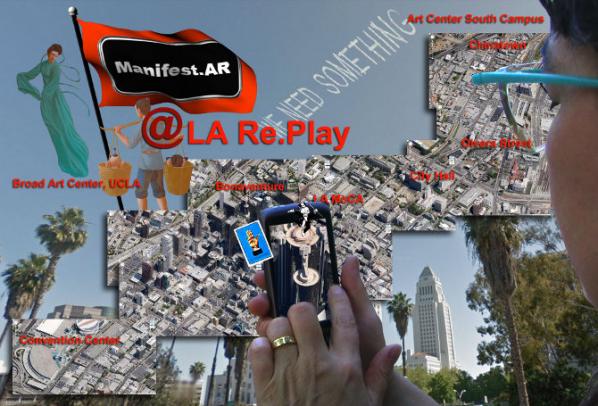
Of course augmented reality is not as visible as a graffiti on the side of a building – but it also cannot be removed, and we can place them wherever we want without fear – yet – of arrest or fines. Also, the smartphone or mobile tablet is becoming an extension of the self, and our primary interface with the extensive virtual society in which we are embedded. It is how we will communicate, how we will find information, how we will share our social space with everyone who is not standing in exactly the same room at exactly the same time, it will become our entertainment device, our payment device and god forbid our identification device. You do not go to someone’s house to look through their photo album, you go to their Facebook site. Why shouldn’t you start finding their thoughts and expressions as augmented reality images around you in space?
I just successfully co-wrote a major Rockefeller Foundation grant to help residents of a very poor area of a major city put up their own history and artwork in their neighborhood using augmented reality. I can’t say much about it as the official publicity has not yet been released, but the organization I wrote it for is convinced that in a couple of years, more of their youth will look at art on smartphones than in museums and art galleries. Will the middle and upper classes lag behind, because they think the only art worthy of note is hanging on gallery walls?
All Hail Damien Hirst! An augmented reality installation celebrating Damien Hirst at the Tate Modern.
http://www.allhaildamienhirst.com/
“Reign of Gold” – part of AR Occupy Wall Street
http://www.mission-base.com/tamiko/AR/reign-of-gold.html
Tamiko Thiel – Online Portfolio
http://www.mission-base.com/tamiko/
Tamiko Thiel is a media artist developing the dramatic and poetic capabilities of various forms of virtual and augmented reality as media for exploring social and cultural issues.
A founding member of the cyberartist group Manifest.AR, she participated in the pathbreaking augmented reality exhibit “We AR in MoMA,” an uninvited guerilla takeover of MoMA New York. Videos of Thiel’s “Art Critic Face Matrix” were featured in articles in the New York Times and on WNYC (National Public Radio). In 2011 she led the Manifest.AR Venice Biennial AR Intervention, placing her work series “Shades of Absence,” on censorship in the visual arts, in the Venice Giardini and in the German National Pavilion (which won the Golden Lion Award for best national pavilion). This led to an invitation to participate in the ISEA2011 exhibition UNCONTAINABLE, an official parallel program of the Istanbul Biennial, where she placed her artwork series “Captured Images” into the main biennial exhibition
The insights of American anarchist ecologist Murray Bookchin, into environmental crisis, hinge on a social conception of ecology that problematises the role of domination in culture. His ideas become increasingly relevant to those working with digital technologies in the post-industrial information age, as big business daily develops new tools and techniques to exploit our sociality across high-speed networks (digital and physical). According to Bookchin our fragile ecological state is bound up with a social pathology. Hierarchical systems and class relationships so thoroughly permeate contemporary human society that the idea of dominating the environment (in order to extract natural resources or to minimise disruption to our daily schedules of work and leisure) seems perfectly natural in spite of the catastrophic consequences for future life on earth (Bookchin 1991). Strategies for economic, technical and social innovation that fixate on establishing ever more efficient and productive systems of control and growth, deployed by fewer, more centralised agents have been shown conclusively to be both unjust and environmentally unsustainable (Jackson 2009). Humanity needs new strategies for social and material renewal and to develop more diverse and lively ecologies of ideas, occupations and values.
In critical media art culture, where artistic and technical cultures intersect, alternative perspectives are emerging in the context of the collapsing natural environment and financial markets; alternatives to those produced (on the one hand) by established ‘high’ art-world markets and institutions and (on the other) the network of ubiquitous user owned devices and corporate social media. The dominating effects of centralised systems are disturbed by more distributed, collaborative forms of creativity. Artists play within and across contemporary networks (digital, social and physical) disrupting business as usual and embedded habits and attitudes of techno-consumerism. Contemporary cultural infrastructures (institutional and technical), their systems and protocols are taken as the materials and context for artistic and social production in the form of critical play, investigation and manipulation.
This essay presents We Won’t Fly for Art, a media art project initiated by artists Marc Garrett and I in April 2009 in which we used online social networks to activate the rhetoric of Gustav Metzger’s earlier protest work Reduce Art Flights (from 2007) in order to reduce art-world-generated carbon emissions... Download full text (pdf- 88Kb) >
Published in PAYING ATTENTION: Towards a Critique of the Attention Economy
Special Issue of CULTURE MACHINE VOL 13 2012 by Patrick Crogan and Samuel Kinsley.
Sign up: ale[at]furtherfield.org
Saturday 23 June 2012, 1-5pm
Summer Board Games and Picnic with Class Wargames and Kimathi Donkor
Join us for a day of debate around the leader of the Haitian Revolution, Toussaint Louverture, now regarded as an important icon of anti-slavery struggles. Class Wargames interviews the artist Kimathi Donkor who created the history painting Toussaint Louverture at Bedourete to mark 200 years since the independence of Haiti. The event will kick off with a picnic in the park and continue with an afternoon of collective playing of Guy Debord’s The Game of War, a Napoleonic-era military strategy game where armies must maintain their communications structure to survive – and where victory is achieved by smashing your opponent’s supply network rather than by taking their pieces.
In a short film by Ilze Black, Dr Richard Barbrook and Fabian Tompsett of Class Wargames interview Donkor about the work. Alex Verness from Class Wargames will be documenting the day by taking xenographs of participants.
IMAGES FROM THE TALK ON FLICKR
Saturday 30 June 2012, 1-5pm
Summer Board Games and Picnic with Class Wargames
Join us for a talk about gaming the 1791-1804 Haitian Revolution led by Richard Barbrook and Fabian Tompsett of Class Wargames. The event will kick off with a picnic in the park and continue with an afternoon of collective playing of Richard Borg’s Commands & Colors, a Napoleonic-era military strategy game.
IMAGES FROM THE EVENT ON FLICKR
Class Wargames
Class Wargames is an avant-garde movement of artists, activists, and theoreticians engaged in the production of works of ludic subversion in the bureaucratic society of controlled consumption.
The members of Class Wargames are Dr. Richard Barbrook, author and senior lecturer in the Department of Politics & IR at the University of Westminster; Rod Dickinson, artist and lecturer at University of the West of England; Alex Veness, artist and co-founder of Class Wargames;Ilze Black, media artist and producer; Fabian Tompsett, initiator of London Psychogeographical Association and author; Mark Copplestone, author and figure designer; Lucy Blake, Software developer; Stefan Lutschinger, lecturer, artist and researcher; and Elena Vorontsova, World Radio Network and journalist.
Kimathi Donkor
Kimathi Donkor lives and works in London. He attained his B.A. at Goldsmiths and an M.A. at Camberwell College of Art, both in Fine Art. In 2011 he received the Derek Hill Award painting scholarship for the British School at Rome; and, in 2010, his paintings were exhibited in the 29th São Paulo Biennial, Brazil.
+ Summer Board Games and Picnic is part of Invisible Forces at Furtherfield Gallery.
+ More Invisible Forces events.
So Alan Turing was born 100 years ago today. More or less every esteemed field of technological discovery has been plugging certain events and exhibitions surrounding the Turing centenary this week, each one steadily demanding a greater recognition of Turing’s astonishing legacy and achievement. There have been articles aplenty; some seeking to identify Turing alongside other persecuted scientists. Others argue that Turing’s achievements should be listed alongside calculus and relativity – perhaps something which should have been common-place anyway given the precarious computer age which surrounds us – (rather bewilderingly, despite the increased media coverage the UK Government are still failing to issue a full pardon for Turing’s shocking treatment in the last two years of his life).
It’s a testament to Turing’s fascination with nearly everything that 76 years since his first major paper, there’s still so much to write about his work. Expect this week to offer more events and glimpses into these projects: Neuro-computational studies into the functional basis of cognition. The ever forward march for genuine artificial intelligence. New methods of simulating the complexity of biological forms nearly 60 years after Turing’s paper on the chemical basis of morphogenesis (indeed this area of complexity theory is now an established area of major research). The slippery mathematical formalist discoveries which define what can or cannot be computed. And not forgetting key historical developments in cryptography, perhaps the field which Turing is most respected for. Moreover, Turing wasn’t just one of the greatest mathematicians of the 20th Century, but also one of the greatest creative engineers; someone who wasn’t afraid of putting his ideas into automation, through the negotiation of materials.
So for the positivist sciences and technological engineers, Turing’s curiosity continues to bequeath low hanging research fruit ready to be picked. But what of the arts and humanities? How have they contributed to the Turing centenary? How are they influenced by Turing?
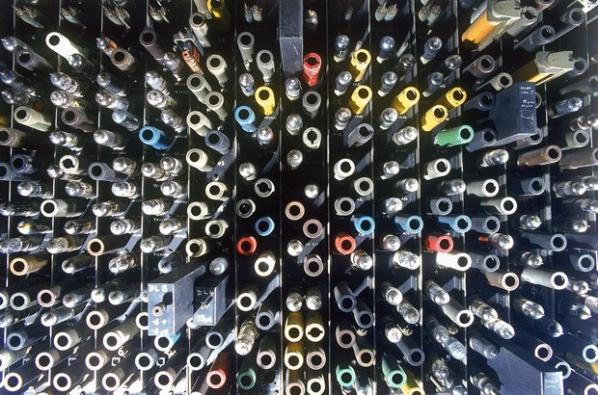
Indeed, its always more deeper than is actually realised. Clearly, in Analytic Philosophy where cognitive science is dominant, Turing’s legacy continues to elevate epistemological, ethical or moral questions about the nature of the human mind – with many offering high bids on the future foundation of a computable brain, by reducing the cognitive understanding into its putative evolved material constituents (see Daniel C. Dennett’s recent article in The Atlantic) – Others completely vilify the idea that consciousness could ever be fully engineered. Others speculate (naturally).
In the arts, a special Alan Turing centenary committee has been set up to fund art projects which deal with Turing’s legacy in various ways. The “Intuition and Ingenuity” exhibition in particular features work by Ernest Edmonds amongst others. In a more direct link, the mathematician Robert Soare has even argued for the existence of a pesudo-cryptic ‘Turing Renaissance’, establishing a link between classical recursion theory and the classical art of the Italian High Renaissance (which has more than a potent ‘Da Vinci Code’ whiff about it).
Some academics have chosen to focus on the biographical details of Turing’s own short life. In particular Homay King (and I only found out about this in conversation last week) has offered key insights into Turing’s research methods using Queer Theory, not simply because Turing was openly gay and speculated on thought experiments involving gender, but because Turing wanted to understand peculiar sociabilities of ambivalent miscommunication. Evan Selinger has written a recent article on how social scientists are using the “Turing test” to observe and understand deception in social groups. And also influenced by these same deceptive qualities, Prajwal Ciryam clarifies its influence on psychopathy and predicting when a psychiatric patient should be released. Here, difficult questions emerge as inspired by the difficult questions Turing himself raised, even if the fields wildly diverge from his own.
But here’s a question – could the arts and humanities move further into Turing’s legacy than admirable commentary on specific biographical revelations of his life, or questions which bother cultural ambiguity?
Perhaps we should ask whether the Turing Centenary will actually convince the humanities and the sciences to attentively read Turing’s work? Forgive the disingenuous patronising structure of the question; I clearly realise that people have read Turing’s work, especially his most famous and readable article, Computing Machinery and Intelligence published in 1950. But think back, have you actually read it?
Written off the back of a report done for the National Physical Laboratory between 1948-1949, Turing’s succinct article famously speculated on machinic intelligence, as well as launching the infamous Turing Test (the moniker “Turing Test” is a bit of a misnomer, Turing himself called it an imitation game). And yet, it strikes me as absurd that more hasn’t been written on how strange, bizarre, hysterical, paradoxically informal and wonderfully written this text is, as a text. Especially since it is a text which is often considered ‘scientific’ and ‘academic’ as opposed to ‘mere literature’.
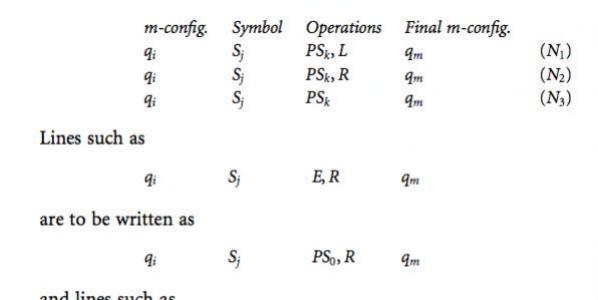
In a 2008 article, which again, no-one seems to have read (‘Powers of the Facsimile: A Turing Test on Science and Literature‘, written for an edited collection on the novelist Richard Powers) – Bruno Latour makes this strategic point about the ambivalent qualities of Turing’s 1950 article. For him, Turing’s text contains not clear analytic rigour, but “metaphors, tropes, anecdotes, asides and self description”; features of what he calls “matters of concern”. Turing considered the idea of machines having intelligence through the “most bizarre, kitschy, baroque text ever submitted to a scholarly journal“. Latour even jokes that Alan Sokal would no doubt have interpreted it as a hoax. It’s no wonder that Turing’s friend and logician Robin Gandy said of the essay that, “it was intended not so much as a penetrating contribution to philosophy but as propaganda […] He wrote this paper – unlike his mathematical papers – quickly and with enjoyment. I can remember him reading aloud to me some of the passages – always with a smile, sometimes with a giggle.“
“The problem” Latour states, “is that people never read.” Well, by ‘reading’ Latour means that the analytic sciences didn’t really pay attention to what Turing is saying. Even worse, some just ignore the deliberate ambiguity of Turing’s text by reading through it as a transparent window onto whether the mind is computational in nature or whether machines can actually think or not (a question which in the same article and subsequent lectures, Turing considered “too meaningless to deserve attention”, as well stating that his aim wasn’t to give a definition of thinking).
This, for Latour, begs a different type of Turing test; can one distinguish between a Richard Powers novel of realist literature (an exposition of which is given in the first half of the paper) and the scientific realism of Turing? If one is sufficiently fooled, then Latour “will have at least indicated that matters of concern might be best accessible through the joint inventions of literature and science.” And it’s here where the humanities and the arts should claim Turing as a kindred spirit, for Latour’s test terminates any significant difference between “an important scientific text and an important novel” precisely insofar as one cannot distinguish “dealing with demonstrations while the other deals with rhetoric, one dealing with proofs while the other deals with stories[…]” Turing had the nerve to slice and dice allusive, eloquent and creative persuasion together with an empirical understanding of electrical computation. I doubt various scientific proponents of the Turing centenary would take this significance with much seriousness, but I’m convinced artists and literary scholars would do.
So this begs a question, which should resonate loud and clear on Turing’s 100th birthday. What happens when we treat Turing even more seriously; not just as a mathematician, engineer or scientist, but also as a cryptic creative thinker and writer? What happens if we follow his words and not just his conclusions (although certainly the conclusions are worth following, if not extensively by others).
One element which stands out time and time again, is how much Turing was influenced by the reality of unproved conjecture rather than designating reality through deductive proof. This isn’t a quirky coincidence. Turing’s negative solution to Hilbert’s decision problem in his equally famous 1936 paper On Computable Numbers – the paper which conceived the computer as an abstract mathematical concept – showed that there was an intrinsic paradox at the heart of automation. It’s impossible to systematically predict what a certain function will do before you execute it. So in Turing’s 1950 article, we shouldn’t be at all surprised when he espouses the following point;
“The popular view that scientists proceed inexorably from well-established fact to well-established fact, never being influenced by any unproved conjecture, is quite mistaken. Provided it is made clear which are proved facts and which are conjectures, no harm can result. Conjectures are of great importance since they suggest useful lines of research.” Computing Machinery and Intelligence, p.49.
Another point of semblance is how uninfluenced Turing was by the work of his peers. Max Newman one said of him that it was a “defect of his qualities that he found it hard to use the work of others, preferring to work things out for himself.” I very much doubt it was a defect. To consider it so, probably undermines what was so particular and unique to Turing’s creativity. Turing wasn’t persuaded by other interpretations of computing machines other than his own personal tinkering, and this leads to some important insights worthy of aesthetic concern.
For instance in a surprisingly frank passage, Turing lays bare how little knowledge he has when it comes to speculating on the constructions he himself had constructed.
“A better variant of the objection says that a machine can never “take us by surprise.” This statement is a more direct challenge and can be met directly. Machines take me by surprise with great frequency. This is largely because I do not do sufficient calculation to decide what to expect them to do, or rather because, although I do a calculation, I do it in a hurried, slipshod fashion, taking risks. […] These admissions lay me open to lectures on the subject of my vicious ways, but do not throw any doubt on my credibility when I testify to the surprises I experience.” Computing Machinery and Intelligence, p.56-57.
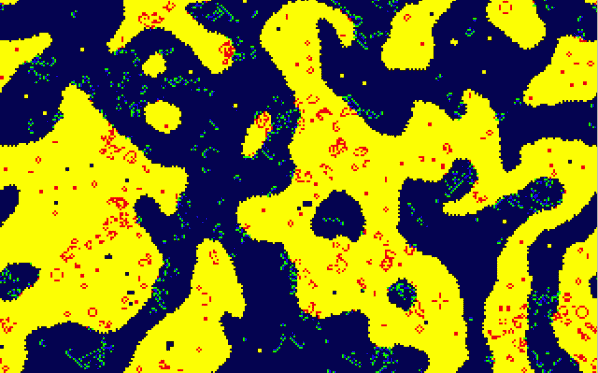
If Turing – the godfather of universal computation – had little knowledge on the output of his own discovery, what does this say about us now? (what does it say about Google’s own recent tribute?) Turing’s famous article lays bare a different interpretation; that he certaintly didn’t envisage computers as simple communication tools for human whims, but did he indirectly expose automatons with agency. What the hell is an automaton?
How he came to define what this agency is, was brutally cut short. However it’s clear from his work on morphogenesis (which Turing began at the same time as his theoretical forays into machinic thought) that some preliminary form of complexity theory was the way forward. It certainly undermines the positivist wing of artificial intelligence research which invests in some predictable form of knowledge where machinic intelligence can only be ‘known in advance’ when it passes for sentience. Do real world formal language systems already contain the type of surprising ambivalence which Turing noticed? Furthermore, do machines experience this level of ambivalence between each other themselves? This is a question which the transparency of analytic rigour and scientific provability would remove for being undisciplined. Turing’s own words suggest otherwise.
In a subsequent lecture broadcast on BBC Radio in May 1951 called “Can Digital Computers Think?“, Turing elaborates on this further using some exquisite metaphors and analogies;
“It is not difficult to design machines whose behaviour appears quite random to anyone who does not know the details of their construction. Naturally enough the inclusion of this random element, whichever technique is used, does not solve our main problem, how to programme a machine to imitate a brain, or as we might say more briefly, if less accurately, to think. But it gives us some indication of what the process will be like. We must not always expect to know what the computer is going to do. We should be pleased when the machine surprises us, in rather the same way as one is pleased when a pupil does something which he had not been explicitly taught to do.”
We have here, in the pangs of its birth, a self-confessed weird quality to the construction of computing in its preliminary stages. It’s this otherness, notably absurd quality to the agency of computing which the humanities (and especially the digital arts) could re-appropriate for it’s own unpredictable ends.
And to some extent this hardly exists as new territory for practising artists who began working with early structural computing systems from the late 1960s – the surprising reality of deterministic rules. I’m sure many artists and programmers, especially those who constantly negotiate their way through complex compilers, stack libraries, code, bugs, glitches and information loss, testify to the same surprises that Turing experienced. For it was Turing who originally suggested that writing and mechanism were almost synonymous.
While I’m sure no aficionado of the Turing Centenary would refute our own particular conjecture, they wouldn’t admit to a conflict between the rhetorical primacy of Turing’s text against the dominant and subsequent scientific uptake. For while the sciences of predictability continue to locate Turing’s legacy as their own, they leave open the chance for the humanities to account for the unpredictable qualities of Turing’s legacy which are ignored. I look forward to the next 100 years.

“Human Readable Messages_[Mezangelle 2003-2011]” is a book published by Traumawien containing almost a decade of Mez Breeze’s “Mezangelle” writings. Mezangelle is hand-crafted text with the aesthetics of computer code or protocols. What marks Mezangelle out is how deep its use of those aesthetics go and how effectively it uses them.
Computer programming languages have their own logic, and it is not captured by holding down the shift key and bashing the top line of the keyboard to add what looks like a cartoon character swearing or random line noise to text. It’s true that programming languages can look incomprehensible to the uninitiated. This Perl code:
y/A-Za-z/a-zA-Z/
will swap the case of lower and upper case English letters. But the conciseness of this notation hides a clear informational structure only in the same way that mathematical or musical notation do.
Likewise the markup language HTML that this article is written in:
<p>looks “<em>gnarly</em>”</p>
and a computer protocol such as email transmission via SMTP:
220 smtp.example.net ESMTP Postfix EHLO someone.example.org 250-smtp.example.net Hello someone.example.org [192.0.2.201] 250-SIZE 14680064 250-PIPELINING
is incomprehensible without reference to detailed technical documents. But all express clear semantic structures and instructions to the computer systems that have been programmed to understand them.
These notations have been created to express data and concepts in structured ways that are possible for computers to work with. They may look typographically arbitrary but they do involve aesthetic choices and historical precedent. They have associations, they have resonances.
We do not usually see the codes involved in our use of computers and the Internet when they function effectively, but they are always there. When they successfully empower or coerce us they become invisible. In the age of social networking, ecommerce, and mobile devices they are pervasive.
What, then, are we to make of Mezangelle? Human written, but intentionally structured in the style of computer code, it recreates the expressive, communicative underpinnings of software syntax rather than simply its surface aesthetics.
To read Mezangelle is to parse it. Parsing in computer software is the process whereby a computer breaks down textual input into smaller and smaller but more and more closely related chunks of meaningful information. Parsing Mezangelle requires the human reader to group and regroup word fragments into shifting webs of meaning. It takes time to do this, and different textual characters and formatting take different amounts of time, adding rhythm and pacing to the meaning of the text.
The history of literary typography, of mathematical notation, and of programming language design has lent a rich range of often contradictory precedents both to software and to writing that draws on its aesthetics. A dot can mean a fraction or a part of an object. A square bracket can instruct a computer to construct a list in memory, to access an element of an array, or to send a message to an object. As can a colon or two, or various arrows. Hashes can indicate comments, identifier numbers, or other entities.
The raw typographic aesthetics of character glyphs spring from their visual form (smooth, straight, long, slanted), size, and relative visual complexity. A full stop or a vertical bar is simpler than a hash or an ampersand. These factors affect how long it takes to perceive them and the effect they have on the eye as we look across them. The glyph-level and code level visual arrangement of code affects the pacing of our reading, building pace and meter. The more semantic aesthetics of the way these glyphs are used to structure code build on and interact with this. And it affects the relations and meanings that we build as we read the text.
Like computer program code, Mezangelle structures its content in order to communicate to and invoke the resources of its parser. Crucially this is a human parser rather than a software one so those resources are aesthetic and cultural. As well as pacing the experience of the text as spoken performance would, these destabilize and expand its meaning as the attention of critical writing does.
The intrusion of quoted plain English text such as an Alan Sondheim piece or an email from a mailing list that have been the inspiration for an answering piece of Mezangelle serves both to show how different Mezangelle is from written English and how effectively it can be part of a conversation.
Here is a line of Mezangelle (broken by the format of this page):
.. my.time: my time: it _c(wh)or(e)por(ous+h)ate_ _experience____he(u)rtz___.] [end]
Read as code, the underscores mean private data and variables, the square brackets mean list construction, message passing, references to individual elements of data structures. The full stops are decimal fractions or references to data or functions that are parts of larger objects. They do not decorate (in the sense of being frivolous), they evoke.
They also semantically structure and pace, allowing reading and re-reading as poetry. Underscores creates distance, brackets group and shift the meaning of words and fragments of words. Addition signs and colons combine concepts and further disrupt the parsing of language as a flat, linear, structure.
Mezangelle is distinct from much historical code poetry in its structural and semantic mastery of the aesthetics of code. It is distinct from concrete poetry in its semantic, destabilizing, temporal rather than merely structural use of typography.
Mezangelle is net art, it is produced and encountered in the environment of the Internet. Mezangelle lives in blogs and on mailing lists. But it does not die on the printed page, far from it. “Human Readable Messages” is typeset in Donald Knuth’s Computer Modern font, a beautifully spindly artifact of the early days of computer typesetting, with the occasional intrusion of Courier-style monospaced teletype/typewriter fonts. This gives the printed text a digital, online feel retaining a genetic link to the environment it originated in.
Mezangelle surfaces and integrates the hidden aesthetics of computer mediated human activity, setting computing and human language in tension and synthesizing them. It expands the expressive possibilities of text and is a form of realism about the conditions in which human reading is currently flourishing. “Human Readable Messages” provides an ideal opportunity to familiarize ourselves with Mezangelle in the depth that it deserves and rewards.
The text of this review is licenced under the Creative Commons BY-SA 3.0 Licence.
DIWO (Do-It-With-Others): Origin, Art & Social Context, is an update on Furtherfield’s artistic and cultural practice of DIWO. In light of the emergence of DIWO in other fields of creative practices, and its ever growing popularity. We reconnect to the original reasons of why Furtherfield introduced and shared the concept of DIWO to the world in the first place.
We revisit early historical influences from 60s and 70s Mail Art, Fluxus, Situationism, Activism and D.I.Y culture; early adventures/projects with pirate radio, a mass networked email art, and (snail mail) mail art’, street art project by Furtherfield back in 1999; to what DIWO is now today, part of a more extensive, and networked grass roots movement around the world.
It also draws upon links to P2P (peer to peer) culture, the free and open source movement. Each of these cultural activities are seen as equal, peer relations, and re-hacks an intuitive space away from traditional hegemonies and their established hierarchies.
It re-emphasize it’s core motives, as a critique against mainstream media and the traditional art establishment’s control over our art history and contemporary art imaginations. It challenges the non-critical nature of artists’ complicit desire in conforming to celebrity status and fitting into stereotypical behaviours informed by hegemony, and cultural dominance. Furthefield’s intention for DIWO has always been a about individual and collective emancipation, and this story is about what this means now…
Before we jump into Furtherfield’s first DIWO project it’s worth mentioning an earlier historical reference to Bristol city (UK) and pirate radio. I, and a dedicated group of individuals were interested in finding alternative avenues for community and collective expression. We set up various pirate radio stations in Bristol, the longest running was ‘Electro Magnetic Installation (EMI)’ pirate radio station, which ran for over 18 months, broadcasting to greater Bristol every weekend ending in 1991. We changed our location for each broadcast and disseminated disinformation to confuse the authorities. We used a home built 20 Watt stereo FM transmitter and antenna. All submitted material was provided on audio tape for broadcast, the quality or quantity was not edited and everyone interested had their sound art, cut up mixes, music and words heard by many. We had to close down after a while due to surveillance stress. We did re-emerge with other pirate radio broadcasts briefly, under various different names. An even earlier one, which we took over for a while was called ‘savage but tender’ in 1989.
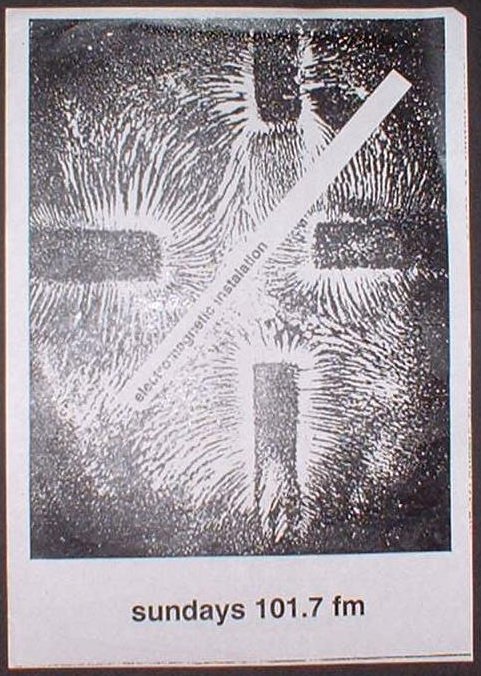
Bristol in the late 80s and early 90s was a dynamic and exciting place to be. Especially if one was creative and also interested in alternative ways of thinking and living. Independent culture was thriving. It was back in the 70s when Bristol’s radical spirit of creative and political autonomy was first forged. Post punk bands such as the Pop Group, Rip Rig & Panic, spread their own influential ethos of being creative and activist as a way of life. Advocating everyday people could be different, be independent thinkers and question the validity of the established norm. This flexible blueprint of being socially conscious in an imaginative way influenced a huge mixture of genres for years to come. Breaking down the borders between the audience and the musicians playing was a legacy handed on down from punk. This includes building your own record label, setting up your own pirate radio station, self publishing and other ventures.
Furtherfield’s first collective (yet unofficial) DIWO experience was at the Watermans Art Centre, London in 1999. We were asked to present a project which reflected the free and liberated spirit of our networked on-line community and its creative culture. The name of the project was called “Pasteups@Watermans Art Centre”, not DIWO. It had all the features of DIWO, such as using email as art, and the traditional postal services (snail mail) as part of its distribtion process. From all over the world people were invited to send images and texts which were then enlarged into a mass of photocopied posters.

On Sunday 10th October 1999 all the hoardings and wall spaces in the streets around the Watermans Art Centre were blitzed with Pasteups. There was no selection of what should be taken out or left in, everything was shown. They were put up by the Furtherfield crew and who ever wished to help out. Some of those whom took part were also local to the area. The people working in the centre reacted as if they were being over taken from a dark external force, and the passing public were expressing a mixture of emotions – enjoyment, surprise, interest, confusion, distaste and annoyance. It challenged the ideal of art having to be a rigid divide and rule of amateur vs professional, using the Internet and the physicalness of the Watermans Art Centre’s building, inside and outside. The streets were used as a shared canvas to fill our collective, imaginative expressions at that time.
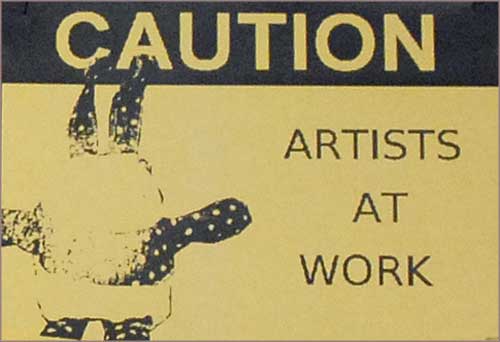
“”… the role of the artist today has to be to push back at existing infrastructures, claim agency and share the tools with others to reclaim, shape and hack these contexts in which culture is created.” [1] (Catlow 2010)
In her study ‘Empire of Dirt: The Aesthetics and Rituals of British Indie Music (Music Culture)’, Dr. Wendy Fonarow [2] investigated the UK’s indie music scene and its culture from the early 1990s to present. Below Fonarow presents the differences between mainstream and independent music culture. Contrasts are mapped out in Lévi-Straussian fashion:
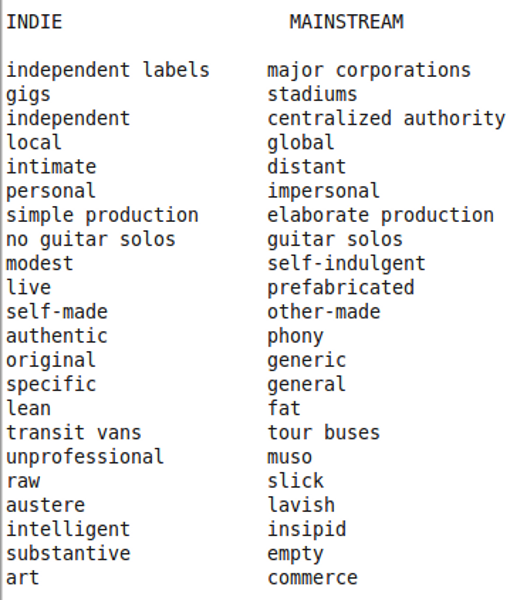
“Indie itself in relation to the mainstream as an opositional force combating the dominant hegemony of modern urban life. Any band that is seen as “chipping away at the facade of of corporate pop homogeny” (Melody Maker, April 1995) is a positive addition to the indie fellowship.”[3] (Fonarow 2006)
There are similar terms above as there is with critical practices in Media Art culture, Free and Open Source culture, activism and hacktivism, and with concepts behind DIWO. Words such as self-made, independent, raw and substantive offer strong relational ties to what we feel ourselves is essential for a thriving, discerning and critically aware process, of an unfettered state of discovering, and how to do things without conforming to top-down protocols, individually or collaboratively.
“To be an artist is to contend with the present, and there are not many other careers that afford the freedom to radically examine life and society. To put it bluntly, if artists are studying and writing more about politics, culture, and education, it’s probably a reflection of the unprecedented dysfunctionality of the societies in which they live.” [4] (Deck 2005)
When considering an art context, critical thinking on the social nuances, social and relational variants introduce possibilities for a deeper understanding of the meaning of a work and its place in the wolrd. Not only in respect of the quality of an artwork in its own right, but it also introduces consideration concerning value. Value comes out of dialogue whilst the work is put into motion, as the process occurs as well as when it reaches its final stage of being seen – it’s birth is always messy, but this process gives us the rich nutriants, the substance.
By recognising resonances that lurk between art and culture and our own connections with these elements; as we make things with others different core values come into play. This is where knowledge of how an artwork and its meaning communicates beyond the artwork itself; to and with others, linking up to the ever changing rhythms dominating society. All this, also depends on the context of how and where a work is seen. An artwork and where it is seen declares the artists’ relationship with other structures, infrastructures and networks, whether this be physical or based on-line. This informs us about the artists’ personal concepts, attitudes and social values. These attributes become part of the work; its story and part of its essence and its reasons for existing in the first place.
Whoever controls our art – controls our connection, relationship and imaginative experience and discourse around it. The frameworks and conditions where art is accessed, seen and discussed is significantly linked to representation and ownership. Socially and culturally, this process of abiding by specific rules and protocols defines who and what is worth consideration and acceptance. For art to be accepted within these ‘traditional’ frameworks a dialogue reflecting its status around a particular type of function kicks into place, it must adhere to certain requirements. Whether it is technological or using traditional art making skills the art itself must in some way conform to specific protocols before it can be allowed into the outer regions of ‘officially’ condoned culture. This process adds merit to the creative venture itself and feeds a systemic demand based around innovation in a competitive marketplace. If an iindividual or an collective does not abide by these dominating rules then they will not be seen in these frameworks. DIWO allows one to venture with many, in playful scenarios of mutual experience and interdependence, freeing up the trappings of ‘officially’ defined protocols and frameworks, governing our behaviours. This does not mean that there are no rules, it merely means that we have a more relationally informed understanding of how to work with others. Structures and aims are decided in different terms mutually.
DIWO is playful re-interpretation and fruition of some of the principles and reasons that Furtherfield was originally founded, back in 96-97. We had experienced as artists in the 80s and well into the 90s, a UK art culture mainly dominated by the marketing strategies of Saatchi and Saatchi. The same company was responsible for the successful promotion of the Conservative Party (and conservative culture) that had led to the election win of the Thatcher government in 1979. We felt that it was time to make a stance against these neoliberalist heavies controlling the art scene and our every day culture. Our aim was to move away from the typically established, sociallly engineered aspects of art culture where false credence was given to a few individuals over many others, based on their personalities alongside their depoliticized artworks.
“Furtherfield’s roots extend back through the resurgence of the national art market in the 1980s, to the angry reactions against Thatcher and Major’s Britain, to the incandescence of France in May 1968, and back again to earlier intercontinental dialogues connecting artists, musicians, writers, and audiences co-creating “intermedial” experiences.” [5] (Da Rimini 2010)
Our move away from this was to create pro-active alternatives, with social hacks, bypassing the marketing myth of the ‘genius’ as a product via the usually distracting diversions, and top-down imposed spectacles based on privilege and hegemony. Recently an article written by John A. Walker on the artdesigncafé web site, disucussed how art culture is still haunted by the power of Charles Saatchi.
“Arguably, as an art collector Charles Saatchi has become a brand in his own right—when he buys art works they and the artists who created them are immediately branded.” [6] (Walker 2010)
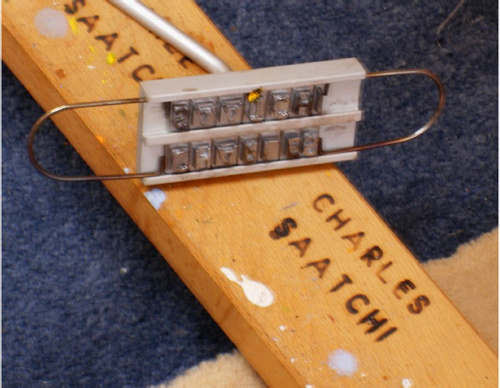
BritArt’s dominance of the late 80s and 90s UK art world dis-empowered the majority of British artists, and Smothered other artistic discourse by fuelling a competitive and divisive attitude for a shrinking public platform for the representation of their own work. Stewart Home proposes that the YBA movement’s evolving presence in art culture fits within the discourse of totalitarian art.
“The cult of the personality is, of course, a central element in all totalitarian art. While both fascism and democracy are variants on the capitalist mode of economic organisation, the former adopts the political orator as its exalted embodiment of the ‘great man,’ while the latter opts for the artist. This distinction is crucial if one is to understand how the yBa is situated within the evolving discourse of totalitarian art.” [7] (Home 1996)
By questioning the myths that dominate our actions we then become more empowered and confident to collaborate with others. We can only rediscover these inner creative kernals by critiquing the infrastructures dominating our behaviours. Many artists have and do conform to mainstream art world rules. This closes down space for a wider dialogue and experience for art practice to expand its possible horizons, beyond a handed down, hermetically sealed set of distant processes. When experimenting with alternative approaches of imaginative engagement a different set of values arrive. Through this we unearth things about ourselves which were already there but were trapped before by the mechanisms and mannerisms of mainstream culture and its dominant values.
DIWO (Do It With Others) is inspired by DIY culture and cultural (or social) hacking. Extending the DIY ethos with a fluid mix of early net art, Fluxus antics, Situationism and tactical media manoeuvres (motivated by curiosity, activism and precision) towards a more collaborative approach. Peers connect, communicate and collaborate, creating controversies, structures and a shared grass roots culture, through both digital online networks and physical environments. Stringly influenced by Mail Art projects of the 60s, 70s and 80s demonstrated by Fluxus artists’ with a common disregard for the distinctions of ‘high’ and ‘low’ art and a disdain for what they saw as the elitist gate-keeping of the ‘high’ art world.
The term DIWO OR D.I.W.O, “Do It With Others” was first used on Furtherfield’s collaborative project ‘Rosalind’ (http://www.furtherfield.org/get-involved/lexicon). An upstart new media art lexicon, born in 2004. DIWO was officially termed here in 2006 (http://www.furtherfield.org/lexicon/diwo)
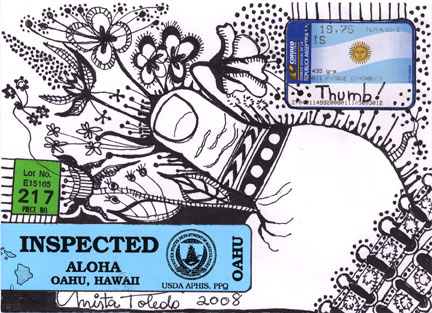
“It is in the use of the postal system, of artists’ stamps and of the rubber stamp that Nouveaux Realisme made the first gestures toward correspondence art and toward mail art.” [8] (Friedman 1995)
Mail Art is a useful way to bypass curatorial restrictions for an imaginative exchange on your own terms. With DIWO projects we’ve used both email and snail mail. Later, we will return to the subject of email art and how it has been used for collective distribution and collaborative art acitivies; but also, how it can act as a remixing tool and an art piece in its own right on-line and in a physical, exhibiting environment.
“[…] many Fluxus works were designed specifically for use in the post and so the true birth of correspondence art can arguably be attributed to Fluxus artists.” [9] (Blah Mail Art Library)
Many consider George Maciunas was to Fluxus, what Guy Debord was to Situationism. Maciunas set up the first Fluxus Festival in Weisbaden in Germany, 1962. In 1963, he wrote the Fluxus Manifesto in 1963 as a fight against traditional and Establishment art movements. In a conversation with Yoko Ono in 1961, they discussed the term and meaning of Fluxus. Showing Ono the word from a large dictionary he pointed to ‘flushing’.
“”Like toilet flushing!”, he said laughing, thinking it was a good name for the movement. “This is the name”, he said. I just shrugged my shoulders in my mind.” [10] (Ono 2008)
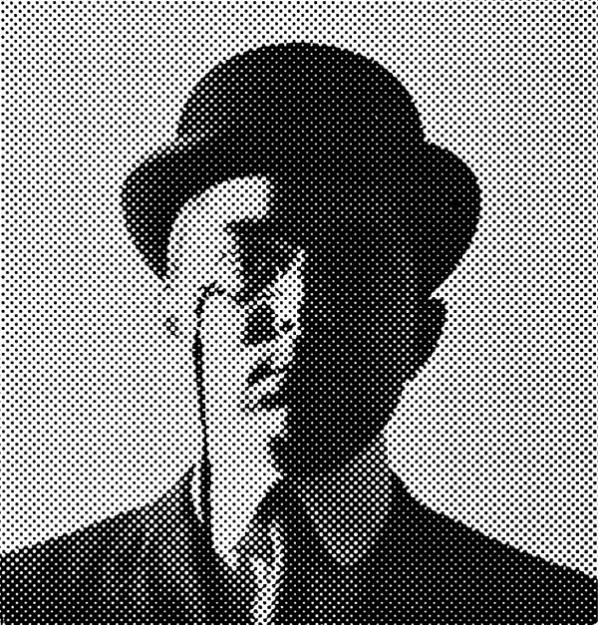
“The purpose of mail art, an activity shared by many artists throughout the world, is to establish an aesthetical communication between artists and common people in every corner of the globe, to divulge their work outside the structures of the art market and outside the traditional venues and institutions: a free communication in which words and signs, texts and colours act like instruments for a direct and immediate interaction.” [11] (Parmesani 1977)
Maciunas’s intentions and ideas are strongly based on creative autonomy. DIWO in the 21st Century explores its own position of (social) grounded reasoning and creative chaos. In contrast to the usual, standardized and bureaucratic implimentations by an increasingly banal, neoliberal elite controlling our art, education, media and economies.
“[…] art has become too narcissistic and self-referential and divorced from social life. I see a new form of participatory art emerging, in which artists engage with communities and their concerns, and explore issues with their added aesthetic concerns” [12] (Bauwens 2010)
“Marshall McLuhan once suggested that ‘art was a distant early warning system that can always tell the old culture what is beginning to happen to it'” [13] (Gere 2002) The infrastructural tendencies that occur when ‘the many’ practice DIWO; informs us we are in a constant process which redefines the role of the individual, and our notions of centralized power and behaviour. This process also presents us with critical questions around the value of art as scarcity. In moving away from our emotional attachment with the socially engineered dependencies based on consumer led forms of scarcity and desire, we then change the defaults. If we change the defaults we change the rules, no longer besieged by top-down defaults and open to more intuitive and relational contexts.
DIWO proposes in its fluid and sensual action of immediacy; situations where anyone can play and initiate collaborative and autonomous art. It is a radical creativity, asking questions through process and peer engagement, loosening infrastructural ties and frameworks as it occurs.
DIWO is a contemporary way of collaborating and exploiting the advantages of living in the Internet age. By drawing on past experiences with pirate radio, historical inspirations from Punk, with its productive move towards independent and grass roots music culture, as well as learning from Fluxus and the Situationists, and peer 2 peer methodologies; we transform our selves into being closer to a more inclusive commons. We transform our relationship with art and with others into a situation of shared legacy and emancipation.

“The network is designed to withstand almost any degree of destruction to individual components without loss of end-to-end communications. Since each computer could be connected to one or more other computers, Baran assumed that any link of the network could fail at any time, and the network therefore had no central control or administration (see the lower scheme).” [14] (Dalakov 2011)
Even though the web and DIWO possess different qualities they are both forms of commons. They both belong to the same digital complexity, and involve us connecting with each other. They are both open systems for human and technological engagement. DIWO rests naturally within these frameworks much like other digital art works or platforms and related behaviours, but possess key differences. If we consider the functions and structures of Facebook, Google, MySpace, itunes and now Delicious, they are all centralized meta-platforms, appropriating as much users as possible to repeatedly return to the same place.
“We see social media further accelerating the McLifestyle, while at the same time presenting itself as a channel to relieve the tension piling up in our comfort prisons.” [15] (Lovink 2012)
These meta-platfroms are closed systems. Not, necessarily closed as in meaning ‘you cannot come in’, but closed to others if you consider their motives and ‘acted out’ values, exploiting human interaction and their uploaded material, and openly ‘given’ data-information. These centralized meta-platforms close choices down through rules of ownership of personal data, as well as introducing more traditional standards of hierarchy, and limits one’s view and potential experience of the Internet.
Richard Barbrook and Andy Cameron saw this curious dichotomy way back in 1995. On one hand we had the dynamic energy of sixties libertarian idealism and then on the other, a powerful hyper-capitalist drive, Barbrook and Cameron termed this contradiction as ‘The Californian Ideology’. “Across the world, the Californian Ideology has been embraced as an optimistic and emancipatory form of technological determinism. Yet, this utopian fantasy of the West Coast depends upon its blindness towards – and dependence on – the social and racial polarisation of the society from which it was born. Despite its radical rhetoric, the Californian Ideology is ultimately pessimistic about real social change.” [16] (Barbrook and Cameron 1995)
Instead of submitting to an imperious process of allowing bland interaction own our behaviours; we propose an engagement where we can be more conscious and in control by exploiting further the real potential of the networks before us.
“We are not going to demand anything. We are not going to ask for anything. We are going to take. We are going to occupy.”[17] (RTS 1997)
Just like Reclaim the Streets which was an anti-car direct action movement seizing roads to prevent cars from being able to access them. Filling up public areas with thousands of bikes and using street parties as part of the political protest. We can loosen the gaze and spectacle of these propriety, meta-platforms and their dominance of our actions with others on the Internet. DIWO, is a way of thinking and acting differently, not an absolutist ‘technologically determined’ factor, but a thing of many things, and leans more towards a kind of social activism going as far back as The Diggers:
“The Diggers [or ‘True Levellers’] were led by William Everard who had served in the New Model Army. As the name implies, the diggers aimed to use the earth to reclaim the freedom that they felt had been lost partly through the Norman Conquest; by seizing the land and owning it ‘in common’ they would challenge what they considered to be the slavery of property. They were opposed to the use of force and believed that they could create a classless society simply through seizing land and holding it in the ‘common good’.” [18] (Fox)
Three elements pull DIWO together as a functioning whole, which can mutute according to a theme, situation or project. These three contemporary forms of (potential) commons mainly include; the ecological – the social – and the networks we use. By appropriating these three ‘possible’ processes of being with others; combined, they introduce and enhance potential for an autonomous and artistic process to thrive, further than the limitations of any single or centralized point of presence. It brings about small societal change, as long as we are conscious of the social nuances needed for a genuine and critically engaged, mutual collaboration.
“Online creation communities could be seen as a sign of reinforcement of the role of civil society and make the space of the public debate more participative. In this regard, the Internet has been seen as a medium capable of fostering new public spheres since it disseminates alternative information and creates alternativ (semi) public spaces for discussion.” [19] (Morell 2009)
In accordance with Mail Art tradition, DIWO began with an open-call to the Netbehaviour email list on 1st February 2007. The exhibition was at our older venue the HTTP Gallery, opening at the beginning of March. Every post to the list until 1st April was considered an artwork – or part of a larger collective artwork for the DIWO project. Participants worked across time zones, geographical and cultural distances with digital images, audio, text, code and software; they worked to create streams of art-data, art-surveillance, instructions and proposals, and in relay to produce threads and mash-ups.
One example of a work which exploited the data-steams of continual flow while over a hundred individuals participated and collaborated in DIWO in 2007, was X-ARN.org (Gregoire Cliquet, Laurent Neyssensas and Yann le Guennec). By using the dynamic exchange of the Netbehaviour email list as reliable exchange of regualr content, the net art group were able to perform their particular and unique processes of interaction, or intervention. It had no specific title, it was literally documenting the list’s networkked behaviour, and there were many of these networked visualizations made. They experimented with the net-specific aspects of DIWO’s mass artistic activity, forming digital mappings of this collected data or data-streams in ‘real-time’, as it all happened.

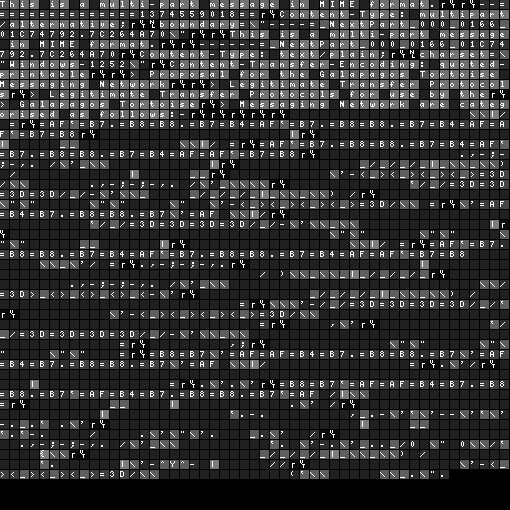
![[ARN / DIWO-Betatests 2007]](http://www.furtherfield.org/wp-content/uploads/2012/05/attachment3.png)
Some also participated in the experimental networked curation of the exhibition, facilitated by web cams, public IRC and VOIP technology. This co-curation event, or Curate With Others (CWO), as it was retroactively named, took place a week before the gallery opening. All subscribers to the NetBehaviour list were invited to contribute to the curation of the exhibition either by viewing the gallery floor plan and posting suggestions to the list or by taking part in the event; attending the gallery or joining the online meeting. Information about how to join the online event was posted to the list. During this event the spirit and philosophy of DIWO E-mail-Art were discussed, the deluge of diverse contributions by about a 100 people were reviewed, plinths, monitors and a drawing machine.
“The ‘Will Work For Food’ happening deals with the desire to find a new definition for labour and the act of working.” [20] (Jeron 2007)
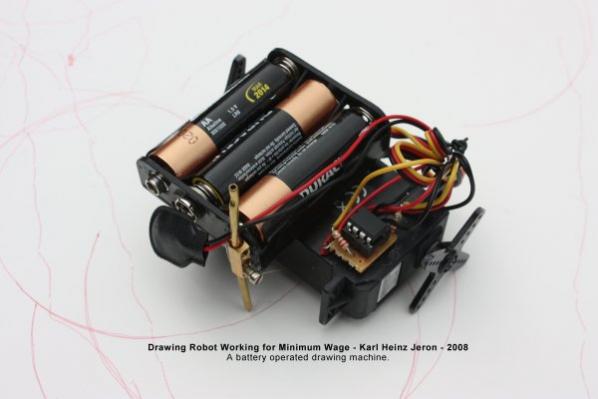
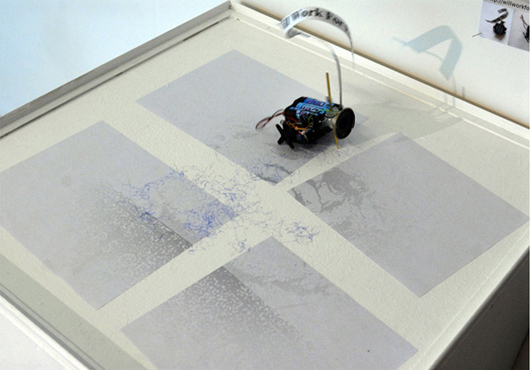
Karl Heinz Jeron’s drawing machine was a vehicle equipped with a ballpen run by rechargable batteries, and when turned on created random drawings. Jeron’s machine was not switched on, unless he received gifts in the post such as chocolates or any other form of economic support. After (thankfully) receiving various contributions in the post the image supplied by Jeron of Karl Marx would gradually be scribbled over.
This section of the Article is an edited version of a collaborative text by Ruth Catlow & Marc Garrett. Originally published on Vague Terrain in 2008. [21]
Present in the flesh were the Furtherfield.org crew and James Morris (regular, esteemed DIWO contributor).
Frederik Lesage manned the Public IRC and, as ‘DIWOchatbod’, who documented the conversation in the gallery for the benefit of those online co-curators who had trouble logging into Skype. Through the afternoon the online event was visited by eight people. The CWO event determined the format of the DIWO exhibition and the Furtherfield.org crew was charged with installing it. So, about approxximately 15 individuals on the day co-curated the setting up of the exhibition. Afterwards we informed everyone on the Netbeahviour list for any last minute details and suggestions and then continued with everything.
(Floorplan of Do It With Others (DIWO) at HTTP-Gallery, London. 2007)
The centerpiece of the exhibition was an e-mailbox containing all submissions; sorted and categorised for visitors to explore and redistribute by clicking ‘Forward Mail’. Streams and Themes displayed images, texts, sounds, code, and movies, primarily by single contributors (human and machine) as well as collections of themed posts or particular kinds of activity). Threads contained series of dialogic emails whose senders were remixing images, movies and code, most often in action and response). Other categories included Proposals and Instructions and Approaches to E-Mail Art.
(DIWO curated emailbox displaying image 3 tampered, posted by Chris Fraser 28/02/07)
Many of the themed folders and subfolders had their corollaries in the physical space of the gallery in the form of wiggly overlapping streams of printed images, pinned to the walls. Threads were represented by scrolls; one post after another in chronological order. A TV ran a video compilation, a sound compilation was played over four speakers, and two installation works were devised especially for the space. Karl Heinz Jeron’s ‘Will Work for Food’ and a print/projection mashup by Thomson and Craighead and Michael Szpakowski.
(Visitor to DIWO E-Mail Art at HTTP Gallery explores the DIWO email box. 2007. Image by Pau Ross)
All categories were liberally interspersed with off-topic discussion, tangents and conversational splurges so one challenge for co-curators was to reveal the currents of meaning, and emerging themes within the torrents of different kinds of data, process and behaviour. Another challenge was find a way to convey the insider’s – that is the sender’s and the recipient’s- experience of the work. These works then were made with a collective recipient in mind; subscribers to the Netbehaviour mailing list. This is a diverse group of people, artists, musicians, poets, thinkers, programmers (ranging from new-comers to old-hands) with varying familiarity with and interest in different aspects of netiquette and the rules of exchange and collaboration. This is reflected in the range of approaches, interactions and content produced. Before DIWO, extensive press releases were posted to different email lists, and online art platforms to join the Netbehaviour list to collaborate on the project.
(Lem Pollocked. By Lem Urtastik 16/2/07 / Created using Jackson Pollock artware by Miletos Manetas)
As with our previous experience of collective media arts ventures such as the first round of NODE.London Season of Media Arts (2006) [21] “we saw that lots of people invested with most enthusiasm in unstructured discourse; meandering and complex. This gave all participants a partial but meaningful view of the diverse contexts in which we worked, allowing us to make decisions about what our contribution could be. These many-to-many deep processes are never efficient but still invaluable to us in a culture where the pressures are always to be newer, faster, better-oiled, less philosophical, less human (ie less messy and complicated), more productive in the service of strategic overview.” (Garrett and Catlow) [ibid]
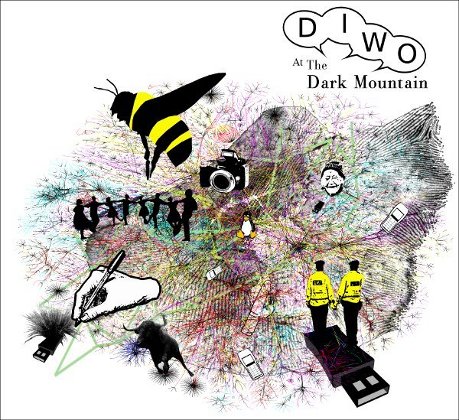
The next DIWO took place in 2009. It was called ‘Do It With Others (DIWO) at the Dark Mountain’. It was a collaboration between the then, newly formed ‘The Dark Mountain Project’, [22] Furtherfield and those participating in DIWO. A Dark Mountain manifesto grew out of a conversation between Paul Kingsnorth and Douglad Hine. It was an invitation to a new cultural response to the converging crises of climate change, resource scarcity and economic instability.
Paul Kingsnorth, in a letter to George Monbiot in the Guardian Newspaper which was also (openly) published by Monbiot said “As for saving the planet – what are we really trying to save, as we scrabble around planting turbines on mountains and shouting at ministers, is not the planet but our attachment to the western material culture, which we cannot imagine living without.” [23] The Dark Mountain Project wrote their Manifesto ‘UNCIVILISATION: the dark mountain manifesto’ “Old gods are rearing their heads, and old answers: revolution, war, ethnic strife. Politics as we have known it totters, like the machine it was built to sustain. In its place could easily arise something more elemental, with a dark heart.” [24] (DMP 2009)
The Dark Mountain Project has been viewed by many as apocalyptic, yet it also has grown in popularity these last few years. When discussing the project Hine says “Rather than treating these as distinct problems in need of technical solutions, we argued that they should be treated as symptoms of a deeper social and cultural crisis, a failure of the stories we have been telling ourselves for generations.” The Dark Mountain Project text was “addressed to other writers, and there is still a vein of Dark Mountain which is about finding new ways of writing, adequate to the times we are living through.” [25] (Hine 2009)
Kingsnorth and Hine both come from a literary background. Asking people to get involved in the project was a big ask.
DIWO E-Mail Art contributors in 2007 included: //indira, [–lo_y-], aabrahams, Alan Sondheim, Alexandra Reill, Allan Revich, Ana Valdes, Andre SC, Andrej Tisma, Ant Scott, arc.xolotl ARN, Aurlea, biodollsmouse, Bjorn Eriksson, Bjorn Magnhildoen, Blackmail, bob catchpole, bobig, brian@netart.org.uy, Camille Baker, Chris Fraser, Christphe Bruno, Clive McCarthy, cont3xt.net, Corrado Morgana, Daniel C. Boyer, dave miller, Denisa Kera, Dion Laurent, Eric Dymond, Edward Picot, Frederick Lesage, Geert Dekkers, Giles Askham, Giselle Beiguelman, Gregorios Pharmakis, Hans Bernhard, Helen Varley Jamieson, Hight, James Morris, janedapain, Jon Thomson, Jonathon Keats, Kanarinka, Kate Southworth, Lance W, Lauren A Wright, lem urtastic, Lewis LaCook, Lisa, Lizzie Hughes, Lorna Collins, Lucille C, Marc Garrett, Marc Cooley, Maria Chatzichristodoulou, mez breeze, Michael Szpakowski, Msdm, Neil Jenkins, patrick lichty, Paul Trevor, Regina Pinto, Riccardo Mantelli, Richard Osborne, rich white, Rosangela Aparecide da conceicao, Ruth Catlow, Sachiko Hayashi, Severn, Sim Gishel, Spread, Susana Mendes Silva, Taylor Nuttall, The Subversive Artist, Turbulence, Wolfgang, xavier cahen, zea.
This conversation follows in a series of interviews with women who work at the intersection of art and technology. As someone who works as an artist, curator, organizer, professor, researcher, and board member Sue Gollifer embodies this intersection across many venues.
Sue Gollifer has been a professional artist and printmaker for more than thirty years, Gollifer has exhibited her work worldwide and been collected by major international public institutions. A pioneer of early computer art, she has continuously explored the relationship between technology and the arts and has written extensively on this subject. Gollifer is a Principal Lecturer in Fine Arts and the University of Brighton where she is also the Course Leader of the MA Digital Arts Program. She has been instrumental in shaping major international arts communities including: the Design and Artists Copyright Society (DACS), the Computer Arts Society (CAS), and the College Arts Association, (CAA), ISEA, SIGGRAPH, Lighthouse Brighton, and many others. Gollifer is currently also the Director of the ISEA International Headquarters.
Rachel Beth Egenhoefer: Given the many hats you wear as an artist, curator, organizer, professor, many people describe you as many things… how do you describe yourself?
Sue Gollifer: I am an artist.
RBE: But you do other things too?
SG: I know I do. At the moment I’m more of a curator and an organizer, but at the end of the day I am still an artist.
RBE: How do you define your role as an artist in relation to being on the many board of directors you are on (such as ISEA, CAA, DACS, and others)?
SG: I’m not a theorist or in a senior management position but I think that these organizations need people who have a broad sense of the discipline to be on their boards to make sure that people like me and people like you have a voice.
RBE: So you see yourself as representing artists?
SG: Yeah, and I think the fact that I have a European background gives me a broader image as well. When I think about being on the board of some local organizations like Lighthouse or Phoenix in Brighton they value that I’m also part of an International network such as CAA and SIGGRAPH and ISEA. It’s quite reciprocal too. The bigger organizations value my spectrum.
RBE: What do you learn as an artist from doing all these other organizational things?
SG: I think what it does is it starts me making work. It’s like any of those things. But I think it started off when I was a consultant to Higher Education in the UK and I just got used to facilitating and networking and telling people about things. And I realized I was really quite good at that.
RBE: Networking?
SG: Yeah. But not just networking. I organize a lot of mailing lists, where I act as a kind of filter for people, letting them know about events and festivals, and ideas that are going on.
RBE: So given that you work in all of these roles, as an artist, as an organizer, as a filter, what changes have you seen over the years of working in these fields?
SG: Well, technologies have changed our lives with the Internet and mobile phones. You know I travel a lot, but half the time people don’t know that I’m not really there, because I still do what I’m doing somewhere else. Where you are doesn’t really matter. You still kind of function, which has its good points and its bad points really, cause you’re always on call.
RBE: What about changes in content or questions that people are asking? Either in art practice or education or conferences and festivals, have there been any changes?
SG: I think the reason why ISEA is successful is because, although we all have our distributed networks and we’re always in constant touch, I think the act of physically bringing people together is really important. But I do think also that a lot of the organizational things like content management systems and the ways that you hear about various festivals and things is made so much easier. At the same time there are so many of them. It’s really important with my ISEA hat on that I’m thinking about the “un-conference” and that you don’t get stuck in a rut. There is a changing landscape and environment and you need to keep up with that.
But with my educator’s hat on, thinking about PhDs and research papers, there’s a lot more to do with money and research and getting money from science backgrounds now. But the idea of research gets lost. What they value is that people are writing about stuff, they’re not actually doing it, but writing about it, using research as evidence.
RBE: What is the role of research in art?
SG: I don’t know. What do you think? Do you think it’s the work? Do you think it’s making the work?
RBE: Well, I think research can inform the work, and work can inform research. But I think the point you brought up about research and the sciences and the value of it, it seems like it can become problematic when it is seen as a moneymaker. Or when the purpose of it is to get money and not the purpose being to inform the work.
SG: Yeah, I was involved in a science project and there was a lot of money in it and they obviously valued the significance of the artists being in there but really you have to fit your research around the money rather than the other way around. It just got out of sink.
RBE: Does that map at all on to how conferences and festivals are set up? Does the work dictate what will be at the event, or does the event dictate what will be made by artists?
SG: Well, to get back to the research thing. Research as evidence of something, even if you are putting work in an exhibition or putting work in a paper or something, you still need evidence.
RBE: But as far as themes or content, how is that dictated? For example the upcoming ISEA is all about “Machine Wilderness”. Was that a result of artists making a lot of work in that realm and we should have a festival about it, or do you think that it was a decision to have a festival about this and encourage artists to think and make work like this?
SG: Well when people put in a bid to host ISEA, they put in what they think the nature of what ISEA will be about. Obviously when we look at proposals we look at not only the relevance but also the integrity of the people delivering it. “Machine Wilderness” in this case is very much around the themes that Andrea Poli is interested in. The theme of ISEA in Istanbul was “Contained/ Uncontained” which was similar but also a bit broader.
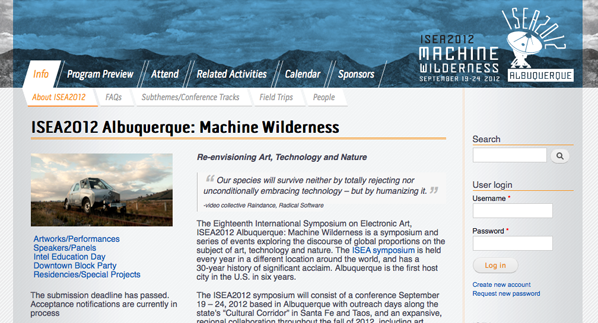
RBE: How do you see the differences in cultures influencing different ISEA’s? ISEA purposely has the festival in different cities around the world, how does that influence the work or the field or what people are thinking and doing?
SG: Well if you take the case of the ISEA in RUHR, Germany, it was to do with the Creative Industries, and creating awareness of new industries. You know we come in and inform people about new things. There’s the idea that we can change things. Or bring things to a city in a way of education and outreach. It shouldn’t be just us sitting in a dark room talking to each other.
RBE: So you see it as a way to bring new media awareness to these different cities?
SG: Yeah.
RBE: But then what do the artists and participants get in return? Or what does ISEA get in return?
SG: You get to travel and meet people! I think you get a different perspective.
We did have two bids coming through for ISEA2014 from Zayed University, Dubai, UAE and Simon Fraser University, Vancouver, BC. Recently the ISEA Board agreed that the Dubai bid, with its focus on the burgeoning field of art and technology in the Arab World would provide a unique opportunity for ISEA to connect audiences and artists from the Middle East with the international electronic art community.
A strong aspect of the bid was the focus on women’s education and ensuring that young women have the potential to influence the future of the region and develop international contacts.
I hope that ISEA can leave a legacy somewhere. I mean otherwise we might as well just have it over Skype calls. The overarching theme of ISEA2014 ‘Location’ will explore strands such as Technology; Science & Art East Meets West; Emerging Economies/Emerging Identities; Nomadic Shifts and Digital Archaeology and Collaborative Spaces.
RBE: This interview is part of a series of interviews with women using art and technology. What do you think is important in having a female voice in today’s art world?
SG: I talk to my students about my role and my job and things like that, and my female students think that it’s really great that I run a digital arts course. If I were a man it would be very very different. I think it’s equally important that students aren’t just taught by women, but women of all ages, those that are married, not married, children, no children. I think we do have to establish role models to a certain extent.
I was a feminist in the 60s and 70s but I never thought that we should be different. I just wanted to be accepted for who I was really. That might be a bit anti-feminist, but I always fought for women for education and opportunities. This goes back to the Dubai thing to a certain extent, the university there started off because one of the princesses wanted to learn about art but there was no place to do so. So it started and went on to have a validated degree. And maybe one day it will have a masters program and women can apply for scholarships and travel abroad?
RBE: Do you think it’s important to have “Women Art & Technology” as a separate category? Or should it just be “Art & Technology”?
SG: Art and Technology.
RBE: Aside from being a female role model for your students and talking about the female voice, what else do you think is important for your students to know right now or learn right now?
SG: Code! (laughs) But I don’t like to think we’re bringing them up differently?
RBE: Or even taking gender out of it, what do young people need to know?
SG: They need to be aware of things. But it depends on what they are trying to do and what direction they want to go in… A big thing is confidence. A lot of my women students do lack confidence.
RBE: Why do you think that is?
SG: I don’t know what it is.
RBE: So what do you do to boost their confidence?
SG: I give them a voice. I give them a space and an opportunity in the class.
When I used to do interviews for undergrad programs in Printmaking, it always started off that the women had better grades, better portfolios, better skills, but at some point it switches. And they loose that confidence and that voice. I don’t know what it is really.
Do you find that?
RBE: The program I teach in has a majority female students. I think that it might be easier for them. I do wonder though sometimes if they are more confident when they are in a classroom with me verses one of my male colleagues or just a different background. But I think there’s also the other end of the spectrum where they are overly confident because they are growing up in this world where you have to be liked constantly on Facebook. You know, like me, like my image, like me, like me, like me… They need to be constantly validated and that spirals into “I’m amazing”. But those aren’t the ones who are asking the tougher questions; those are the ones who want to be liked.
SG: There’s another aspect. Maybe not about confidence, but I think there’s a smoke and mirrors element. There are some men that seem to have all the jargon without actually any credibility. And the women I know with credibility don’t necessarily tell everyone that they do it.
RBE: There are actually studies about that, and how male and female brains are wired differently to behave differently.
SG: I think they address issues in a different way.
RBE: What are you working on now?
SG: Alan Turing!
RBE: What is your role in the Turing Project?
SG: I’m putting together with Anna Dumitriu the exhibition ‘Intuition and Ingenuity’, a group exhibition that explores the enduring influence of Alan Turing – the father of modern computing – on art and contemporary culture. 2012 will be the 100th anniversary of the birth of Alan Turing, one of the greatest minds Britain has produced; the world today would have been a very different place without his ideas.
I’m also curating a projected drawing Exhibition for the Drawing Research Network (DRN) conference in Loughborough in September.
I have also just been part of selection partnership for two newly commissioned pieces of work for Brighton Festival, ‘Sea of Voices’, and ‘Voices of the SEA’. Plus reviewing work for SIGGRAPH art gallery 2012 and for ISEA2012, and papers for the journal ‘Digital Creativity’, of which I am assistant editor.
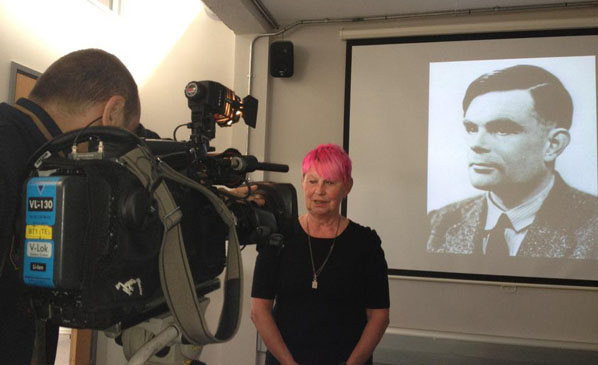
RBE: What excites you about the future?
SG: I don’t know really. I hate to get gloomy about the future, but I do think it’s going to get worse. I mean you live in San Francisco and I live in Brighton so I don’t think it’s hit us quite yet, but I am starting to notice a lot of shops closing. And I know that things I took for granted like buying a house, having children and having a job, I don’t think they have these choices anymore.
RBE: How do you think this will impact the art community?
SG: There are surprisingly good opportunities for the use of vacant shops and offices for exhibition spaces and studios and surprisingly people buy art because they think it’s an investment for the future.
RBE: Do you have anything else you want to tell the Furtherfield readers?
SG: I think it’s going to be interesting and exciting in the future, despite all this, I think it’s going to be exciting to see what comes next.
Other interviews in this series:
Woman, Art & Technology: Interview with Lynn Hershman Leeson By Rachel Beth Egenhoefer
Women, Art & Technology: Interview with Sarah Cook
Anonymous, untitled, dimensions variable is the title of a show by 0100101110101101.ORG (Eva and Franco Mattes) at Carroll/Fletcher gallery in London from 13th April to 18th May 2012. Or at least it was. The title changes each day based on submissions to a blog (http://exhibitiontitlechange.tumblr.com/). The new titles have been printed out and displayed on the wall to the left as you walk in to the gallery.
You don’t expect this kind of playful intersection of the virtual and the real in a gallery off of Oxford Street, across from Soho, opposite other new galleries. Carroll/Fletcher’s glass-fronted welcomingly brutalist interior says “serious contemporary art space”. Inhabiting such a space presents a challenge to net and digital art that must be met with careful presentation and considered curation.
Through the glass front of the gallery, and as you enter, you see a sculpture or assemblage of a (stuffed) cat trapped in a birdcage by a (stuffed) canary (Catt, 2010). The cat has suffered Epic Fail as the Internet would say, and did in the meme image that the sculpture is based on. It’s a comic and unnerving object even without the extra layers of reference provided by the original meme and the knowledge that it was originally presented as a fake Maurizo Cattelan sculpture. It is art with its roots in the net that can stand on its own without that context. Its companion piece, Rot, 2011, is a fake Dieter Roth sculpture consisting of detritus in a glass jar on a plinth against the far wall. 0100101110101101.ORG briefly inserted it into the Wikipedia page on Roth, and the fact that its materials were all ordered via the Internet drives home just how commonplace this has become.
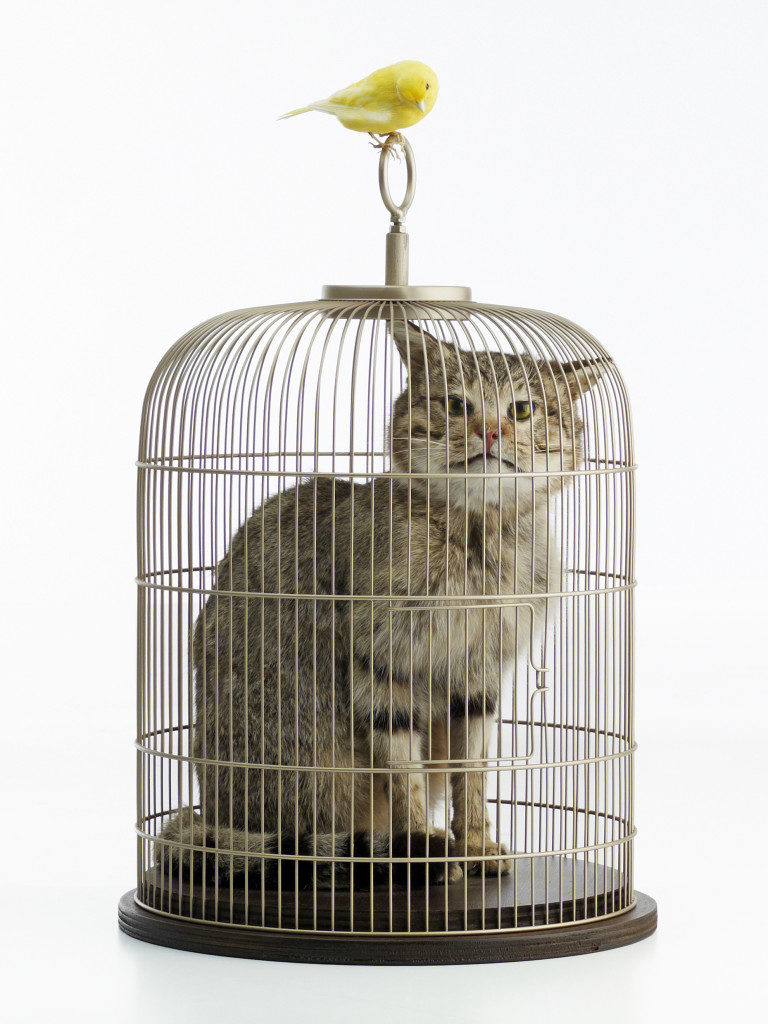
Both are given the room they need to work as objects in a gallery. Neither originates in itself as net art, more in 0100101110101101.ORG’s history of tricksterism and transgression. These are concerns that are easily linked to net culture, possibly too easily on the part of the reviewer, but it is telling that they are the works that the show opens with. They physically establish the playful appropriation and hyperreality that is the basis of much of 0100101110101101.ORG’s work.
Pride of place in the first room of the gallery goes to the projection The Others, 2011, 10,000 digital photographs (supposedly) copied without authorization from the folders of computers used by people on a peer-to-peer filesharing network that 0100101110101101.ORG used to distribute their own work. These are private images, projected at an angle and slightly across the corner. Configure your peer-to-peer filesharing client wrongly and it shares all the files in the folder you share. Including the images of you naked, drunk, lonely, partying, or whatever else you wouldn’t post anywhere a future employer might find them.
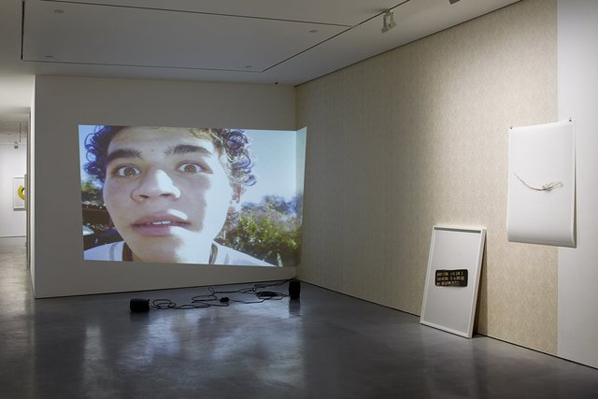
In the next, smaller, room is Colorless, odorless and tasteless, 2011. It is an old-fashioned car racing video arcade game retro-fitted with a petrol engine that starts up when you insert a coin and revs as you press the pedal to accelerate the virtual car on the screen, filling the (sealed…) room with carbon monoxide. Combining the virtual made physical of Catt and the moral impact of The Others, it is the most immediately dangerous artwork I’ve ever had to review.
Moving into the larger room at the back of the ground floor of the gallery, the video No Fun, 2010, is the most shocking piece in the show. Franco Mattes pretending to hang hineself on the random Internet webcam video chat switchboard Chatroulette is one thing, but the reactions of other Chatroulette users as they connect and see him apparently hanging there is quite another. Some laugh, some jeer, only one I watched displayed any lasting concern. This is the moral and aesthetic flipside of The Others.
Reenactments, 2007, is my aesthetic and technical favourite piece in the show. Videos of canonical performance art pieces being re-enacted by Eva and Franco’s Second Life avatars are displayed on CRT monitors arranged at floor level surrounded by the cables and adapters used to play back the video from SD cards. It’s much easier for an avatar to remain still as a “Singing Sculpture” than it is for a human being, making it even stranger, and Marina Abramovic’s “Imponderabilia” works much better with impossibly buff avatars than with mere naked human models stood in a doorway. It exquisitely foregrounds the social mediation of Second Life and its players self-presentation. A large cartoon wolf squeezes through between the naked avatars, their polygons intersecting. A vampire attempts to fly over them but hits the bounds of the architecture. The crowd in the background chat and bide their time. The virtual intensifies the real, out-doing and critiquing its appropriated source material.

Stolen Pieces, (1995, made public 2010) claims to move beyond fakery and unauthorized copying to physical appropriation. Stolen physical fragments of canonical postmodern artworks (Duchamp, Warhol, Koons, Rauschenberg) are displayed like forensic evidence, protected in small plexiglass containers, accompanied by large photographs of them and by documentary evidence of their theft. There’s no statute of limitation on theft in the UK, and damaging artworks shouldn’t be applauded. But it’s a daring performance and a concrete critique of the fetishism that lies at the heart of the art market and the institutions that help drive its value.
Following the brutalist concrete staircase to the basement reveals My Generation, 2010, a smashed but still working early-2000s PC lying on the floor. On its monitor, that appears to have fallen on its side, show video clips of computer game players giving in to and venting their frustration at the games they play. This isn’t the kind of image of yourself you want as your lasting monument on the Internet. Gathered together, like the images in The Others and the videos in No Fun, they again form a summation of an aspect of society and our visual environment that could not be achieved with such immediacy by other means. And the clear space and architectural solidity of the gallery again help to put a different emphasis on the material than if it was encountered on the web.
The wall-filling video projection of Freedom, 2011, records Eva’s attempts to plead with the players of networked First Person Shooter computer games not to kill her character. Touch-typing might have helped, but even when Eva manages to type long enough to explain that she’s an artist, or to ask people not to shoot, the social and game logic of the virtual world mean that her character is executed again and again, the screen shifting to third person as her avatar moves out of her control in death. Like No Fun, there is a core of callousness to these Internet interactions, and like My Generation they are unexpectedly preserved and presented for contemplation.
The final piece in the show is the documentary Let them believe, 2010, a video record of 0100101110101101.ORG’s Tarkovsky-haunted journey into Chernobyl’s “Exclusion Zone” in order to recover part of a fairground ride to turn into Plan C, 2010. Bringing part of the ride to life in a place where people can enjoy it is an effective and resonant symbolic resolution of the kind that art more than any other mode of human endeavor can provide.
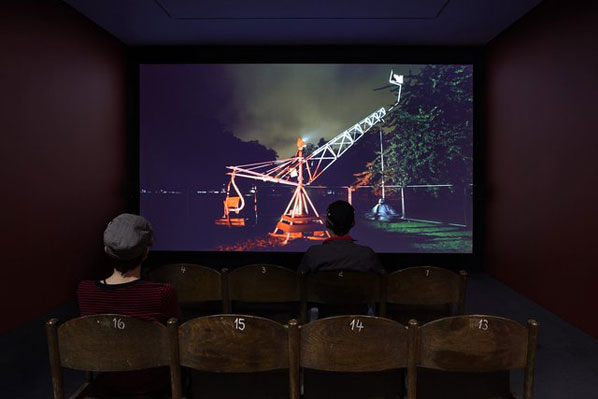
0100101110101101.ORG’s work presented physically has more than enough presence to fill the gallery and benefits from the space and the considered curation afforded it here. Some of the work is more physical than virtual and vice versa, sometimes the ethics of the work place 0100101110101101.ORG as the villain sometimes as the victim, and sometimes the work is performance whereas other times it is assemblage. I mention this to point out both the strong themes to the work and how individual the effect of each piece is.
Net art in the gallery might seem a category error, like museum postal art. Or it might seem a commodity, like auctions of land art documentation. But net art is transitioning from being the contact language of artworld emigrants learning the net’s protocols to the contact language of net emigrants learning artworld protocols. 0100101110101101.ORG have made art of these encounters from the start, and have always been as at home in the gallery as on the net.
The text of this review is licenced under the Creative Commons BY-SA 3.0 Licence.
As part of the Being Social exhibition at Furtherfield Gallery in Spring 2012, Ele Carpenter and Emilie Giles facilitated embroidery sessions with gallery visitors who stitched a term from the Raqs Media Collective’s text ‘A Concise Lexicon of/for the Digital Commons’ (2003).
View images from the workshops
The Embroidered Digital Commons is a collectively stitched version of ‘A Concise Lexicon of/for the Digital Commons’ by the Raqs Media Collective (2003). The project seeks to hand-embroider the whole lexicon, term by term, through workshops and events as a practical way of close-reading and discussing the text and its current meaning.
Crafters, programmers, artists, makers, and people interested in working collaboratively, or taking part in participatory projects gathered to each stitch a few words of the term meme, as described below. The resulting patches will be turned into a short film depicting the sequence of embroideries.

In 2003 the Raqs Media Collective wrote ‘A Concise Lexicon of/for the Digital Commons’. The full lexicon is an A-Z of the interrelationship between social, digital and material space. It weaves together an evolving language of the commons that is both poetic and informative. The terms of the lexicon are: Access, Bandwidth, Code, Data, Ensemble, Fractal, Gift, Heterogeneous, Iteration, Kernal, Liminal, Meme, Nodes, Orbit, Portability, Quotidian, Rescension, Site, Tools, Ubiquity, Vector, Web, Xenophilly, Yarn, and Zone.
The concept of the digital commons is based on the potential for everything that is digital to be common to all. Like common grazing land, this can mean commonly owned, commonly accessed or commonly available. But all of these blurred positions of status and ownership have complex repercussions in the field of intellectual property and copyright. The commons has become synonymous with digital media through the discourse surrounding free and open source software and creative commons licensing. The digital commons is a response to the inherent ‘copy n paste’ reproducibility of digital data, and the cultural forms that they support. Instead of trying to restrict access, the digital commons invite open participation in the production of ideas and culture. Where culture is not something you buy, but something you do.
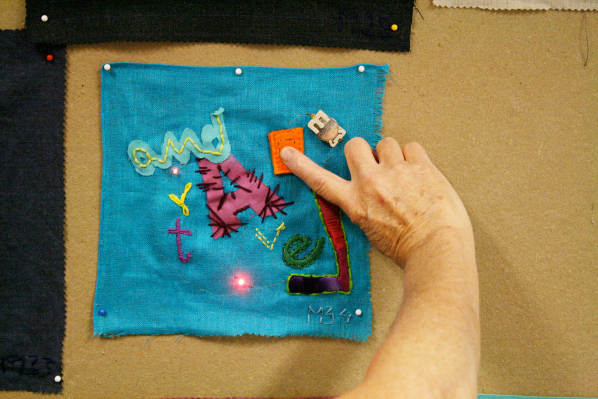
MEME
“Meme: The life form of ideas. A bad idea is a dead meme. The transience as well as the spread of ideas can be attributed to the fact that they replicate, reproduce and proliferate at high speed. Ideas, in their infectious state, are memes. Memes may be likened to those images, thoughts and ways of doing or understanding things that attach themselves, like viruses, to events, memories and experiences, often without their host or vehicle being fully aware of the fact that they are providing a location and transport to a meme. The ideas that can survive and be fertile on the harshest terrain tend to do so, because they are ready to allow for replicas of themselves, or permit frequent and far-reaching borrowals of their elements in combination with material taken from other memes. If sufficient new memes enter a system of signs, they can radically alter what is being signified. Cities are both breeding grounds and terminal wards for memes. To be a meme is a condition that every work with images and sounds could aspire towards, if it wanted to be infectious, and travel. Dispersal and infection are the key to the survival of any idea. A work with images, sounds and texts, needs to be portable and vulnerable, not static and immune, in order to be alive. It must be easy to take apart and assemble, it must be easy to translate, but difficult to paraphrase, and easy to gift. A dead meme is a bad idea.”

Ele Carpenter
Ele Carpenter is a curator based in London. Her creative and curatorial practice investigates specific socio-political cultural contexts in collaboration with artists, makers, amateurs and experts. She is a lecturer in Curating at Goldsmiths College, University of London.
Since 2005 Ele has facilitated the Open Source Embroidery project using embroidery and code as a tool to investigate the language and ethics of participatory production and distribution. The Open Source Embroidery exhibition (Furtherfield, 2008; BildMuseet Umeå Sweden, 2009; Museum of Craft and Folk Art, San Francisco, 2010) presented work by over 30 artists, including the finished Html Patchwork now on display at the National Museum of Computing at Bletchley Park. Ele is currently facilitating the ‘Embroidered Digital Commons’ a distributed embroidery exploring collective work and ownership 2008 – 2013.
Emilie Giles
Emilie Giles is an alumnus of MA Interactive Media: Critical Theory and Practice at Goldsmiths College. Since graduating in 2010 her time has been spent co-organising MzTEK, a women’s technology and arts collective, as well as completing an internship with arts group Blast Theory and working for social video distributors Unruly. She is currently involved with TESTIMONIES, a project which explores oral history in relation to the 2012 Olympic and Paralympic Games largely through social media.
Emilie’s own practice revolves around notions of pervasive gaming, married with urban exploration and psychogeography. Her most recent focus lies in taking fundamental gaming principles from Geocaching and exploring the consequences of adding an emotional dimension.
There’s a splendid exhibition currently on at Manchester’s Cornerhouse. Entitled Subversion, it presents a selection of artworks, a good number of which are moving image pieces, from various artists who are united by a strong connection to the Arabic speaking world. We’re already in loaded territory, for all sorts of obvious reasons. Those reasons could give rise to a long discussion which I’m not going to approach directly here, instead simply quoting a programmatic statement from Glaswegian Egyptian-Turkish writer Omar Kholeif, the show’s curator:
‘Like many of the artists I was looking at, I felt that collectively curators and writers associated with the politically unstable Arab world were being asked to step up and perform to an identity that the world wanted us to play. With Subversion my aim was to do just the opposite. I worked with artists who referenced this very language but who wanted to dissent, poke fun, critique and re-define themselves as artists of the imagination, and not of any specific social or political condition.’
And, in case you’re wondering, he succeeds richly in this aim and, I think, more.
If you can get to Manchester with at least a couple of hours to spare before 5th June your life will be enriched thereby.
I’ve already written a short piece on the show, with a couple of video clips, on DVblog and I’ll be writing a longer review, including consideration of some of the thornier question alluded to above, for MIRAJ 4, out in June 2013.
What I’d like to do here is to look in some detail at one particular piece from the show, a short video by Khaled Hafez. I don’t mean to suggest that it is somehow best in show although I do love it – the show is too diverse for that kind of simple-mindedness. I do think a careful examination of it will yield support for Kholeif’s position. What we have here is a complex work of art, which bears repeated viewing, which doesn’t bend or break but thrives under that hard scrutiny and which, although inevitably stamped with the experiences, background, the moment in time, the physical location of its creator – what isn’t! – is universal (Problematic term! Of course we can’t know what 100 years will make of it but we can assert its current universality and adduce evidence that it is a work which promises to be of some long-term interest too.)
Hafez is probably better known as a painter of striking mash-ups of ancient Egyptian gods, comic book heroes, bodybuilders and models set against richly textured, feverishly beautiful and largely non-perspectival landscapes of the imagination. His paintings are characterised not only by this content (and of course what we lose in a run down of content is the aftermath of the act of painting, facture’s narrative, the play of line, geometry and colour. I’ve seen none of his pieces ‘in the paint’ but I’d bet money they’re good enough to eat.)
Furthermore, series, numbers, line-ups, multiples and queues of those Gods, comic book figures, bodybuilders and hybrids thereof seem to be important to him (and I don’t think I’m wrong in perceiving an echo of hieroglyphs and their implied grid and of pre-Arabic Egyptian art too).
There’s a strong sense of directionality and of motion arising from these lines and groupings and even if one knew none of the background it wouldn’t be surprising to learn of Hafez’s deep interest in moving image.
OK – to the piece itself. Let’s stay zoomed-out for a while and point out first that it was made in 2009, two years prior to the revolution which brought down Hosni Mubarak, exemplifying the ‘storm petrel’ effect whereby artists, who can often be infuriatingly ditzy as politicos, nonetheless, in virtue of their trade – their looking, their seeing, their empathy, empathy often of a strangely disinterested variety except for the can-I-make-art-from-it question, which question perhaps even makes their antennae the sharper, their sensitivity to society’s emotional weather, their readiness to make apparently random or intuitive connections – can be uncannily prescient about impending social change. Artists often ‘get it’ before the key actors begin to have the confidence to move.
So, you need to know that the piece contains so much reference to social conflict that, at first sight, to the outsider at least, it could have been made in the last year.
We start in darkness. Titles: “Anubis productions presents”. A number of soundtracks sewn together in a kind of faux short wave radio polyphony which resolves to a solo piano playing something doomily romantic which I don’t recognise (on subsequent listening it appears to be of a piece with the up-tempo stuff that follows, so I assume it’s especially composed). Over this we hear an extract from the resignation speech given by General Gamal Abdel Nasser in the immediate aftermath of the defeat in the six day war against Israel in June 1967. (He resigned for a day, coming back to office surfing a wave of popular support and grief and then ruling until his death in 1970).
I presume that to quote Nasser is a potent gesture in Egypt. I assume, despite any criticisms anyone might make of him he carries a ‘father of the nation’ type weight and that an allegorical comparison between him and Mubarak would come naturally – here is a flawed but somehow heroic figure, indubitably at the least a genuine anti-imperialist – offering his resignation, but, now, in stark contrast, his pale epigone, his inheritor as dictator but not as hero, clings grimly on by force and brutality and mired in sleaze.
The audio continues and we see more titles:
“The A77A Project (On Presidents and Superheroes)”
Hmm – presidents. In the plural.
Also: you don’t strictly need to know this, but it was gleefully explained to me by the artist that A77A is Egyptian blogger ‘slang’ in that it represents Arabic characters difficult to transliterate directly to Roman for the Arabic word for ‘Fuck’. Of which more soon.
The next thing we see is a detail of the lower centre of a painting by Hafez from the previous year, “Outside Temples”. We focus in on three figures seen in profile. They are almost identical except that whereas the two outer ones have the jackal heads of Anubis the central one wears… a Batman mask. They stand in profile, in body builder pose, right arms raised above and in front of the head forming a sinuous S curve to mirroring left arms behind the lower back.
We zoom into these figures as music changes to a metronomically regular disco drum and cymbal rhythm and the two rightmost figures ‘detach’ themselves from their background and walk forward out of frame to the right.
This detaching happens five times – series in time as well as space.
Three sets only of the figures then parade past us with the arms that had been set in the raised arm pose pumping up and down (crudely animated by pivoting at the shoulder, a similar device setting the legs in motion) in what I surmise is an offensive gesture. It is certainly charged with a raw and vulgar vigour. At this point the figures march against a plain white field – slowing the piece down reveals stray blocks of pixels generated in the animation process. This lack of polish, the retention of rougher edges, feels like a Brechtian distancing. It certainly helped to sharpen my attention as well as endowing the piece with a kind of elephantine grace.
We move to a landscape, I’m guessing a poorer or outlying area of Cairo, with a building site before us. Two of the figures continue their rightwards motion across the frame. They loom large against the background and even allowing for distance, dwarf the human figures behind them. Interestingly the background imagery appears to have been shot from a vehicle moving across the frame to the left, which further cranks up the energy level.
We cut to a 3D software generated mannequin walking in the same direction in a similar landscape. The two painted figures catch up and merge with it – by the somewhat clunky use of a split screen – giving birth to a single Anubis headed mannequin who is our protagonist for the rest of the piece.
The figure continues into a landscape dominated by a still of the Sphinx of Giza, ( Abū al Hūl, in Arabic, translating into English as The Terrifying One) which, in a move straight from Terry Gilliam, picks up the next words of the Nasser speech, ‘mouthing’ with a detached and hinged lower jaw . In the background, the ‘sky’ – in fact simply the background where the image has been cut out in Photoshop – cycles through various colours from a fierce red through multiple greys to black. As you might have surmised realism is not the key term here… except…except …there is a kind of higher realism going on… A pastiche of the stuttering effect so overused in popular music in the early days of sampling is applied to the ends of words in the speech – and here, in Nasser’s Arabic translated as ‘I decided to step down’, the bloggers’ A77A appears, repeated and repeated, a splendidly childish and satisfying equivalent to shouting ‘Fuck! Fuck! Fuck! Fuck! Fuck! Fuck! Fuck! Fuck!’
From now to the end every background image is a still and our Anubis – visitor from another realm, mostly an observer, bemused God in a world gone insane, who intervenes only once and then as a kind of trickster, stepping backwards to change a banner in English reading “Presidential Elections” to “Presidential Erections” ( and then the Arabic banner too – Hafez told me that, strangely, a small change will accomplish precsely the same transformation in both languages) but who pauses politely to allow a photographer to snap five women with cheesy shutter noise and all – processes inexorably rightwards through a number of frames of varying character: some, surreal collage: a man on a bike with a wheelbarrow on his head; some whose strangeness arises from a sophisticated deployment of the warped perspective arising from the lo-fi animation technique – another man-on-bike whose movement at an apparent 70 degrees ‘through’ the frame emphatically underlines the constructed nature of what we are watching followed by a subtle but delicious section where the background image is smaller than full frame size and Anubis steps decorously up into and then down out of it; some, more serious – confrontations between demonstrators and riot police, with the arm-pivot device once again deployed to enable a middle aged women make our putative vulgar gesture repeatedly to the cops.
Anubis finally vanishes into what I take to be a polling booth.
This is such a rich work. It is both enormously local and particular and at the same time hugely general. It is full of ‘content’ but at the same time driven by smart, knowing and dextrously deployed formal devices, which reside not in the background but near to the surface and greatly add to the pleasures of the piece, which presents weighty and serious matters, but does so with great geniality, a geniality and humanity I for one wish to firmly identify with the awakening oppressed as they genially, but definitively and unsentimentally, sweep aside and settle accounts with their former oppressors.
—–
This review is a collaboration between Furtherfield and DVBlog.
Watch the film on the DVBlog website

Featured image: Fundamental Forces by Robert Henke and Tarik Barri
In its current state “Fundamental Forces” is a pre-rendered high definition multiple screen projection with surround sound. The visual component is based on Tarik Barri’s ‘Versum’ – a self-programmed computer animation engine. And the auditive component comes from Robert Henke, using MaxMSP, Max4Live and Ableton Live, a software he co-developed. It has been initially commissioned for the RML Cinechamber system which consists of 10 1080p projections and 8 channels of sound (FF00 – FF01). A later version was adapted to work with 5-6 screens and a 5.2 soundsystem. This was used during the sound:frame Festival in Vienna, and it had a highly immersive presence.
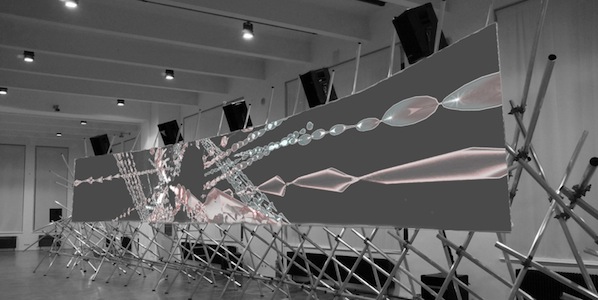
When experiencing the work I enjoyed the absence of narrative. Although I noticed some references alluding to concepts based on physics, and basic foundations of the universe. This led me to ask some questions to both artists about their “audiovisual research project”.
Robert Henke is active as composer, AV artist and professor in sound design at the University of Arts in Berlin. As founder and main member of his solo-project “Monolake”, he gained international reputation as one of the leading artists in the field of electronic club music culture. Henke has released more than twenty albums. His performances and installations have been shown and others at the Tate Modern in London, the Centre Pompidou in Paris, the PS1 in New York and the Experimental Media and Performing Arts Center (EMPAC) in Troy. His work “Layering Buddha” received an honorary mention at Ars Electronica in 2007.
Natascha Fuchs: “Fundamental Forces” is presented at sound:frame Festival this year and you worked on it together with Tarik Barri. How your collaboration has started?
Robert Henke: I was looking for Max programmer a few years ago. Tarik replied, but told me that he had no time for that, even if he would like to. However, later he sent me some video stuff he did and I thought that his work could be integrated into Monolake Live. That’s how it all came together.
NF: You call Fundamental Forces ‘an audiovisual research project’. What exactly do you call research? And how much of research involved into your life?
RH: The research part of it is simply the experimentation with the format: what kind of sound can be combined with which of Tarik’s visual ideas and vice versa. We try to find a common language. And since his work does not suggest a common narrative, we also need to come up with our own large scale structures. Where do we start, where do we stop? What kind of timeframes make sense? How can we shape transitions? Questions like this…
NF: You are involved into many different activities.. Is there anything what you like most of all? Music production, performing, visual ideas development, teaching students maybe? What gives you the feeling of ‘life is great and I am satisfied with everything’?
RH: This always changes, but I am most satisfied in moments when my own sense of achievement finds its counterpart in the perception of what I do in public. If I for myself gave a lecture which I felt was really good, and afterwards students come to me and share that notion, – I am happy. If I had a great day in the studio and afterwards play the music to some friends and they like it too, – I am happy. And if things simply do not work out the way I want to, if I have an idea, but every attempt to turn in into sound or visuals does not satisfy me, then I am most frustrated.
NF: You live in Berlin. How does the city and different generations grown up there change together with technology changes? You see many students probably for whom technology is something ready to use now, and it was different at a time when Ableton Live was not yet created..
RH: The biggest transition in general is from a situation that is characterized by a lack of tool in the early 1990s to the total abundance of tools in 2012. The question today is not: how do I do something, but rather: what am I really interested in? All is possible with current technology. Finding your personal language is the biggest challenge these days.
NF: Currently in the interview to Bleep you said that you have so many ideas to explore yourself in the next future. Could you share one of them, what is Robert Henke’s the next?
RH: The biggest project I am working on is a large scale laser and sound installation called ‘Fragile Territories’. It is a challenge in many ways; technically and artistically. I want it to be very good, it is an important work for me, and I still need to do a lot of research. Laser is a very limited media, and in order to create something that is more than a technology demo one needs to invest a lot of time thinking about what exactly to do with it and also find out how to make the best out of the limitations.
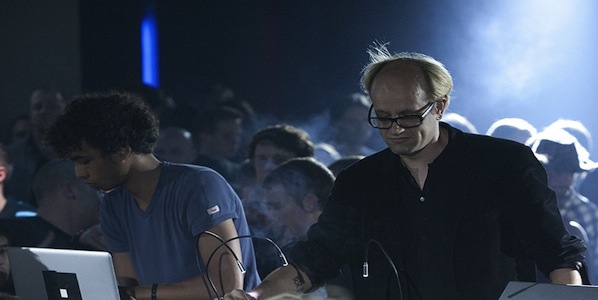
Tarik Barri is a Dutch audiovisual composer and software developer. He started programming at the age of seven and has been making electronic music since he was a teenager. After his first official musical releases at the age of twenty one, he quit his studies in biological psychology to pursue the study of music and technology at the Utrecht School of Music and Technology. During this studies he saw how the methods he used to create music could be adapted for the moving image. He programmed his own software to develop new tools for audio-visual performance, composition and data representation.
Natascha Fuchs: You live in the Netherlands, which is famous for successful promoting of media and digital arts/sound. Which Dutch institutions, festivals do you support?
Tarik Barri: I’ve been living in Berlin for a little while now, but definitely living in The Netherlands has been very very good for me to develop my work and my working methods. After I finished school, there was the WWIK, which is a government funding to help new artists develop their work. Also the Netherlands Foundation for Visual Arts, Design and Architecture helped me a lot by giving me a stipend to develop my work. Then there were organisations and festivals like TodaysArt, Sonic Acts and V2 that helped me introduce my work to the general public. Unfortunately many programs are getting cut these days in a new political climate where art in general seems to be regarded a left wing hobby for elitist snobs. Very sad, especially since I don’t agree that ‘art’ in general would be class related or have any specific political color.
NF: You were graduated from Utrecht School of Arts. What exactly did you study there?
TB: Within the Utrecht School of Arts I studied at their School of Music and Technology. And within thát school I graduated in Audio Design. It was the most technical study they had, where I learned about music programming, sound synthesis, acoustics, etc. Especially the programming courses in Max/MSP given by my teacher Marcel Wierckx inspired me to combine music, realtime visuals and programming into one discipline.
NF: What is your participation in collaboration with Monolake?
TB: Within Monolake the roles of Robert Henke and myself are clearly defined: he does the music, I do the visuals. But of course we discuss the visuals and music intensively together and there’s a constant dialog going on between both ourselves as individuals and the works that we produce. This continuous dialog has been of great value for my development in the last couple of years, both artistically and technically.
NF: The artwork which will be presented at sound:frame called ‘audiovisual research project’. What is this continuous research in your life, your aim in it?
TB: Both Robert and I constantly develop our own methods for the creation of music and visuals, and we research the aesthetical results that can be achieved through these methods. Through the combination of sound and visuals, I aim to create a sense of reality. To achieve this I’ve developed software that establishes 3d virtual audiovisual worlds. I then populate these realities with a multitude of objects of various shapes, sizes and other properties. Those objects behave according to laws taken from the real reality. While thus creating a completely new world, with its own sets of objects, elements of what we know can still be recognized within this virtual space. For me this contrast between the new and the known highlights the sense of wonder and possibility that emerges from the space between strict rules and the imagination that tries to defy and transform them. Through a window of strict and rigid laws we enter into infinite, colorful, playful, imaginary worlds.
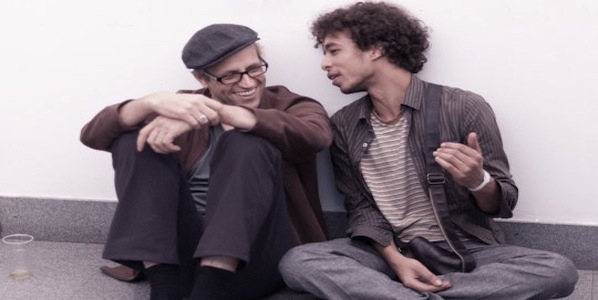
May / June 2012: Fundamental Forces in Canada, Montreal @ MUTEK Festival
Robert Henke aka Monolake: www.monolake.de
Tarik Barri: www.tarikbarri.nl
sound:frame Festival: www.soundframe.at
(c) Natascha Fuchs is independent expert in cultural projects management and international public relations, graduate of the University of Manchester (Cultural Management) in 2008. She has been living in Vienna, Austria, studying History of Media Arts at the Donau-Universität and collaborating with sound:frame Festival for audio:visual expressions, since her move from Moscow, Russia in 2011. In Russia she was related to MediaArtLab and Media Forum — the special program of the Moscow International Film festival dedicated to media arts, experimental films and digital context with more than 10 years history. As a researcher and practitioner, she works in a variety of topics and participates different international projects focused on media arts, cinema and sound. Columnist and writer for several online magazines.
Sign up: ale[at]furtherfield.org
To accompany Invisible Forces, Furtherfield invites all gallery visitors to take part in a programme of public play, games, making and discussion led by alert and energetic artists, techies, makers and thinkers: Class Wargames, The Hexists, Dave Miller, Olga P Massanet and Thomas Aston.
Saturday 23 June 2012 – 1-5pm
Summer Board Games and Picnic with Class Wargames and Kimathi Donkor
Saturday 30 June 2012 – 1-5pm
Summer Board Games and Picnic with Class Wargames
Wednesday 04 July 2012 – 9-11am
3 Keys – The River Oracle – The Hexists
as part of Moving Forest by AKA The Castle
Wednesday 11 July 2012 – 11-5pm
Technologies of Attunement – Olga P Massanet and Thomas Cade Aston
Saturday 21 July 2012 – 2-5pm
Dave Miller’s Finsbury Park Radiation Walk
Featured image: Sculptured relief of Roman soldiers fighting the barbarians.
Lies, Lawlessness and Disbelief 1. Thinking Art and Capital: Unknown Unknowns, is the second of five essays by Canadian artist & critical thinker, Katie McCain. McCain discusses how capitalism has become on the one hand all encompassing and on the other utterly unreal. Arguing that we need to be prepared to think the impossible so that resistance is able to grow.
DOWNLOAD the full text (including all 5 parts) here, or read part two below:
In 1942 the Ministry of Defense labeled Gruinard Island as X Base. It was an isolated island that had been deemed acceptable for testing the viability of an anthrax weapon, as it was unknown if the spores be able to survive the blast. An anthrax bomb was dropped on a herd of sheep kept in individual crates, their heads in hoods so they could not lick the spores. Of 15 sheep, only 2 survived. The test was repeated with less success as a change in wind direction caused the bomb to land in a peat bog where it sank. The test was moved to Wales. In 1981 operation dark harvest – led by a team of microbiologists – collected soil samples from Gruinard Island, which had since been quarantined. Their demand was for the government to decontaminate the island or the samples would be weaponized and distributed. Two samples were found outside a research facility in Porton Down, and in Blackpool, where the ruling conservative party were meeting.[1]
Unknown unknowns are intrinsic to this conceptual, contemporary capitalism, and operate as the risk that can eventually cause a system to fail. Failure emerges from the unprecedented, from the unthinkable, from the things you do not know you do not know.[2] Instead of attempting to predict these events for market gains, what would it mean to merely acknowledge the paradoxical nature of thinking the unthinkable? Unthinkable operates as the other to any thought capacity, and in an attempt to access this impossible, it would be possible to access a non-knowledge, something on the edge of logic, of research, of ideas.
Non-knowledge is not the same as ignorance, but rather references the other of the knowledge system itself, an indeterminate zone between knowledge and ignorance.[3] Huberman addresses this topic in the exhibition catalogue: For the Blind Man in the Dark Room Searching for the Black Cat that Isn’t There. The phrase was initially attributed to Charles Darwin’s description of a mathematician, but here is used to underscore the type of knowledge, the type of logic, that art explores. A work of art that isn’t. As a method of generating new forms of thinking and unknown circuits of consciousness, visual art often verges on logic.[4]
Quantum physics is constantly pushing the boundaries of the unknown. If these formulations, these theories, constitute the boundary of the known, imagine the possibilities contained in unknown unknowns. This of course is impossible, but in the impossible lays unimaginable possibilities. The acceptance of the fact that there are unknown unknowns and, like dark matter, they are invisible, but make up the majority, could operate as a placeholder for limitless possibilities.[5] The things we do not know are impossible, contradictory and badly behaved; the things, then, that we do not know we do not know could be more radical still in terms of reality and the perception of it –an impossibility for thought, but this is the heart of it, the possibilities contained in the impossible. It is fundamentally possible for anything to be true (or conversely false), to be known (or to be unknown)[6]. The more this point is exhumed the more amazing and simultaneously frustrating it can become.
Quantum reality proves that we can alter reality just by looking at it. Photons behave differently under scrutiny than when left to their own devices, which leaves us incapable of describing their behaviour.[7] Einstein asked physicist Niels Bohr if he really believed that the moon disappears when no one is looking at it, to which the retort was “can you prove otherwise?”[8] The answer is of course no, we are incapable of removing ourselves, of removing our relation to the thing-in-itself, of removing the impact of thought from suppositions of reality.
‘Quantum physics is an exciting theory because it is extremely precise, it is mathematically beautiful, it describes everything. It just doesn’t make sense.’[9]
Perhaps the language of mathematics is not a language invented in order to describe reality, but rather is the basis on which the physical world manifests, and slowly consciousness grasps more and more of this structure. If the theory is wrong, fundamental physics will hit a roadblock beyond which is it impossible to tread; if the theory is right everything is potentially understandable, dependant on thought’s capacity to understand.[10] These fundamentally opposite poles of reality offer, to us, the same plain of comprehension – the capacity of thought, the very limit of which we cannot pass.
Dreamwork, specters, illogic, the impossible – it is where thought begins to break down in terms of accuracy or coherent narrative that it begins to get interesting. On the fringes of thought lie truth, radicalism, subversion and change. And on the fringes of reality are lies, paradox and the imaginary. Does this mean that truth can be found in lies, paradox and the unreal?
The market depends on our belief in it, and our lack of faith can have catastrophic results. So bolstering collective belief in markets is the main strategy for their stabilization. But consciousness is not so simple; the market begins to rely not only on our belief in it, but in our belief in our belief in it[11], and so on ad infinitum. An infinite regress of belief created in order to prop up that self-same belief. How can consciousness continue to reconcile itself with this infinite regress? In quantum physics, observing photons can change how they behave. In the market, disbelief can cause it to collapse. A ping pong ball, by the time it’s bounced nine times factors the gravitational pull of a body standing next to the table into it’s bounce, by the 56th bounce ever single elementary particle of the universe has to be present in your assumptions [12]. In reality, many things are affected by human existence, but thought, or existence itself is not one of them.
It is not true that in order to live one has to believe in one’s own existence. There is no necessity to that. No matter what, our consciousness is never the echo of our own reality, of an existence set in “real time.” But rather it is its echo in “delayed time,” the screen of the dispersion of the subject and of its identity – only in our sleep, our unconscious, and our death are we identical to ourselves. Consciousness, which is totally different from belief, is more spontaneously the result of a challenge to reality, the result of accepting objective illusion rather than objective reality. This challenge is more vital to our survival and to that of the human species than the belief in reality and in existence, which always refers to spiritual consolations pertaining to another world. Our world is such as it is, but that does not make it more real in any respect. “The most powerful instinct of man is to be in conflict with truth, and with the real.”[13]
Asleep, unconscious or dead. These are the three options in which one is identical to oneself. But what does that mean? Harman discusses sleep as a lack of relations. We still exist as pieces that make a physical whole, but the thing we lack in sleep is relations. ‘Sleep is our closest approach to the freedom from relations in which we are most ourselves’[14]
An object, too, can be dormant. It is capable of existing apart from a specific situation, and therefore is capable of existing apart from any situation at all; therefore, it is relationless, or has the possibility to be relationless. Unlike objects, however, this dormancy is not so much a freedom from the world, as a dormancy to the world, withdrawn, incapable of anything else.
Yet, in a sense we are always inside the world through the fact that we are made up of pieces – and only therefore are we free, with our components doing the work of liberty on our behalf. For there is an excess in our pieces beyond what is needed to create us, and this excess allows new and unexpected things to happen.[15]
So perhaps seeking freedom in individuation, in isolation, as the linking of subject to object, in the perpetual delay of satisfaction that capitalism offers is the achievement of the exact opposite of the freedom sought. Perhaps the individual freedom presented by capital and democracy is in fact a relationless sleep that removes the other, the alternative, removes the opportunity for change, and ultimately time itself.
sl
sle
slee
sleep
Freudian kettle logic is an example, a joke employed by Freud to explore the mind’s capacity for self-deception. It is this logic, or rather this illogic that some manages to access the impossible. Kettle logic refers to the thought process of a mind on the defensive. It shows the impossibility of thought or rather it’s circular nature, that manages to disregard laws of non-contradiction. It goes as follows:
A neighbour is accused of borrowing a kettle and returning it with a hole. He answers simultaneously that 1) he did not borrow the kettle; 2) it was unbroken when he returned it, and 3) that it was broken when he borrowed it.[16]
Freud uses this to unpack dream logic, during which time mutually exclusive answers or states can easily co-exist. “Wendy Brown says that dreamwork provides the best model for understanding contemporary forms of power. It produces a confabulated consistency that covers over anomalies and contradictions”[17]. Žižek uses Freudian kettle logic to explain the U.S.’s right to wage war on Iraq, and the notion of the pre-emptive strike, which renders events of the future to a fictional or probabilistic past.[18]
Žižek also argues:
If we postpone our action until we have full knowledge of the catastrophe, we will have acquired that knowledge only when it is too late. The certainty on which to act is never a matter of knowledge, but a matter of belief. If, accidentally, an event takes place, it creates a preceding chain which makes it appear inevitable – Hegelian dialectic of contingency and necessity. In order to confront a disaster – we should accept it as fate, as unavoidable, and then retroactively insert into the past of the future possibilities on which to act in the present.[19]
This is frighteningly similar to the rhetoric of war used by the right, but employed by the left with regard to environmental disaster. Both the right, and the quite radical left in this instance, are using the same logic of prediction to validate an action. The difference, it seems, is Žižek’s disbelief, or awareness of the impossibility of a situation that requires action despite the fact that the specifics of the situation itself are still largely unknown.
Link to first article
https://www.furtherfield.org/lies-lawlessness-and-disbelief-1/
Adorno, Theodor.W. Negative Dialectics. Translated by E.B. Ashton. New York: Continuum, 2005. First Published 1966 by Suhrkamp Verlag.
Associated Press. “Romanian Witches Curse Latest Government Clampdown,” The Guardian, February 9, 2011, main section, 20.
Bartlett, Monica Y., Aida Cajdric, Nilanjana Dasgupta and David DeSteno, “Prejudice from Thin Air: The Effect of Emotion on Automatic Intergroup Attitudes.” Psychological Science 15, no. 5 (May, 2004): 319-324.
Baudrillard, Jean. Global Debt and Parallel Universe. Translated by Francois Debrix. http://www.egs.edu/faculty/jean-baudrillard/articles/global-debt-and-parallel-universe/ (accessed April 4, 2011).
Baudrillard, Jean. Radical Thought. Translated by Francois Debrix. Edited by Sens & Tonka. Paris: Collection Morsure, 1994.
Bey, Hakim. T.A.Z.: Temporary Autonomous Zone, Ontological Anarchy, Poetic Terrorism. New York: Autonomedia, 2003. First Published 1985.
Bradley, Will. “Guarana Power.” in Self-Organization/Counter-Economic-Strategies, edited by Bradley, Hannula, Ricupero and Superflex, 311 – 333. New York: Steinberg Press, 2006.
Brassier, Ray. “I Am a Nihilist because I Still Believe in Truth” Interview with Marcin Rychter. Kronos: March 4, 2011 http://kronos.org.pl/index.php?23151,896 – accessed: march 23rd, 2011.
Brassier, Ray. Nihil Unbound: Enlightenment and Extinction. Basingstoke: Palgrave McMillan, 2007.
Critical Art Ensemble. Marching Plague: Germ Warfare and Global Public Health. New York: Autonomedia, 2006.
Declercq, Frédéric. Lacan on the Capitalist Discourse: Its Consequences for Libidinal Enjoyment and Social Bonds. Psychoanalysis, Culture & Society 2006, 11, (74-83).
Fisher, Mark. Capitalist Realism: Is There No Alternative? Winchester: Zero Books, 2009.
Foucault, Michel. Power/Knowledge: Selected Interviews & Other Writings: 1972-1977. New York: Pantheon Books, 1980.
Fromm, Erich. The Fear of Freedom. London: Routledge & Kegan Paul Ltd., 1966.
Groys, Boris “Art and Money,” E-Flux 24 (2011), http://www.e-flux.com/journal/view/226.
Harman, Graham. Circus Philosophicus. Winchester: Zero Books, 2010.
Hofstadter, Douglas R. Gödel, Escher, Bach: An Eternal Golden Braid. London: Penguin Books Ltd., 1979.
Holt, Jim. “The Way We Live Now: Against Happiness,” New York Times, June 20, 2004.
Horizon: What is Reality? Documentary. Directed by Helen Shariatmadari. BBC: ep. 9, 2011.
Huberman, Anthony, ed. For the Blind Man in the Dark Room Looking for the Black Cat that Isn’t There. St. Louis: Contemporary Art Museum St. Louis, 2009.
Huxley, Aldous. Brave New World. London: Vintage Books, 2007. First published 1932 by Chatto & Windus.
K-Punk Blog. http://k-punk.abstractdynamics.org/archives/004421.html
Kafka, Franz. The Castle. Middlesex: Penguin Books Ltd., 1964. First published 1926 by Das Schloss.
Kurant, Agnieszka and Nassim Nicholas Taleb. “Unknown Unknowns: A Conversation between Agnieska Kurant & Nassim Nicholas Taleb about the Benefits of Uncertainty.” Frieze, September 2010, 127 -135.
Lacan, Jacques. “Seminar on the Purloined Letter.” Yale French Studies 48 (1972): 39-72.
Lacan, Jacques. The seminars of Jacques Lacan: Book II: The Ego in Freud’s Theory and in the Technique of Psychoanalysis 1954-1955. Ed: Jacques-Alain Miller. New York: W. W. Norton and Co., 1991.
MacKinnon, Catharine A. “Feminism, Marxism, Method and the State.” Chicago Journals 8, no. 4 (1983), 635-658.
Meillassoux, Quentin. After Finitude: An Essay on the Necessity of Contingency. London: Continuum, 2008.
Mouffe, Chantal. The Democratic Paradox. London: Verso, 2000.
Noys, Ben. Persistence of the Negative: A Critique of Contemporary Continental Theory. Edinburgh: Edinburgh University Press, 2010.
Place, Vanessa and Robert Fitterman. Notes on Conceptualisms. New York: The Ugly Duckling Presse, 2009.
Stephen, Kylie. “Sexualized Bodies.” in Real Bodies: A Sociological Introduction, edited by Evans and Lee, 29-45. Basingstoke: Palgrave MacMillan. 2002.
Taleb, Nassim Nicholas. The Black Swan: The Impact of the Highly Improbable. London: Penguin Books Ltd., 2007.
Thacker, Eugene. “Nihil Unbound” review of Nihil Unbound: Enlightenment and Extinction, by Ray Brassier, Leonardo 42: no.5, (2009): 459-460, http://muse.jhu.edu/journals/leonardo/v042/42.5.thacker.html (Accessed April 2, 2011).
The Trap: What Happened to Our Dream of Freedom? Documentary. Directed by Adam Curtis. BBC Two: March 2007.
Trotta, Roberto. “Dark Matter: Probing the Arche Fossil.” Interview with Robin Mackay. Collapse: Philosophical Research and Development 2 (2007): 83-169.
Vidal, John. “Bolivia Enshrines Natural World’s Rights with Equal Status for Mother Earth.” The Guardian. April 11, 2011. Main section, 15.
Weaver, Matthew. “Romanian Witches to Cast Anti-Government Spell.” The Guardian. January 7, 2011. Main section, 23.
Wilson, Eric G. Against Happiness. New York: Sarah Critchton Books, 2008.
Žižek, Slavoj. First as Tragedy, Then as Farce. London: Verso, 2009.
Žižek , Slavoj. The Iraqi Borrowed Kettle. http://www.lacan.com/zizekkettle.htm (accessed April 4, 2011).
Žižek, Slavoj. What Rumsfeld Doesn’t Know that He Knows About Abu Ghraib. (2004) http://www.lacan.com/zizekrumsfeld.htm (accessed April 4, 2011).
Contact: info@furtherfield.org
DOWNLOAD FULL PRESS RELEASE HERE
See images from the opening of Invisible Forces on Flickr.
Scroll down for the video of the exhibition.
An exhibition about why contemporary life is so difficult for so many
Invisible Forces features the work of artist-visionaries: Kimathi Donkor, Laura Oldfield Ford, IOCOSE, Dave Miller, Edward Picot, and YoHa with additional game events, talks and workshops with Class Wargames, The Hexists, Olga P Massanet and Thomas Cade Aston.
Our social, economic and cultural institutions are being dismantled. Control over the provision of social care, urban and rural development, and education is being ceded to the market facilitated by unseen technological and bureaucratic systems.
Undeterred, the artists in this exhibition meet the challenges that ensue with clear eyes, spontaneity, experimentation and a sense of adventure. This selection of installations, digital video, net art, painting and drawings deal with conspiracy, money, politics and hidden signals.
As part of Invisible Airs, YoHa (Graham Harwood & Matsuko Yokokoji) attempted to read 20,000 comma separated lines of Bristol City Council’s apparently open-data. After which they understood that power reveals itself through multiple layers of boredom. They constructed four pneumatic contraptions which reveal the relations contained within the fields and the people affected. A video made by Alistair Oldham documents their art project Invisible Airs, Database, Expenditure & Power. Invisible Airs was commissioned by The University of the West of England’s Digital Cultures Research Centre (DCRC) in collaboration with the Bristol City Council’s B Open data project.

This is shown alongside Data Entry, a video that investigates how databases operate on us and through us by looking at the work of midwives and women in labour. “Databases move through us, allowing new forms of power to emerge… [they] order, compare, sort and create new views of the information they contain. New perspectives amplify, speed-up and restructure particular forms of power as they supersede others.”
Edward Picot is an artist and writer who also works as an administrator in the UK health service. His seriously funny soap-gone-wrong, Dr Hairy In…, chronicles the trials, tribulations and cogitations of an ordinary (but slightly hirsute) general practitioner – with hilarious results!* Dr Hairy’s struggles with NHS bureaucracy are brought to life in a series of satirical video shorts, featuring puppetry performances given by a child’s doll and screened in a doctor’s waiting room, as an installation. “It was like watching Team America set in the NHS” says Ian Hislop (broadcaster, editor of Private Eye and NHS patient).
Kimathi Donkor‘s Toussaint Louverture at Bedourete is a history painting made with oils on canvas that depicts an icon of anti-slavery struggles who, in his lifetime, was smeared as a reprehensible war lord. Created to mark 200 years since the independence of Haiti, the image shows the leader of the Haitian 1791-1804 revolution in a pose reminiscent of the Jacques Louis David’s Napoleon Crossing the Alps, surrounded by inspired revolutionaries in a battle that led to the creation of Haiti as the first slave free nation in history. In a short film by Ilze Black, Dr Richard Barbrook and Fabian Tompsett of Class Wargames interview Donkor about the work.
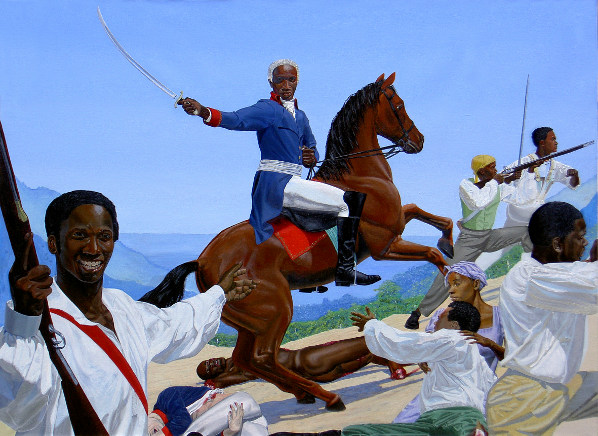
Laura Oldfield Ford‘s recent drawings are the result of walks (or ‘Drifts) through deserted urban spaces in the part of East London being prepared for the 2012 Games. They depict layers of failed utopias of the past and present and imagined futures. Known for her poetic and politically tuned ink drawings produced in print and online in her zine Savage Messiah, Oldfield Ford documents her psychogeographic explorations, in text and image, of the city as a site of social conflict, melancholy and political resistance.

Net artist Dave Miller presents two agitprop posters and a pamphlet of images reproduced from his interactive, multi-layered, online narrative bankers_bonuses. Miller worked with software he created himself to combine hand drawn illustrations with images gathered from Internet searches, and provocative (sometimes preposterous) statements made by powerful people about the ethical questions arising from the economic crisis.
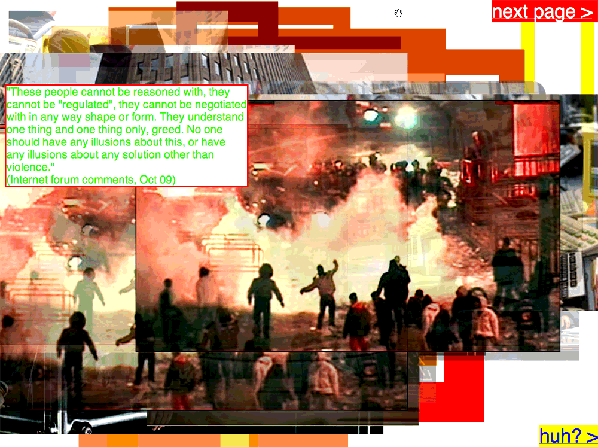
Italian artist group IOCOSE has created A Crowded Apocalypse, a net art project that exploits crowd sourcing tools in order to simulate a global conspiracy. The “crowd” assembles its own conspiracy and then protests against its protagonists and effects. A Crowded Apocalypse is commissioned by AND Festival and Furtherfield.
As we scan our cultures for maps, role-models, possible ways of living in today’s world, we often encounter images of society that are created by its hidden, controlling forces. By naming, revealing, tracking, playing, making, subverting and transforming tools, circumstances and figures that give rise to current crises we enlarge the debate and extend our freedoms. And the artists in this exhibition offer examples of just some of the ways in which this might be done.
* Important note. Dr Hairy In… is NOT a critique of socialised medicine and so we include a disclaimer: “The creators of this piece would like to point out that they all work in the National Health Service and are completely devoted to it.”
Free public play, games, making and discussion run alongside the exhibition.
Led by Dave Miller, The Hexists, Class Wargames, Olga P Massanet and Thomas Cade Aston. See HERE for details.
Rachel Baker (The Hexists)
Rachel Baker is a network artist who collaborated on the influential irational.org. Her art practice explores techniques used in contemporary marketing to gather and distribute data for the purposes of manipulation and propaganda. Networks of all kinds are “sites” for Baker’s public and private distributed art practice, including radio combined with Internet (Net.radio), mobile phones and SMS messaging, and rail networks.
Kayle Brandon (The Hexists)
Kayle Brandon is a inter-disciplinary Artist/researcher, whose work is sited within the public, social realm. She predominantly works in collaborative and collective fields; a working method which informs much of her ethos around the making of art. Her main areas of interest are in the relationships between the natural and urban worlds and Human/Non-human relations. She investigates this field via physical intelligence, provocative intervention, observation, self-guided exploration and collective experiences.
Class Wargames
Class Wargames is an avant-garde movement of artists, activists, and theoreticians engaged in the production of works of ludic subversion in the bureaucratic society of controlled consumption.
The members of Class Wargames are Dr. Richard Barbrook, author and senior lecturer in the Department of Politics & IR at the University of Westminster; Rod Dickinson, artist and lecturer at University of the West of England; Alex Veness, artist and co-founder of Class Wargames;Ilze Black, media artist and producer; Fabian Tompsett, initiator of London Psychogeographical Association and author; Mark Copplestone, author and figure designer; Lucy Blake, Software developer; Stefan Lutschinger, lecturer, artist and researcher; and Elena Vorontsova, World Radio Network and journalist.
Kimathi Donkor
Kimathi Donkor lives and works in London. He attained his B.A. at Goldsmiths and an M.A. at Camberwell College of Art, both in Fine Art. In 2011 he received the Derek Hill Award painting scholarship for the British School at Rome; and, in 2010, his paintings were exhibited in the 29th São Paulo Biennial, Brazil.
IOCOSE
IOCOSE has been working in Italy and Europe since 2006. It organises actions in order to subvert ideologies, practices and processes of identification and production of meanings. It uses pranks and hoaxes as tactical means, as joyful and sound tools. IOCOSE thinks about the streets, Internet and word of mouth as a battlefield. Tactics such as mimesis and trickery are used to lead and delude the audience into a semantic pitfall.
Dave Miller
Dave Miller is a South London based artist and currently a Research Fellow in Augmented Reality at the University of Bedfordshire. Through his art practice Dave draws out the invisible forces that make life difficult. His work is about caring and being angry, as an artist. His art enables him to express feelings about the world, to attempt to explain things in a meaningful, yet subjective way, and make complexed information accessible. Recurrent themes in his work are: human stories, injustices, contentious issues and campaigning. Recently he’s been very bothered by the financial crisis.
Laura Oldfield Ford
Laura Oldfield Ford lives and works in London. She studied at the Slade School of Art and completed her MA Painting at the Royal College of Art. She has exhibited extensively including Rokeby and Hales galleries in London, Savage Messiah takes over Late at Tate Britain, The Arnolfini, Bristol , De Appel Amsterdam and the Goethe Institute, New York. She has also recently been commissioned by Art Review. She is currently working on new projects for the Shenzhen Sculpture Biennial in China, the 2012 Gwangju Biennial and the show ‘Desire Paths’ at the Caja Madrid in Barcelona. A compilation of her zine ‘Savage Messiah’, which documents her psychogeographic drifts through London, is available on Verso books.
Edward Picot
Edward Picot was born in 1958. He lives in Kent with his dog, wife and daughter, not necessarily in that order. He earns his living as a Practice Manager in a doctor’s surgery, and in his spare time he does creative things – usually at the low-tech end of the new media spectrum. He started the Dr Hairy series – humorous short puppet-videos about a fictional doctor, closely based on his own experiences of working in the NHS – in 2010.
YoHa
Graham Harwood and Matsuko Yokokoji (YoHa – English translation ‘aftermath’) have lived and worked together since 1994.
YoHa’s graphic vision, technical tinkering, has powered several celebrated collaborations establishing an international reputation for pioneering critical arts projects.
Harwood and Yokokoji’s co founded the artists group Mongrel (1996-2007) and established the MediaShed a free media lab (2005-2008). In 2008 they joined Richard Wright to produce Tantalum Memorial shown in 9 countries and 15 cities over 4 years. In 2010 YoHa produced Coal Fired Computers before embarking on a series of works about the lived logics of database machinery including Invisible Airs, Data Entry in 2011 and Endless War in 2012.
Furtherfield Gallery
McKenzie Pavilion, Finsbury Park
London N4 2NQ
T: +44 (0)20 8802 2827
E: info@furtherfield.org
Furtherfield Gallery is supported by Haringey Council and Arts Council England
Dave Miller’s bankers_bonuses is supported by KAY MOUNTING.
Featured image: Ein Identity-Workshop mit dem britischen Künstler Heath Bunting. Vertiefung Mediale Künste, Sihlquai 131, 8005 Zürich. Dienstag,
Whether Bunting is climbing trees, skateboarding, canoeing or working with technology he approaches it all with the same critical attention. He hacks around systems, physical or digital. Right from when he built his first computer at the age of 14, his life has been an experimental research project. His practice consists of a dry sense of humour and an edgy, minimal-raw aesthetic, mixed with a hyper-awareness of his own artistic persona and agency in the world, whilst engaging with complex political systems, institutions and social contexts.
Even though the subjects he explores are likely to be the most topical or important issues of the day, it always includes playfulness and an element of the prankster in his work. His work regularly highlights issues around infringements on privacy or restriction of individual freedom, as well as contexts concerning the mutation of identity, our values and corporate ownership of our cultural/national ‘ID’s’, as well as our DNA and investigations into Bio-technologies. In an age where we are submersed in frameworks and protocols designed by a neo-liberal elite for a generic consumer class, Bunting’s work is well placed as observation and practical research into the ‘depths’ of legal and illegal territories in our contemporary, networked cultures.
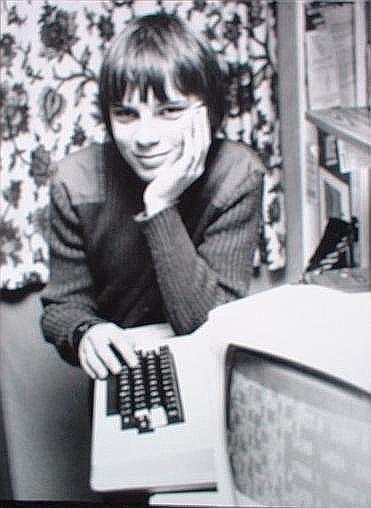
“our identity is constructed as human beings that can possess one or more natural persons and control one or more artificial persons. The higher up in the class system the better the access to status variety.”(Bunting)
The Status Project, is a study of the construction of our ‘official identities’ and creates what Bunting describes as “…an expert system for identity mutation”. His research explores how information the public supplies in their interaction with organisations and institutions is logged. The project draws on his direct encounters with specific database collection processes and the information he was obliged to supply as a public citizen to access specific services; this includes data collected from the Internet and information found on governmental databases. This data is then used to map and illustrate how we behave, relate, choose things, travel and move around in social spaces. The project surveys individuals locally, nationally and internationally, producing maps of “influence and personal portraits for both comprehension and social mobility”.
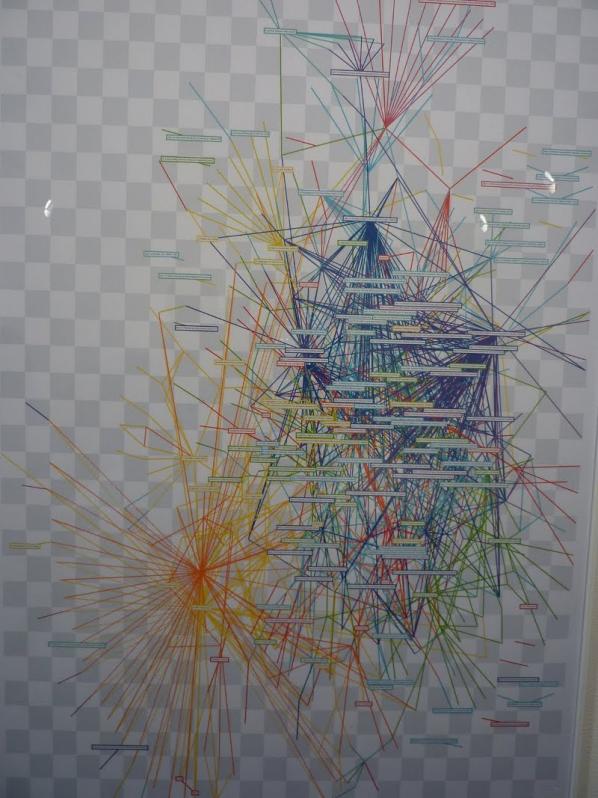
The use of data in contemporary life has made individuals an accessible resource for commercial and political interests. We are a rich source of data-mining material. Data mining is a process that potentially commodifies our interactions. Its historical roots lie with the development of artificial intelligence (AI) and 20th Century statistical analysis. These two methods of formulating data have grown ever closer together, backed by corporations and government-initiated military funding. Social networks such as platforms like Facebook and Internet networked institutions such as Google and the US military are all obsessed with our behaviours online. A good example is the NSA’s recent rebirth in turning most of its surveillance apparatus to spy on the US and its citizens. They have built a supercomputer tracing through billions of people’s emails, phone calls, and online activities in other countries outside of the US. The UK government is currently going through the political process of trying to implement similar spying protocols and systems to watch what UK citizens are up to.[2]
“Google suffers from data obesity and is indifferent to calls for careful preservation. It would be naive to demand cultural awareness. The prime objective of this cynical enterprise is to monitor user behaviour in order to sell traffic data and profiles to interested third parties.” [3] (Lovink)
Bunting is a Hacktivist Artist, acting (playing) out the role of a spy collecting and observing data content. Hacktivist Artists work with technology to explore how to develop their critical and imaginative practice in ways beyond the frameworks of the art establishment and its traditions. The established art arena is gradually catching up with this kind of artwork. However, one could be forgiven for thinking that many art critics and galleries are still caught in the 20th Century.
Two other artists also working on people’s data are Julian Oliver and Danja Vasiliev. They have collaborated on exploring alternative identities as the mysterious group, Men in Grey.[4] They detect online users’ vulnerabilities by tapping into and intervening in wireless network traffic – observing, tracing and copying user online activities. It is then redisplayed online on their website for others to view or transferred onto a visual screen on the side of a briefcase as an intervention in cybercafes for all to view. Although, no one knows other than themselves if the data is hacked and then redisplayed on these briefcases, as proposed in their video featuring one of their interventions. One thing is for sure – they have touched upon issues concerning our fears about personal data being seen by other people who we’d prefer were not viewing it.
The Status Project also taps into questions concerning technology, hierarchy and power. We are entwined in a complex game where the sacrifice of our information is part of connecting with others across digital networks. This raises the issue of our ‘human’ status being aligned ‘to and as’ objects of measurement. Through travel ports, our vehicles, passports, ID cards, library cards, mobile phones, alongside information about our health. We have mutated into networked (information-carrying) beings. Bunting’s own position on this matter is that “Technology is becoming more advanced and the administration of this technology is becoming more sophisticated, and soon, every car in the street will be considered and treated as persons, with human rights. This is not a conspiracy to enslave human beings, and it is a result of having to develop usable administration systems for complex relationships. Slaves were not liberated because their owners felt sorry for them; slaves were given more rights as a way to manage them more productively in a more technologically advanced society.”[5]

In the UK, in 2006 a research document called ‘A Report on the Surveillance Society For the Information Commissioner’ was published. Produced by a group of academics called the Surveillance Studies Network. This report was presented to the 28th International Data Protection and Privacy Commissioners’ Conference in London, hosted by the Information Commissioner’s Office. The publication begins by saying “Conventionally, to speak of surveillance society is to invoke something sinister, smacking of dictators and totalitarianism […] the surveillance society is better thought of as the outcome of modern organizational practices, businesses, government and the military than as a covert conspiracy. Surveillance may be viewed as progress towards efficient administration, in Max Weber’s view, a benefit for the development of Western capitalism and the modern nation-state.”[6]
We are not only under surveillance by entities we do not trust, we are also tracing each other online. Recently, in a show called ‘Being Social'[7] at Furtherfield’s new gallery, artist Liz Sterry showed her installation piece, ‘Kay’s Blog’. Sterry had “collated not only one form of online social engagements but all she could find about a Canadian blogger called Kay. Using everything from photographs to things Kay has mentioned in videos, blogs and posts on social networks, Sterry has recreated Kay’s bedroom in the gallery.”[8] (Scott)

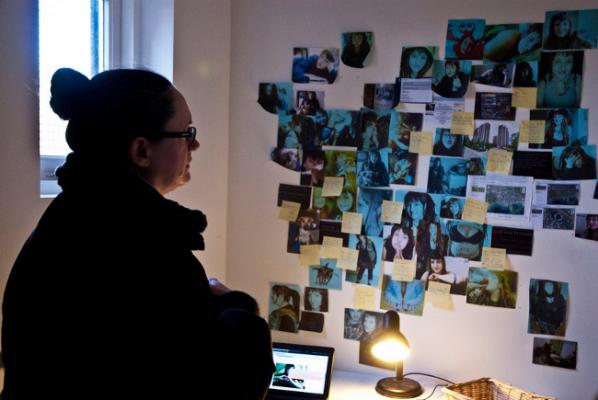
“”There were times when I felt quite creepy,” says Liz, 28, as she shows me lists of Kay’s Facebook friends and a Google Streetview of her apartment block while a playlist of her favourite songs plays in the background.”[9]
Yet, as this ever-creeping surveillance culture grows and attaches its all seeing eyes onto us all. Whether we are referring to domestic interactions, organizational or deliberate, this is not the main issue. Neo-liberalism has developed so much now, we are all part of the Netopticon. English philosopher and social theorist Jeremy Bentham in the late Eighteenth Century designed the Panopticon. It allowed officers in institutions, particularly in prisons, to observe (-opticon) all (pan-) inmates without them knowing whether or not they are being watched. In the end it was not built, but the French philosopher Michel Foucault in his publication Discipline and Punish: The Birth of the Prison,[10] in 1975 said that we are not only monitored in prisons, but in all hierarchical structures like the army, schools, hospitals and factories. This process has evolved through history to resemble Bentham’s Panopticon. The up-dated version of Panopticon, can now be thought of as the Netopticon – where individuals are complicit in feeding their own forms of collective co-surveillance, as well as being traced by corporations, governments and spammers.

“What your data body says about you is more real than what you say about yourself. The data body is the body by which you are judged in society, and the body which dictates your status in the world. What we are witnessing at this point in time is the triumph of representation over being. The electronic file has conquered self-aware consciousness.” [11] (Critical Art Ensemble)
So far, for the project he has created a functioning, sketch database of the UK system with over 10,000 entries – made over 50 maps of sub-sections of the system to aid sense of place and potential for social mobility. Bunting says he is also researching how to convert his identity generating software into a bot recognised under UK law as a person “covered by the human rights act i.e. right to life and liberty; freedom of expression; peaceful enjoyment of property. I am very close to achieving this.”
This bring us to another part of the project what I call ‘Identity Kits’, and Bunting calls ‘Synthetic off-the-shelf (OTS) British natural person’.[12] These kits consist of various items, personal business cards, library cards, a national railcard, t-mobile top-up card, national lottery card and much more. They take a few months to compile each of them because they are actual items that everybody uses in their everyday lives, involving evidence of identity. There is also a charge for the package of 500.00 GBP, which is cheap for a new identity.
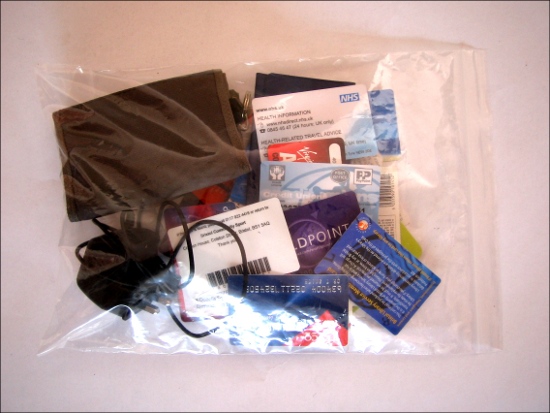
Bunting stresses that these UK identities are lawful and that there is no need for any official consulting or permission from an authority to use or make them. Through this he intends to illustrate a precise codification of class in the UK system. Currently, he defines three classes of identitiy: human being, person and corporate. What class of individual you are places you into categories of evaluation, this process allows others to judge your status, worth and value, within a hierarchy, which is clearly represented in the status maps.
This work touches on issues around our everyday status as a critique, but also as an investigative hack, and plays around with the quagmire of inequality currently in the UK. Inequality is built, constructed into the fabric our societies as an accepted default, through tradition, social or mechanistic, holding in place societal divisions. If there was a status project made in other countries reflecting their own status, worth and value of citizens there would be clear links defining where the connections and divisions lie, between each culture. In fact, another project worth mentioning here is ‘The Spirit Level: Why More Equal Societies Almost Always Do Better’. [13] The authors Richard Wilkinson and Kate Pickett have done their own ‘extensive’, detailed research in highlighting through many different graphs, mapping out inequality around ther globe.
“We know there is something wrong, and this book goes a long way towards explaining what and why.” [14] (Hanley)
Bunting’s work expresses a discipline conscious of agency, autonomy and enactments for self and collective empowerment. Hacking different routes around what at first is seen as too big to deal with, lessens its power and awe. Like Burbank in the ‘The Truman Show’, what we have been told is not real. Bunting knows this instinctively, and is on a quest to upturn each stone to see what lies beneath. But at the same time these facilities created to crack the social, and data orientated codes, are shared. He then leaves the paths he has discovered wide open for others pass through, as we all struggle to survive the ever creeping strangle-hold, of the Netopticon.
———————————————————————-
This article was written for and will be published as part of Heath Bunting’s presentation in Athens ‘Workshop How to Build a New Legal Identity’, May 5th 2012.
During the workshop, Heath Bunting will introduce us to techniques and strategies on how to form new identities. The distribution of the workshop How to Build a New Legal Identity across Europe aims at exploring the characteristics of identity in each country.
Artist’s Talk: May 4, 2012 @ 19.00
Workshop How to Build a New Legal Identity: May 5, 2012 @ 12.00
Frown Tails, 6 Paramythias str, Keramikos, Athens
Organised by: Katerina Gkoutziouli and Frown Tails
Featured image: Environmental Risk Assessment Rover – ERAR – AT (2008) Mobile, Solar Powered, Networked Installation Off the Grid, Neuberger Mus
Refusing to regard technology merely as a tool, Ecoarttech expand the uses of mobile technology and digital networks revealing them to be fundamental components of the way we experience our environment. Their most recent work Indeterminate Hikes + (IH +) is a phone app that maps a series of trails through the city. IH + can be accessed globally, or wherever users have access to Google Maps on their mobile phones. After identifying the users’ location, IH + generates a route along random “Scenic Vistas” within urban spaces. Users are directed to perform a series of tasks along the trail and provide feedback in the form of snapshots generating an ongoing, open-ended dialogue.
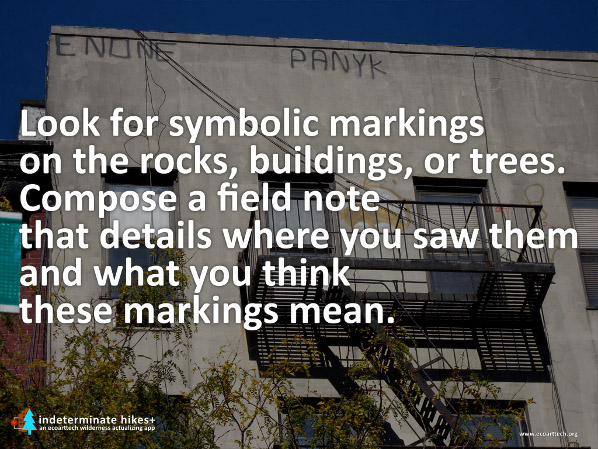
But the experience of their work is primarily an encounter with technology. Since 2005, Leila Nadir and Cary Peppermint of Ecoarttech have been engaged in an artistic exploration of environmental sustainability and convergent media. By drawing our attention to the increasing replacement or mediation of physical experiences by technology, Ecoarttech challenge the widely reproduced distinction between nature and culture. They present their work in the form of videos, digital networks, blogs, performance and installations. Their early video-based work (Wilderness Trouble and Frontier Mythology) plays out a performative and ironic encounter with the natural environment as a historically constructed concept. In the summer of 2005 Ecoarttech made A Series of Practical Performances in the Wilderness (2005) a database networked performance in QuickTime (DVD and Podcast). The short clips document what Ecoarttech ironically describe as “the experiences of two New Yorkers embarking on their first four months in the woods“. Their objectives were nothing short of
…establishing a functional home without running water, electricity, or maintained roads; developing relationships with locals; un-learning the romanticization of nature while re-learning humanity’s dependence on the environment for survival; and researching the details of the history of the land and the surrounding area.
Sophia Kosmaoglou: The confrontation with the concept of “wilderness” appears to motivate much of your work to date. How did A Series of Practical Performances in the Wilderness begin and how did you fare?
Leila Nadir and Cary Peppermint: About eight years ago, we were very fortunate to acquire a primitive cabin on 50 acres of wild, wooded land, and the experiences we had there changed us completely. Each time we drove from NYC to our “camp” as the locals called it, we were immobilized for about 3-4 days, hardly able to move our bodies as our nervous systems screeched to a halt, adjusting to the quiet. We found a freedom in the woods that we couldn’t find the city – the freedom to take up space, to play, to be quiet, slow, and still. We were also amazed by how some people in the country could seemingly live more independently from bloated global economic systems, growing their own food, chopping their own fuel, harvesting solar energy. They interacted directly with the natural environment whereas we had spent our entire lives ecologically infantilized by overdependence on the industrial grid. We began spending several months at a time at our cabin in the woods: A Series of Practical Performances in the Wilderness is a document of our environmental adventures at that time. It was our first attempt at making art in remote, wilderness spaces. It was a sort of performance of ecological/cultural collision.
SK: How did this experience inform your subsequent work?
LN & CP: As we began to study environmental theory, we realized that not only does little “true” wilderness actually exist, the myth of wilderness was used to obscure the history of indigenous people living on the North American continent. Our own land, we learned, had once been a pasture and had been logged numerous times. Coming to terms with the fact that we hadn’t really retreating to “nature” was the focus of our video Wilderness Trouble which attempts to imagine a new kind of environmental ethics that includes urban and electronic spaces and modern networked culture. However, we still believe that wilderness provides a lot of imaginative potential. Amazement at sublime landscapes can provoke an emotional response that can be politically motivating, and we have tried to take advantage of that potential in our smartphone app Indeterminate Hikes +. By importing the rhetoric of wilderness into everyday life through Google-mapped hiking trails, the app attempts to inspire a sense of ecological wonder at usually disregarded spaces, such as city sidewalks, alleyways, and apartment buildings. We wanted to see what would happen if a walk down a sidewalk were treated as a wilderness excursion. What if we consider the water dripping off an air-conditioner with the same attention that we give a spectacular waterfall in the wilderness?
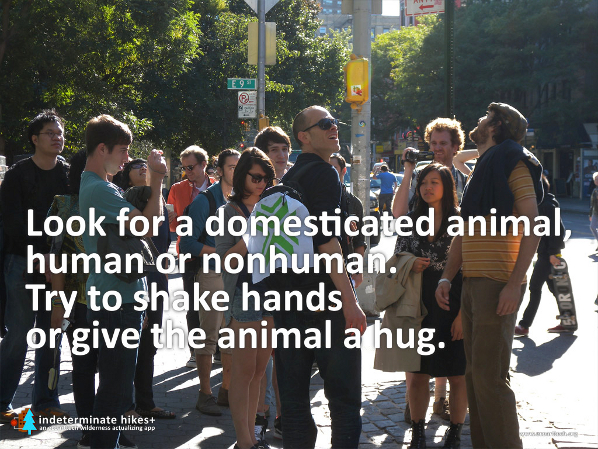
SK: There is a recurring effort in your work to question the opposition between environment and technology, which is usually accompanied by an ironic undercurrent in your narration and editing that acknowledges what you call “cultural collision”. In Google is a National Park and Nature is a Search Engine which is also part of a series of performances called Center for Wildness in the Everyday (2010), itself conceived as an ecosystem, you suggest that an “environment” is a network of relationships common to natural as well as technological systems, whether it is the ecosystem of a river estuary or Google. Do you see this as a sustainable analogy or a productive contradiction?
LN & CP: Part of what we find frustrating about a lot of environmental thought is that it either wholly rejects technology as the cause of ecological crises so our only solution is to go primitive or wholly embraces technological progress as a saviour, which often means we have to trust in corporate and scientific innovation to lead the way. We think there is another way. We see humans as essentially technical beings: human-animals literally cannot survive without technics. The U.S. military survival guide comes right out and admits that your situation is pretty hopeless if you are stranded in the wilderness without at least a knife. If technology is part of who we are – and we find Bernard Stiegler’s work helpful for thinking this through – then we have also evolved with technology. We are not the same sorts of humans as, for example, Leila’s great-grandmothers in Slovakia or Afghanistan a century ago. The question, then, is not, Yes or No to Technology, but rather, How do we engage technology sustainably and in a way that supports creativity and freedom? And if human beings are technical beings, relying on nature and culture simultaneously, is it even possible to distinguish between what’s natural and what’s not? Isn’t our sustenance dependent upon not only our biological needs (clean air, water and food) but also our cultural practices, beliefs, and imagination? This is why we find it essential to think about electronic spaces and digital technologies whenever we think about the “environment.”
The installation called Google is a National Park and Nature is a Search Engine, a work that is part of a series of performances called Center for Wildness in the Everyday commissioned by the University of North Texas. Our task for this commission was to create a networked artwork about the Trinity River Basin, the source of water for the Dallas/Fort Worth metroplex. In the image, the Trinity River looks like a space of natural refuge but the scientists we worked with there explained that the River’s flow is guaranteed only by the recycling of waste water at treatment plants. We wanted to create a work that juxtaposed this hidden constructedness of “nature” with the more obvious man-made Google – two processes or entities that we rely on everyday for our ecological sustenance: water management and online information.
SK: In 2008, you made the Environmental Risk Assessment Rover, a solar-powered module, which gathers and projects information regarding threats in the immediate environment. Although the ERAR is a sizeable aggregate of equipment that is carted around in a wagon, it seems to be the precursor to handy mobile phone apps. How does the ERAR work?
LN & CP: This project is part of our ongoing engagement with science – especially environmental science, which is also a focus of our 2009 work Eclipse. When you work at the crossroads of art and science, as we do, there is often an assumption that the role of the arts in this interdisciplinary exchange is to visualize or communicate knowledge produced by scientists. In contrast, ERAR asks what we learn when science breaks down – or when we use science to “interrupt” experience rather than to predict behaviours. The project arose out of our observations of the U.S. Department of Homeland Security’s handy yet arguably useless colour-coded terror alert system launched post 9/11 and our experiences with what risk theorist Ulrich Beck calls “science’s monopoly on truth”. Somewhere Beck writes that cows can turn blue next to a chemical plant, but unless science actually proves that the chemicals are the cause of the blue, nothing will be done about the situation. So although other forms of knowing might tell us that the plant is a public health risk, there is nothing we can do until Science “proves” a direct causal relationship. The Rover collects real-time risk data relative to its GPS coordinates, such as car or subway accidents, air pollution levels, violent crimes, proximity of superfund sites, and ground water toxicity, and then determines the aggregate local threat level through a 14-tiered alert system, ranging from “Holiday Shopping” and “Plastic Bags” to “Girls Gone Wild” and “Ask Your Doctor”. Obviously there is a bit of Dada in this work – but not Dada as simple chaos, as it is popularly invoked, but rather Dada as a shocking exposure of the limits of modern reason at the same time as it brings to the surface something that many of us have repressed from consciousness: the subliminal knowledge that there are ways of knowing the world that come from non-scientific experiences and observations. This tension between scientific expertise and everyday experience is also at play in our recent work #TrainingYRHuman.
SK: Have you considered launching it as a phone app?
LN & CP: The ERAR was our first truly mobile work, and it would probably make an interesting phone app – however, the public spectacle it creates is integral to the effectiveness of the work. Pulling around a wagon of technological parts that beams alerts onto the side of buildings is an art action and an effective conversation starter.
SK: Social networks and mobile phone app technology have rapidly become established means of communication and art galleries currently employ these technologies conventionally to replace audio guides. Your current work explores social networks and phone apps as potentially innovative platforms for art. Indeterminate Hikes + (2012) and #TrainingYRHuman (2011) can be accessed in diverse contexts and within everyday activities. They address a broad public, providing a plurality of entry points without necessarily being identified as art. How has the public responded to these projects so far and how do you hope to see them pan out in the long-term?
LN & CP: What motivates us most about working with new technologies is how they can be misused for unexpected purposes. Smartphones, generally, are deployed as devices of rapid communication and consumerism, to get you what you want and where you want as quickly as possible. Our app Indeterminate Hikes + reappropriates this mobile technology for a very different end, turning smartphones into tools of environmental imagination and meditative wonder. It transforms ubiquitous computing into an opportunity to notice the happenings occurring all around us in our local environments, to see sublimity in our backyards, alleyways, streets and neighbourhoods. Like many of our works, this is also a way to aesthetically pose an alternative to environmentalism’s frequent anti-media stance and to popular culture’s uncritical embrace of technology. We want to dream new ways of being without falling into prescribed behaviours or reactionary responses, whether with the food we eat, the technologies we interact with, or the environmental relations we imagine. Foucault’s call for the creation of “gay style” as an antidote to heteronormative culture has always resonated with us in our attempts to rethink dominant ways of being: what is the space of freedom in which one can intervene and express oneself, invent, upend? The mood after our public indeterminate hikes is often euphoric, and participant-hikers comment that they see the world anew. If enabled to be, smartphones can be a platform for chance operations, which, as Allen Kaprow explained, can create “near-miracles”: “when something goes ‘wrong,’ something far more ‘right,’ more revelatory, has many times emerged”. Our app can be used anywhere, any time, by anyone who has an Android phone or who attends our performances, so hopefully there will be many people misusing their smartphones and taking wilderness hikes in the wrong places for a long time. An iPhone version will be released this spring/summer 2012.

#TrainingYRHuman, a work-in-progress, is a participatory Twitter-based net artwork about the agency of animals who live with human-animals as well as an attempt to speak back to science’s monopoly on truth. In recent years, a burst of scientific research has illuminated animals’ behaviours, ethical attitudes, modes of cognition, and psychological awareness, yet usually when we read news of this work, we think: Were all those scientific tests really necessary to figure out that a certain animal species has feelings? Many people who work and live closely with animals already had abundant anecdotal evidence to support the fact that nonhuman animals have diverse personalities and creative problem-solving skills, that they think, feel, and are conscious. #TrainingYRHuman is a gesture toward bringing those anecdotes into the public record, toward creating a sort of oral history database of animal-agency stories that usually only circulate subliminally in our informal conversations. At the same time, it is a moment for human-Tweeters to imagine what it’s like to be a nonhuman animal, inventing unique ways to express oneself and meet one’s needs and desires in a human-dominated world.
SK: There are multiple registers and modes of address in your work and an ambiguity regarding the speaking subject. To an extent, this is because there are two of you, but you also construct voices and use various techniques to create further ambiguity around your agency. Can you elaborate on your strategies of collaboration and decision-making and how these relate to the tension and displacement that you create between the cultural and the technological, the physical and the digital, the artistic and the scientific, the collective and the individual?
LN & CP: Our primary collaborators are each other. Though we have a division of labour, we don’t have a conscious strategy of how we work conceptually, perhaps because we fell into making art together organically, out of collaborating on life. Ideas emerge for us out of an ongoing, sometimes unconscious, sometimes over-analytical, conversation that meanders through the digital/physical places we inhabit, whether we are in our studio or the kitchen. Whose idea it was to add orange juice to our hummus recipe or who came up with facilitating alter-wilderness hikes via smartphones is impossible to figure out. We are committed to an experimentality in process that involves interaction, exchange, exposure, and research that can take advantage of the energy created by blurring the lines between self and other. Proprietary works and the myth of the “genius” artist are detrimental to emerging modes of working, especially with regard to new media art production. Lately, animals have been a significant part of this process for us, shaking up our stale human behaviours and assumptions, especially the cows, sheep, and pigs we visited recently at the Farm Sanctuary in Watkins Glen, NYState, and the birds of prey we met through a local bird sanctuary called Friends with Feathers.
We can’t really say with authority whether our extended collaboration relates to the ambiguities of our artworks. However, we do try to welcome the breakdown of categories like digital, physical, human, nature, and animal as well as media, disciplinary, and environmental boundaries. What really is a “human”, and why has there been this historical obsession with somehow distinguishing humans from animals, as if we are somehow specially different from every other animate being on earth, more evolved and complex? As eco-critic Timothy Morton said recently, “According to evolution science, there are two things humans do very well, but they are a bit of an ego blow: throwing and sweating. Everything else is also done by nonhumans, including consciousness, feelings, art, tool use”. So we are simply sweaty throwers who think very highly of ourselves! It seems to us that the effort to hold tight to definitions, to reliable knowledge, or to the self blocks the more interesting conflations that happen (or are already happening) when we let categories slip away. Therefore, rather than try to determine, define, and predict in our art, we are more interested in staging fluid experiences that ask difficult questions and interrupt our sense of certainty. When assumptions fail, things fall apart, and we can’t depend on what we think we know, that is when our most creative thinking takes place. These are exciting, experimental moments.
Leila Nadir and Cary Peppermint founded Ecoarttech in 2005. They teach Video Art and Sustainability Studies at the University of Rochester in New York and they work with a range of institutions, including the Whitney Museum, Turbulence.org and the University of North Texas. They have exhibited at MIT Media Lab, Smackmellon Gallery, European Media Art Festival, Exit Art Gallery and the Neuberger Museum of Art. In June 2012, they will be artists in residence at Joya: Arte+Ecología, an off-the-grid residency program based at Cortijada Los Gázquez in Parque Natural Sierra Maria-Los Velez in Eastern Andalucía.
Featured image: Artist Suguru Goto discusses his work.
London 2012: there is of course one event which springs to mind when we think about this city and the year we’re in, but there is also another significant event happening in London right now, one which is very important for the digital and media arts world. It is the year that Watermans Arts Centre is holding the International Festival of Digital Art 2012.
As well as showcasing an array of digital art by internationally renowned artists, the programme also offers the opportunity for members of the public to get involved in discussions around themes that the Festival touches on through the seminar series accompanying the shows. These are in collaboration with Goldsmiths, University of London. Nearly three months in, the Festival has launched two exciting shows,Cymatics by Suguru Goto and UNITY by One-Room Shack Collective.
The first show, Cymatics, is a kinetic sound and sculpture installation that expresses Goto’s vision of nature. To enter it, the audience step through a door into a boxed, dark room within which they are presented with a touch screen interface, a shallow metal tank holding water and a screen showing a video feed of the water in the tank. The piece invites the audience to move the water in the tank by manipulating sound waves via an interactive screen. The result of the interaction is a stunning variety of geometric shapes, demonstrating the distortion that sound waves can have on a substance. This occurrence reveals the bridge between technology and nature, which fits into Goto’s re-occurring theme within his work of the relationship between man and machine.
The seminar which coincided with the show, Interactivity and Audience Engagement, was chaired by Régine Debatty and featured on the panel Tine Bech, Graeme Crowley and Tom Keene, all who which explore audience engagement in different ways within their work. Tine Bech is a visual artist and researcher whose installations invite audiences to engage in playful interactions, from chasing a motion reactive spotlight in Catch Me Nowto sound triggering shoes in Mememe. Tom Keene is an artist technologist whose focus intersects participation, communication and technology. His work is multidisciplinary, investigating the way we communicate, mediated by technology. His practice is diverse, from exploring the potential relationships between networked everyday objects in Aristotles Office to inviting a community to comment on their local issues through signs in Sign X Here. Graeme Crowley is a designer and artist who has created installations for prominent public areas, including The Wall of Light, commissioned by Arrowcroft Plc for the centre of Coventry and Spiral/Bloom commissioned for a hospital in Rochford by the NHS.
I found the juxtaposition of these three practitioners very interesting as each of them explore the interaction between audience and technology in varying ways. Bech’s work is very tactile and sculptural, almost making people forget the technology behind it. She likes to look at technology as something we can mould and which can be used to explore the wider issues which art can bring up, rather than just focussing on the tech itself and how ‘shiny’ (to use her own term) it is. In contrast to this, within Keene’s practice technology feels very prominent, visually as well as conceptually. Crowley’s focus is different again as it mostly operates within the commercial sphere. It therefore is produced for greater public consumption and needs to withstand being a permanent exhibit, becoming part of the architecture it is planted on rather than something which is temporary. The talks given by each panel member and discussions which accompanied them were all diverse and brought up interesting points around the idea of audience engagement and interactivity. Members of the audience entered into these discussions with ease, creating an open dialogue which itself was participatory and engaging.
UNITY, by One Room Shack is the current exhibit as part of the International Festival of Digital Art 2012, bringing a piece of work to the gallery which aims to embody the Olympic spirit, visually as well as conceptually.
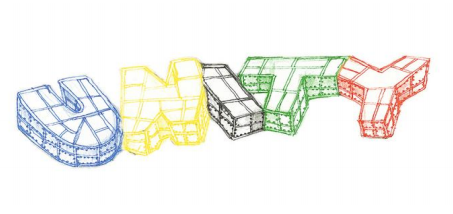
Design for Unity
The installation takes the form of a transparent maze, angular in its structure and illuminated with different coloured LED lights in each section. Each illuminated section of the structure forms a different letter, all together spelling the word ‘unity’. As the audience navigate their way through the installation, their movement is picked up by motion sensors, triggering the LEDs at each point to turn on. These each represent a particular colour of the Olympic rings.
The ideologies of the Olympic Games linked with an immersive space explores the value of ‘being together’, something which the African humanist philosophy Ubuntu also speaks about.
UNITY is effective in exploring the theoretical concepts embedded within it through a playful and simple interactive structure. As an individual you step from section to section with the different groups of LEDs individually illuminating you as you go through the work. When a group of people interact with the piece at the same time however, the piece lights up as a whole, echoing the values of being together that UNITY invites us to explore. It is through enabling this experience, that the work celebrates and explores human connections.
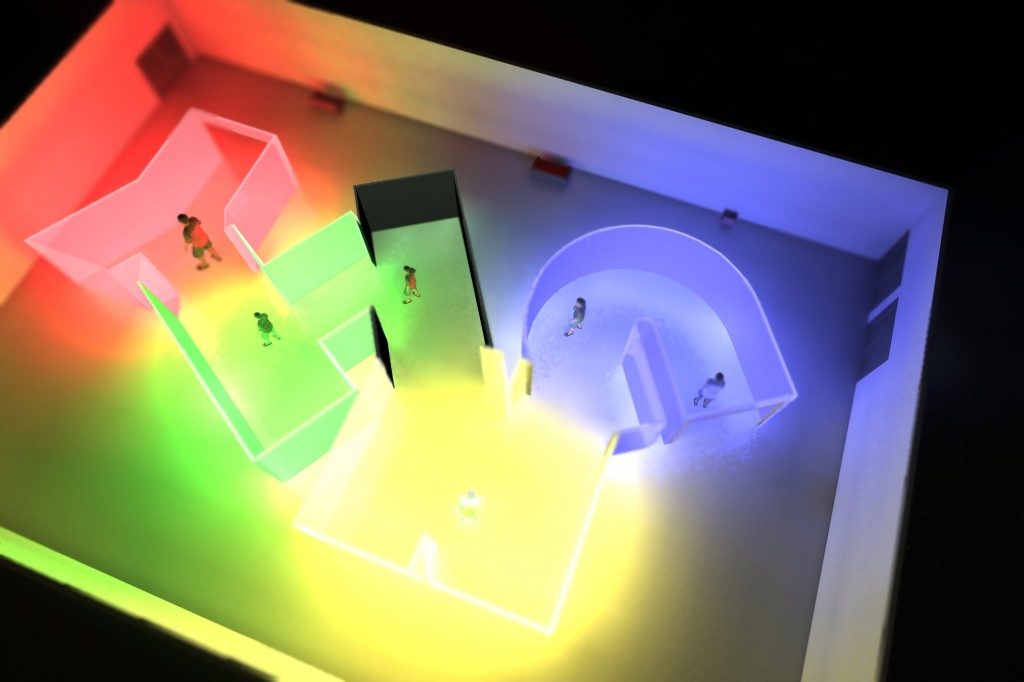
I do find it interesting how the piece has such a strong stance towards the more idealistic ideologies of the Olympics, especially when taking into account the anti Olympics sentiment present in London. The event does bring people together, but unfortunately as we’ve seen in East London and also at previous Olympic locations across the globe, they also have the ability to put local communities at risk through rising rents and eviction [1]. UNITY looks at ‘…understanding the implication of UNITY on humanism in a neo-liberal world where hyper-capitalism and love of excess trump compassion and selflessness.’ [2] but in reality, the Olympics have unfortunately become something which arguably embody these traits. This said, I do think that UNITY is an incredibly beautiful piece in its visual execution and that its interaction compliments the theoretical idea which it is looking to address.
I look forward to the remainder of the International Festival of Digital Art 2012 and the eclectic ideas within media and digital art which the programme explores. I interviewed Irini Papadimitriou, Head of New Media Arts Development at Watermans, about the Festival:
Emilie Giles: First of all, can you tell us what the premise is behind the International Festival of Digital Art 2012?
Irini Papadimitriou: The idea behind the Festival started from a decision to develop a series of shows that could form a discussion rather than being one-off exhibitions and help engage more people in the programme. In the last year we have been focusing more in participatory and/or interactive installations so I thought it’d be interesting to dedicate this project and discussions in exploring more ideas behind media artworks that invite audience engagement as a way of understanding our work in the past year.
Since this was going to take place in 2012 we felt it would be necessary to open this up to international artists so this is how the open call for submissions came up last year. We received so many great proposals it’s been very hard to reach the final selection, but at the same time the opportunity of having a year-long festival meant we could involve as many people as possible and hear many voices not only through the exhibitions (this is just one part of the Festival) but also with other parallel events such as the discussions, presentations of work in progress by younger artists and students, the publication, a Dorkboat (coming up in June with Alan Turing celebrations), as well as collaborations with other organisations or artists’ networks and online.
EG: Touching on your last answer, the Festival has a clear aim then to engage people in discussion rather than just being viewers of a show. Do you think that within media and digital art there is a particular need for this approach?
IP: I think that hearing people’s thoughts and responses and enabling discussion is important for all exhibitions and art events but specifically for the Festival (since the aim is to question & explore audience participation). It was very relevant to hear ideas and views from other artists, technologists, practitioners etc but also audiences, rather than just the participating artists.
Also, and this is my view, I think as media and digital art use technologies that many of us are not particularly familiar with or if we use technologies it will be most probably as consumers, it’s important to talk about and discuss the process (as well as impact of technologies) both for the artists as well as for audiences.
EG: The themes chosen for the programme are diverse and each relevant to media and digital art in their own way. What are the reasons for each focus and why?
IP: The themes explored in the Festival result mainly from the selected proposals and discussions with the artists. There were so many things to talk about so having these themes was a way to start from somewhere and help understand better the installations shown throughout the year. The seminars that we are organising are an opportunity for the artists to talk about their work and share their ideas with both audiences but also with other artists invited to take part in the panels. It is also a way of discussing these themes and presenting other work that raises similar issues. The seminars are shaped around the themes such as perception and magic in digital art, sound and gesture, geographies, virtual spaces as artistic mediums and of course participation and interaction. We are currently working on a publication with Leonardo Electronic Almanac which will be coming out in the next couple of months and will include essays from artists, academics and students as well as interviews with the artists behind the selected proposals. Again the catalogue has the Festival themes as a starting point but we tried to combine different content and ways of communicating these.
EG: How do the pieces featured in the exhibition question audience engagement, participation and accessibility ?
IP: The artists presenting work are exploring participation and audience engagement in different ways and I think we will have also interesting outcomes from the seminars and the publication which will allow us to explore these ideas further.
In the current installation, UNITY, One Room Shack collective are using the playful structure of a maze (in the form of the word UNITY with each letter lighting up in the colours of the Olympic rings) inviting people to walk inside to reflect and draw upon the complex nature of human reality and ‘difficult’ aspects of human existence.
Michele Barker and Anna Munster who will be showing HokusPokus later on are interested in exploring how we perceive actively in relation to our environment, how we see, what we see and how this makes us ‘interact’. HokusPokus inspired from neuroscience examines illusionistic and performative aspects of magic to explore human perception, movement and senses. The tricks shown in HokusPokus have not been digitally manipulated; they will unfold temporally and spatially, amplifying and intensifying aspects of close-up magic such as the flourish and sleight of hand.
The Festival will close with an installation by American artist Joseph Farbrook, Strata-Caster, which was created in Second Life mirroring the physical world, exploring positions of power, ownership, identity and drawing parallels between virtual and physical worlds. An interesting and important part of the installation is the use of a wheelchair by visitors to enter and navigate Strata-Caster.
EG: How have the 2012 Olympic and Paralympic Games inspired the Watermans International Festival of Digital Art?
IP: As we are trying to explore what participation is we thought it would be an interesting link (rather than inspiration) between the Festival and the Games/Cultural Olympiad since they are meant to symbolise, promote and inspire values like creativity, collaboration, participation, engagement etc. The Festival isn’t about the Olympics and participating artists didn’t have to propose work that linked to the Games, but we did receive many proposals that reflected on the Games, what they represent and the meaning of participation, so some of these proposals are being shown as part of the Festival, such as One Room Shack’s UNITY and Gail Pearce’s Going with the Flow.
It’s a bizarre thing when you stumble upon the “new art movement” filtering through discursive chatter. Is it actually a movement, or is it simply a bunch of like-minded individuals telling me its a movement?
Behold The New Aesthetic then – a new art meme in visual culture whimsically constructed by James Bridle, which manifests itself in a Tumblr blog, a presentation for Web Directions South, Sydney and an original blog post. Recent attention to it has reached feverish proportions coming off the back of a SXSW panel in March and a generally positive endorsement by Bruce Sterling in Wired, plus some group responses on the creators project. More recently, the computational media scholar and philosopher Ian Bogost has posted his own thoughts for The Atlantic.
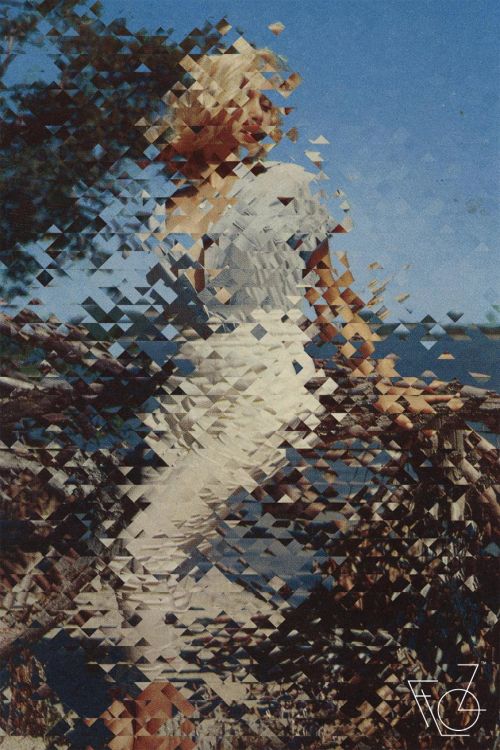
As a meme should do, “the New Aesthetic” has fulfilled its role – it has a lot of people talking about it. Like any meme which dices visual culture with some sort of research element, it has artists, writers, even media and aesthetic scholars measuring their own opinions on it in rank order without anyone knowing exactly where it’s going, what it really is or who exactly is doing it. In our noisy and crowded “I can’t believe I got 50+ retweets” over-networked epoch, this is quite an achievement even if you don’t take it that seriously.
But here’s the question: can the new aesthetic be more than a meme? More to the point, does it want to be? Is it capable of a direction? Can it be serious?
That said (and as Bridle avers) this isn’t really a prominent “movement” of ideas as such. Neither does it present material which it would deem ‘arty’. Instead, it’s an extremely broad and oblique orientation which seeks to document the subtle (and sometimes explicit) changes within our information saturated existence. It simply contextualises the contingent manifestations of computational activity, and how they are reversing and revising computational and human activities back in on themselves. Bridle’s tumblr simply presents the new aesthetic for what it is, much akin to perusing through pictures in a Facebook profile, a Reddit top ten list or clicking on Stumbleupon – simple snapshots of “stuff” which echo a blurring between the world of networks, machines and everything outside of it (with a particular emphasis on where it goes a bit wrong, hence a certain infatuation with glitchyness). Quoting Bridle’s Tumblr page;

“It is a series of artefacts of the heterogeneous network, which recognises differences, the gaps in our overlapping but distant realities.”
In another video presentation ‘We fell in love in a coded space‘ at Lift12, Bridle terms this ‘network realism’ – instances where the amalgamation of computational networked activity blurs with non-computational activity, to such an extent that it reduces any observer to nothing but a curious, passive node, gleefully whittling through instances of vaguely creative stuff. For Bridle, this occurs not just in industry but also architecture, finance, storage, fashion and now an attempt at aesthetic understanding. It’s an infatuation with the alterity of bots, algorithms, pixels and realised fictions. In this presentation however, Bridle is largely concerned with how one can respond or understand the ‘desires’ of bots, unaware that anthropomorphising the situation may not reap the rewards required. In this interpretation the new aesthetic is charged with the task of asking how we can think and orient ourselves computationally, whether it be designers, thinkers, writers, scholars or artists.
Sterling himself, mostly issues praise with a pinch of amusing impatience, as if the New Aesthetic movement should progress faster than it actually is doing, with more ideas and more focus. Kyle Chayka states that artists are already embracing it as a ‘contextual seedbed, rather than a label’. Jonathan Minard understands it as a new method of reflection concerning cultural tool-making, where the ‘dumb tools’ of machinic interface scream images back at us.

Digital Humanities scholar David Berry has blogged a similar view echoing that the new aesthetic is tapping into what he calls ‘Computationality’, a historical paradigm frame-making of sorts, which constructs specific meaning-making practices. Visualisation revolves around processes and patterns and so the list making exercise of Bridles’s Tumblr blog would seem apt in this regard, as it issues unparalleled amounts of pattern making not just as content, but as form. The archive is a jamboree of other pattern recognising events; security face recognition, retro 8bit encapsulation, satellite visuals and generally messing about with an Xbox 360 Kinect. James George mentions something similar but suggests that the new aesthetic should question the critical distance between artistic activity and technological use. It resembles a massive screen dump from a digital artist’s delicious account. Quoting Bridle again in an interview with The Design Observer Group;
“The New Aesthetic is not criticism, but an exploration; not a plea for change, rather a series of reference points to the change that is occurring. An attempt to understand not only the ways in which technology shapes the things we make, but the way we see and understand them.”
To most of the established readers here, it’s easy to criticise the “newness” of the New Aesthetic, in the same way the 90’s trope “New Media” has been quickly bundled away as if it never existed (Marius Watz makes this point). For those of you who have been studying such issues concerning hacking, play, enumeration, collecting, remixing, glitch-ing, (see Rosa Menkman in particular) in the broader realm of the computational arts, there really isn’t anything novel to gawk at: this is more of a rearrange or a rebadge. Indeed, internet discussion has been rife with such criticism, from the triteness of using Tumblr as the ‘official site’, to quick dismissals concerning the New Aesthetic’s distinct lack of any historically serious ‘substantial practice’ – not that it wanted it in the first place (Indeed it’s a pity that it has contingently replaced an identical term for a movement unrelated to Bridle’s own, coined by arts writer Michael Paraskos and realist artist Clive Head. Moreover, depending on how one looks at it, Paraskos and Head’s own movement has similar views espoused by Bridle’s version, including perhaps a direct opposition to conceptualism and foregrounding art as a material practice).
If Bridle were not so sincere about the whole affair, one would be mistaken that this was a too-cool-for-school strategy straight out of a Nathan Barley episode. But thats an easy misread. As Bogost states, Bridle is just curious about the weirdness of the network we all rely on and revel in. But there is a point where fascination with creativity turns into ADHD. The New Aesthetics tumblr site, already does just that, without any hint of standing still. “What’s going to come next? What can we do next? What are the limitations? What happens if I click that? What is that doing there?”
However both Bogost and Greg Borenstein issue a different view about the new aesthetic. They both discuss it in relation to a recent trend in philosophy called Object Oriented Ontology (OOO), a movement to which I am extremely sympathetic to. Bogost explains OOO succinctly enough;
“If ontology is the philosophical study of existence, then object-oriented ontology puts things at the center of being. We humans are elements, but not the sole elements of philosophical interest. OOO contends that nothing has special status, but that everything exists equally–plumbers, cotton, bonobos, DVD players, and sandstone, for example. OOO steers a path between scientific naturalism and social relativism, drawing attention to things at all scales and pondering their nature and relations with one another as much as ourselves.”
The link to OOO is fairly self-evident. If one of the most prominent aspects of the new aesthetic is an obsession with how a machine “sees” the world, OOO is a commitment to the seeing of things in widest possible sense. But while Borenstein generally aligns OOO to the new aesthetic with exuberant equivalence, Bogost’s view is one of general optimism, but not broad acceptance. For a start, the new aesthetics is based on a continual divide and repair between two opposing realms; the physical and the digital, each coming together and breaking apart endlessly, like throwing a box of magnets.
One of the main stipulations of being an OOO advocate is the realist eruption of what counts as a thing, and how that thing contingently relates to different types of entities. This is why Bogost decenters computation in the new aesthetic, and emphasises the multitude of things that escape the physical/digital divide. Their adventures are always-already strewn across the ontological landscape. One of the other main stipulations involves us lacking secure knowledge in fully understanding discrete units on their own terms – we can never experience their being in the same way we experience our being.
If one has read Bogost’s latest publication, Alien Phenomenology (and if you haven’t, I’d urge you to do so immediately), one would understand Bogost’s view that the new aesthetics misses out not just speculating on the hidden lives of objects other than computers and humans, but it also hovers on the inescapable problem of anthropomorphising machines and objects to within an inch of their lives. The alien aesthetics challenge is provocative.
“[T]his Alien Aesthetics would not try to satisfy our human drive for art and design, but to fashion design fictions that speculate about the aesthetic judgments of objects. If computers write manifestos, if Sun Chips make art for Doritos, if bamboo mocks the bad taste of other grasses–what do these things look like? Or for that matter, when toaster pastries convene conferences or write essays about aesthetics, what do they say, and how do they say it?”
There is an interesting discussion to be had in OOO about the usefulness of anthropomorphising the infinitesimal non-human relationships between the properties of things. Whilst others (including Bogost) see it as an inevitable factor of being one finite human entity amongst a crowd of other finite entities, I see it as a hinderance.
In particular, I’m interested in the way the new aesthetic never manages to access computation ‘just’ as it is. It only takes computation seriously when it functions as a qualitatively intelligent system, which meets or surpasses rational intelligence, or, it directly flips into “dumb tools” of (mis)communicative manipulation for the whims of human mental acts.
But I digress. Last year Bridle released a book called “Where the F**k Was I?”, which accurately sums up the mentality of the movement. The really interesting element of the new aesthetic is that it presents genuinely interesting stuff, but Bridle’s delivery strategy is set to ‘gushing disorientation’. At present, it’s the victim of the compulsive insular network it feeds off from. It presents little engagement with the works themselves instead favouring bombardment and distraction. Under these terms, aesthetics only leads to a banal drudgery, where everything melts together into a depthless disco. Any depth to the works themselves are forgotten.
Memes require instant satisfaction. Art requires depth.
The Glitch Moment(um)
Rosa Menkman
Institute Of Network Cultures, 2011
ISBN 9789081602167
Rosa Menkman’s book “The Glitch Moment(um)” is a comprehensive study of the theory, practice and social context of contemporary digital Glitch Art. Glitch Art is similar to the ironisation of the noise of old media into cultural signals seen in Trip Hop and that is the basis for the nostalgic image-making of Lomography or Instagram. But it is based on current digital technology, rather than past analogue technology.
Glitch Art is growing in popularity and critical attention, and is already being recuperated by the mass media (for example in a recent Calvin Klein perfume television advertisement). Analogue glitches have been part of art and popular culture for decades, for example in Nam June Paik’s television-based art or the titular character of the cyberpunk TV show “Max Headroom”. Digital glitches and their simulation featured in the postmodern graphic design of the early 1990s created by groups such as Designers’ Republic. But between a history of analogue media and a future of mass media recuperation there is the current Moment(um) of digital glitch aesthetics that Menkman identifies.
Menkman begins by explaining the basics of Shannon/Weaver information theory as the basis for a theory of what glitches are. In information theory, messages are sent as a signal from a transmitter to a receiver over a channel which is disrupted by a source of noise. This “noise” is the crackle on analogue telephones or on vinyl records, the static on analogue TV and radio, and the corruption that sometimes affects digital images or audio streams (nowadays notably Skype chats).
Where kinds of noise are associated with a particular we can recognise them as particular “noise artifacts”. We can also recognise compression artefacts in digital media such as those seen in over-compressed lossy image and video files (JPEG and MPEG artefacts). These noise and compression artifacts are experienced by the users of communication media as glitches. Menkman describes these phenomena in detail, providing the reader with a firm foundation in the sources and expression of Glitch phenomena.
How artists can deliberately create these phenomena is the subject of the next section of the book. Titled “A Vernacular Of File formats” it is a condensed adaptation of Menkman’s 2010 artwork of the same name. It is a thorough and accessible resource for both understanding the production of and creating visual glitch aesthetics. Each picture demonstrates a technique for modifying the data of an image file format so that a computer can still parse and render the file but it will appear corrupted to a human viewer. Starting with an uncorrupted (but unnervingly contrasty) “RAW” image, Menkman explains the production and principles of corrupted digital images in sufficient detail that the reader can recreate and build on these techniques themself, or use this knowledge as the basis for understanding and appreciating the work involved in the Glitch Art produced by others.
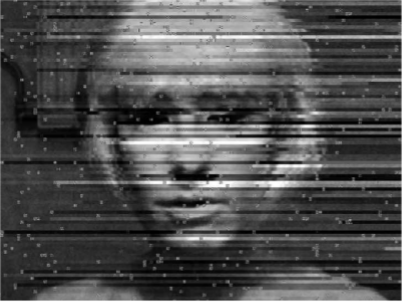
The next two chapters cover the phenomenology and philosophy of Glitch. The theories of Paul Virilio and Alan Liu are usefully deployed here to give Glitch a philosophical grounding. But there is also a recognition that Glitch is an inherently open concept that is difficult to define. Menkman rightly considers the work of Beflix (Ant Scott) as a leading Glitch Art figure. The diversity of Beflix’s work illustrates the problem with categorizing Glitch neatly, or at all. 5VOLTCORE, JODI, and others provide alternative views of what Glitch can be. This builds to Menkman defining “Glitchspeak” as the vernacular, or in possibly the creole, of Glitch Art.
In “From Artifact To Commodity”, Menkman turns to Glitch aesthetics in music, particularly the glitches created through circuitbending, and the precedent this has set for the creation of standardized tools for glitching visual media. As such tools have been created for images, Glitch aesthetics have found their way into the artistic mainstream and into music videos and other mass media. Glitch may be impossible to categorize but it is all too easy to commodify. This marks its emergence as a genre, and Menkman finishes this section by considering Glitch as a recognizable but still problematic genre that relies heavily on spectators’ technical, aesthetic and theoretic literacy.
Having given the reader a solid grounding in the theory, practice and philosophy of Glitch, Menkman finally moves on to its sociology. Using a tool that looks like Gephi but isn’t (Issuecrawler), Menkman models the social network of relationships between Glitch artists that exist on the Internet. Clustering blogs and other Internet expressions by the number of links between them allows the tools of social network analysis to be used, revealing who is central to the Glitch artworld as judged by the clicks of their peers.

Finally Menkman sums up Glitch aesthetics in a section called “The Emancipation of Dissonance Glitch”. Starting with a quote from Jackson Pollock:
“I don’t use the accident. I deny the accident. There is no accident, just as there is no beginning and no end.”
Menkman concludes that “Like the best ideas, glitch practices are dangerous because they generate awareness”. By which point the reader is perfectly placed to understand just how and what kind of awareness Glitch generates, and how they can appreciate or produce Glitch art themselves.
Glitch Art has been long overdue serious critical attention. I cannot remember the last time I read a book that so thoroughly and concisely presented the theory and practice of a contemporary art movement in as does “The Glitch Moment(um)”.
You can download a PDF or order a print copy here
The text of this review is licenced under the Creative Commons BY-SA 3.0 Licence.
DoggieWoggiez! PoochieWoochiez! is a new video work (2012) by Everything is Terrible!, a self-described “found footage chop shoppe”. DoggieWoggiez! PoochieWoochiez! is an active catalog which describes, invents and destroys concepts as it arranges video footage into flows of multiple cuts that map the use of dogs in cinema and television. The structure of this review takes hints from the work it overlays. We dispensed with “original” writing and didactic detailing of what we as critics experienced. Instead, we unraveled multiple threads left hanging after watching DoggieWoggiez! PoochieWoochiez! We neglected to offer an appraisal of the worth of the work, and add to the number of words already in the world. Instead, we traced the flows passing through the video and developed a program of citations that provide a map of exit and entrance points-a map, as any map, that is as much about those making as about the territory described-which we hope will provide openings for a reader who has not yet watched the work, and provide expanded intersections for those who already have.
“This is the scenario: You are terminally ill, all medical treatments acceptable to you have been exhausted, and the suffering in its different forms is unbearable. Because the illness is serious, you recognize that your life is drawing to a close. Euthanasia comes to mind as a way of release.” [note]Humphry, Derek. Final Exit. New York: Delta Trade Paperback, 2001. 1.[/note]
“Success consists of simply getting up one more time than you fall.” [note]Jerry Maguire. Dir. Cameron Crowe. Gracie Films and TriStar Pictures. 1996. Sign on the locker room wall.[/note]
“From whatever angle you approach it, the present offers no way out. This is not the least of its virtues. From those who seek hope above all, it tears away every firm ground. Those who claim to have solutions are contradicted almost immediately. Everyone agrees that things can only get worse. ” [note]The Invisible Committee. The Coming Insurrection. Cambridge, MA: Semiotext(e) Intervention Series, 2009. 23.[/note]
“A positive anything is better than a negative nothing.” [note]Jerry Maguire. Sign on the locker room wall.[/note]
“I think it’s because dog movies and dog footage tends to be the dumbest. It’s like the lowest common denominator amongst everything we’ve found, the most mediocre footage imaginable. I think that was a big motivator, and we just like dogs. It’s a nicer way to deliver horrible things about humanity. Instead of watching people be racist, which makes you feel terrible, you get to watch dogs be racist, and you’re like, ‘That’s a little better.'” [note]Gilgamesh, Commodore. Interview by Ben Munson. “Everything Is Terrible!’s Commodore Gilgamesh”. The A.V. Club, 2012. Web, Jan. 2012. http://www.avclub.com/madison/articles/everything-is-terribles-commodore-gilgamesh,68313/[/note]
“Americans spent $50.96 billion on their pets in 2011. That’s an all-time high, and for the first time in history more than $50 billion has gone to dogs, cats, canaries, guppies and the like, the American Pet Products Association reports. Food and vet costs accounted for about 65 percent of the spending. But it was a service category one that includes grooming, boarding, pet hotels, pet-sitting and day care that grew more than any other, surging 7.9 percent from $3.51 billion in 2010 to $3.79 billion in 2011.” [note]T&D Staff. “Pet ownership responsibility has not changed.” The Times and Democrat. Web. March 10, 2012. http://thetandd.com/news/opinion/pet-ownership-responsibility-has-not-changed/article_c3fd2738-6a73-11e1-a700-001871e3ce6c.html[/note]
“So we have a corpse on our backs, but we won’t be able to rid ourselves of it just like that. Nothing is to be expected from the end of civilization, from its clinical death. In and of itself, it can only be of interest to historians. It’s a fact, and it must be translated into a decision. Facts can be conjured away, but decision is political. To decide on the death of civilization, then to work out how it will happen: only decision will rid us of the corpse.” [note]The Invisible Committee. 94.[/note]
2:39 . Black and white footage of a clothed dog sleeping in hay.
2:41 . Saint Bernard laying on the floor trying to drink champagne out of a bottle.
2:42 . Black and white footage of a dog holding a bottle labeled “Hard Cider” in his mouth and drinking.
2:43 . Dog with bandana sitting at table licking the foam from a beer.
A hand pouring beer into a dish filled with dog food.
2:44 . A club. Multiple young women filling the face of a puppet dog full of liquor bottles.
2:45 . A dog wearing a jersey with the number one peeing on a referee’s ankle.
2:47 . A dog lifting its leg on a pants suit leg.
A bulldog in a spiked collar peeing on a floor mat that says “I [heart] Acting.”
2:48 . A dog peeing on a metal catwalk, shot from below.
2:49 . Jack Nicholson holds a small dog up and away from his chest as the dog pees.
A man lying on a floor is shot below and through a dogs legs, the dog’s urine stream is hitting him in the face.
2:51 . A similar shot, reversed. Another man, wearing a fur hat, is buried to his neck in sand and ice. A dog urinates into his mouth.
2:51 . The same bulldog in spiked collar lifts his leg to pee. A small rocket comes out of from beneath him.
2:52 . A similar shot from the other side, a different dog is urinating flames.
“I am for an art that embroils itself with the everyday crap & still comes out on top.” [note]Oldenburg, Claes. “I Am for an Art…,” Theories and Documents of Contemporary Art: A Sourcebook of Artists’ Writings. eds. Stiles, Kristine and Selz, Peter. Berkeley: University of California Press, 1996. 335.[/note]
“Trash collection is the business of public sanitation; its recycling, the very height of capitalist alchemy, turns everything into grist for commodification’s mill. But it is also a strategy of aesthetic sublimation that, according to Thomas Crow, is internal to modernism (he has analyzed the cyclical aspect of this in terms of the incorporation of the ‘low’ by the ‘high’)” [note]Bois, Yve-Alain and Krauss, Rosalind. “A User’s Guide to Entropy.” October. 78.Autumn 1996. 47.[/note]
“Classification in the widest sense is, along with astronomy, probably one of the oldest scientific pursuits undertaken by man. In the most general terms classification is the process of giving names to a collection of objects which are thought to be similar to each other in some respect. The ability to sort similar things into categories is obviously a primitive one, since it would seem to be a prerequisite of the development of language, which consists of words which help us to recognize and discuss the diSerent types of events, objects and people we encounter; each noun in a language is a label used to describe a class of things which have striking features in common. Thus for example, we name animals as cats, dogs, or horses and such a name collects individuals into groups.” [note]Everitt, B.S.. “Unresolved Problems in Cluster Analysis.” Biometrics. 35.1. 169.[/note]
“I am for an art that imitates the human, that is comic, if necessary, or violent, or whatever is.” [note]Oldenburg, Claes. 335.[/note]
“What is it that moves over the body of a society? It is always flows, and a person is always a cutting off [coupure] of a flow. A person is always a point of departure for the production of a flow, a point of destination for the reception of a flow, a flow of any kind; or, better yet, an interception of many flows.” [note]Deleuze, Gilles and Guattari, Félix. A Thousand Plateaus: Capitalism and Schizophrenia. Trans. Brian Massumi. Minneapolis: University of Minnesota Press. 1987. 28.[/note]
“I am for the art of things lost or thrown away, coming home from school.” [note]Oldenburg, Claes. 335.[/note]
“Cluster analysis, also called data segmentation, has a variety of goals. All relate to grouping or segmenting a collection of objects into subsets or “clusters,” such that those within each cluster are more closely related to one another than objects assigned to different clusters. An object can be described by a set of measurements, or by its relation to other objects.” [note]Friedman, Jerome; Tibshirani, Robert and Hastie, Trevor. The Elements of Statistical Learning. 2nd ed. published online: Springer, February 2009. http://www-stat.stanford.edu/~tibs/ElemStatLearn/ 501.[/note]
“And now, we have to start from scratch with this movie and go through thousands of VHS tapes and find those three minutes and put them in a pile until we have enough to make an hour-long movie. And yeah, it made it harder because we just fucking hate those movies.” [note]Gilgamesh, Commodore.[/note]
“Central to all of the goals of cluster analysis is the notion of the degree of similarity (or dissimilarity) between the individual objects being clustered. A clustering method attempts to group the objects based on the definition of similarity supplied to it.” [note]Friedman, Jerome; Tibshirani, Robert and Hastie, Trevor. 502.[/note]
“[Claes Oldenburg] quickly saw that it didn’t take anything to make a Ray Gun: any right angle would suffice, even blunted, even barely perceptible. The Ray Gun is the ‘universal angle’: ‘Examples: Legs, Sevens, Pistols, Arms, Phalli-simple Ray Guns. Double Ray Guns: Cross, Airplanes. Absurd Ray Guns: Ice Cream Sodas. Complex Ray Guns: Chairs, Beds. Mondrian didn’t need to reduce everything to the right angle: everything is already a right angle. During the time of The Store, Oldenburg made huge numbers of Ray Guns (in plaster, in papier mache, in all kinds of materials in fact), but he soon saw that he didn’t even need to make them: the world is full of Ray Guns. All one has to do is stoop to gather them from the sidewalks (the Ray Gun is an essentially urban piece of trash: Oldenburg produced their anagram as Nug Yar:New York). Even better: he didn’t even need to collect them himself; he could ask his friends to bring them to him (he limited himself to accepting or refusing the find’s addition into the corpus, according to purely subjective criteria). Finally, there are all the Ray Guns one can’t move- splotches on the ground, holes in the wall, torn posters-but which one could photograph. The “inventory”is potentially infinite. And what should be done with this invasive tide? Put it in the museum.” [note]Bois, Yve-Alain and Krauss, Rosalind. 49-50.[/note]
“I am for the art out of a doggy’s mouth, falling five stories from the roof.” [note]Oldenburg, Claes. 355.[/note]
2:54 . A dog and man lay side-by-side. The dog’s legs are up and its belly is exposed to the camera. Voiceover: “Being a thief isn’t bad enough, you have to be a lush too.”
2:56 . A golden retriever puppy faces the camera with a drunken expression. The dogs lips move as he says “That’s the weirdestest grape juice ever.” He laughs.
3:02 . A dog jumps off a large desert rock onto another rock. He yells “Hasta la vista, kitty.” A mountain lion is shown launching into the air.
3:05 . Maniacal laughter is played over footage of a tree frog sitting on the top of a dog’s head.
3:06 . A Weimaraner sleeps under a blanket. Voiceover: “Do dogs dream? She dreams she’s a dear”
A ripple dissolve into the same dog with her head stuck through a tapestry of deer so that it appears that there is a deer with a dog head.
“Are there Oedipal animals with which one can ‘play Oedipus,’ play family, my little dog, my little cat, and then other animals by contrast draw us into an irresistible becoming? Or another hypothesis : Can the same animal taken up by two opposing functions and movements, depending on the case?” [note]Deleuze, Gilles and Guattari, Félix. 233.[/note]
“Writing about the dog who befriended him and his fellow-inmates in a concentration camp, and whom they named Bobby, Levinas says that this dog was ‘the last Kantian in Nazi Germany,’ because his joyful greetings reminded the prisoners of their human dignity. Yet, when questioned closely about the ethical status of nonhuman animals, Levinas is reluctant to ascribe to animals that ‘ethical face’ which he elsewhere has called (as Martin calls Sylvia’s face) ‘an epiphany.’ By contrast, says Levinas, the animal face is merely ‘biological,’ incapable of demanding the ethical response. Levinas denies that the dog can have a face in the ethical sense: ‘the phenomenon of the face is not in its purest form in the dog,’ he writes. ‘I cannot say at what moment you have the right to be called ‘face.’ The human face is completely different and only afterwards do we discover the face of the animal.’ In an article subtitled ‘Levinas Faces the Animal,’ Peter Steeves, with gentle irony, stages another face-to-face encounter between Levinas and Bobby, asking the philosopher: ‘What could Bobby be missing? Is his snout too pointy to constitute a face? Is his nose too wet? Do his ears hang low, do they wobble to and fro? How can this not be a face?'” [note]Chaudhuri, Una. “(De)Facing the Animals Zooësis and Performance.” TDR: The Drama Review. 51.1. 16.[/note]
“We’ve always had a thing with how people treat little people at Everything Is Terrible!, like it’s really weird and creepy. Anybody who’s like a second-class being, when they’re used in videos, it comes across very creepy and gross. I think it’s the same thing with humans and dogs. They’re weirdly sexualized, they’re weirdly turned into little kids at the same time.” [note]Gilgamesh, Commodore.[/note]
“…individuated animals, family pets, sentimental, Oedipal animals each with its own petty history, ‘my’ cat, ‘my’ dog. These animals invite us to regress, draw us into a narcissistic contemplation, and they are the only kind of animal psychoanalysis understands, the better to discover a daddy, a mommy, a little brother behind them (when psychoanalysis talks about animals, animals learn to laugh): anyone who likes cats or dogs is a fool.” [note]Deleuze, Gilles and Guattari, Félix. 240.[/note]
“I think that’s a big reason why people use dogs the way they do, because I think we kind of hate ourselves so we dress up dogs like ourselves to mock ourselves. So you dress a dog up like a drunk human, and then you laugh at how ridiculous it is, but I think it’s therapeutic. We’re letting off steam about how much we hate ourselves.” [note]Gilgamesh, Commodore.[/note]
3:13 . A close-up of a shaggy dog who speaks. “It’s not a dream”.
3:16 . A large dog outside a car tells a small dog inside a car, “Bitches ain’t got no business being inside your head” The voice is or is similar to Samuel Jackson’s.
3:17 . A bloodhound with an ice pack on its head also has cartoon dream bubbles floating around it. The woman inside the bubbles says, brightly “Wake up!”
Another dog, turning his head to the camera, says “Who are those jokers?”
Return to the bloodhound, the floating woman says “It’s me, Jan.”
3:20 . A dog dressed as a pauper is grabbed from above and dragged to the side.
A dog wearing a bandana says “Great danes! This is terrible. But what can I do…”
This trails into a golden retriever saying “…I’m a dog.”
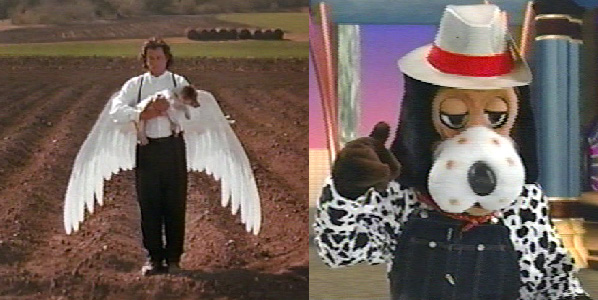
“What difference does it make if someone is terminal? We are all terminal.” [note]Gupta, Sanjay. “Kevorkian: ‘I have no regrets'” CNN Health. June 14, 2010. http://articles.cnn.com/2010-06-14/health/kevorkian.gupta_1_kevorkian-dr-jack-euthanasia-assisted-suicide?_s=PM:HEALTH[/note]
layla commented: 4-21-2008 9:01 PM “In 2007 Guillermo Vargas Habacuc a so called artist took an abandoned dog from the streets tied him to a very short rope to a wall in an art gallery and left a kettle of food on the other side of the room beyond his reach and left him there to slowly die of hunger and thirst. The socalled artist of such cruelty and the visitors of the gallery of art watched the agony of this animal. The dog finally died of famine surely after a painful absurd and incomprehensible torture. The prestigious Centralamerican Biennial of Art decided that this horrible act committed by this guy was art and Guillermo Vargas Habacuc has been invited to repeat his cruel actions in said Biennial in 2008. i seen this post on facebook and a few pictures of the poor innocent dog starving to death it broke my heart and i had to see if peta was aware of this sick man who thinks this i some great at creation.” [note]layla. comment. “Artist Starving Dog?” The Peta Files. April 21, 2008. Date of access: March 28, 2012. http://www.peta.org/b/thepetafiles/archive/2008/04/21/artist-starving-dog.aspx[/note]
olivia commented: 5-10-2008 5:35 PM “i hate you. you should be put in the poor dog’s possision. you can’t imagine how many people hate you. almost more than a million. just so you know thats not art. the dog died because of you. you should go to prison because of this. you broke peoples’ hearts. i am really upset at you i could write all day long if i have to because you just waisted a life i wish i could waiste youres!!!!!! do you wish all the animals should die? you just made my day so so so horrible. im going to tell everyone what you just did. just so you know i’m cring. i hate hate hate hate you. you should be ashamed of your self. so listen to this just because you think your all that doesn’t mean that you can kill an other animal. i have 7 animals and you are not going to touch them! that dog did nothing to you. if heshe did doesn’t mean you should kill him! please don’t touch any other animal!!!!!! you suck!!!!!!!!!!!!!!!!!!!!!!!!!!!!!!!!!!!!!!!!!!!!!!!!!!!!!!!!!!!!!!!!!!!!!!!!!!!!!!!!!!!!!!!!!!!!!!!!!!!!!!!!!!!!!!!!!!!! P.s i hate youuuuuuuuuuuuuuuuuuuuu” [note]olivia. comment. ibid.[/note]
Renate commented: 5-5-2008 1:34 PM “Here’s a thought let’s tie up Guillermo Vargas at one of his own exhibits and starve him to death!” [note]Renate. comment. ibid.[/note]
Rainie M commented: 4-28-2008 2:59 PM “Oh Gods! How can anyone be so bloody heartless? Dead or dying animals are NOT art…things like this only come from sick minds. Is the human race devolving so much that we have come down to this as entertainment? If you want Art go to a Museum . Geez this is just sick…” [note]Rainie. comment. ibid.[/note]
Tucker commented: 4-26-2008 10:43 AM “THIS IS DOWN RIGHT UNCALLED FOR DIGUSTINGCRUEL AND THESE PEOPLE NEED TO BE LOCKED UP AND CHARGED BIG TIME!!!!!!!!!!!!!!!!!!!!!!!!!!!!!!!!!!!!!!!!!!!!!!!!!!!!!!!!!! I AM CRYING SO HARD RIGHT NOW IT IS UNBELIEVABLE WHAT $IN PEOPLE DO TO ANIMALS AND THIS ALL NEEDS TO STOP NOW AND BIG TIME CHARGES AND JAIL TIME NEED TO BE STRONGER AND LONGER IN ALL STATES AND AROUND THE WORLD!!!!!!!!!!!!!!!!!!!!!!!!!!!!!!!!!!!!!!!!!!!!!!!!!!!!!!!!!!!!!!!!!!!!!!!!!!!!!!!!!!!!!!!!!!!!!!!!!!!!!!!!!!!!!!!!!!!!!!! SAVE THE ANIMALS!!!!!!!!!!!!!!!!!!!!!!!!!!!!!!!!!!!!!!!!!!!!!!!!!!!!!!!!!!!!!!!!!!!!!!!!!!!!!!!!!!!!!!!!!!!!!!!!!!!!!!!!!!!!!!!!!!!!!” [note]Tucker. comment. ibid.[/note]
Angie commented: 4-24-2008 12:55 PM “I am so sickend by this whole so called art.. I am a artist myself. ! And i think someone need to tie this guy up and not feed him any food and have people watch him starve . Then he will realize how it feels. He gives a bad name to other artist out there!” [note]Angie. comment. ibid.[/note]
yf commented: 4-22-2008 2:32 PM “you know he really shoudl have starved himself and then do a ‘selfportrait’.. much more apt.. silly stupid man.. so pointless.. so banal.. people KNOW what skeletal skin and bones animals look like .. we have seen them.. we know what skeletal starved humans look like too infact.. we dont’ need a dumb dimwit 12 brained idiot to INTENIONALLY starve a dog in ORDER to produce his pointless ‘artwork’.. what a dumb stupid peabrained twit !” [note]yf. comment. ibid[/note]
Kristin Gleeson commented: 4-22-2008 1:29 AM “Yeah I’ve seen something like this before but what was it? Oh yeah the HOLOCAUST. Thousands of people collected subdued and starved to death. Was that an artistic masterpiece? If you call this art you’d have to call Hitler an artist I mean after all he was trying to make a culturally altering statement as well. It’s not art it’s sadistic immoral and completely disgusting. This poor creature did not deserve this and neither does any other animal on the planet.” [note]Gleeson, Kristin. comment. ibid.[/note]
“Do not imitate a dog, but make your organism enter into composition with something else in such a way that the particles emitted from the aggregate thus composed will be a canine as a function of the relation of movement and rest, or of molecular proximity, into which they enter.” [note]Deleuze, Gilles and Guattari, Félix. 247.[/note]
“Its efficiency is striking. There is nothing extra, superfluous or obscure about Mr. Kulik’s performance. For all intents and purposes, he is a dog: he can be scary and unpredictable and territorial. After all, he’s in his prime, about 5 dog years old; visitors who wish to enter his cage may do so one at a time and must put on the quilted overalls and arm-guards that hang near the chained and barred door to his cage.” [note]Smith, Roberta. “On Becoming a Dog By Acting Like One.” New York Times. April 18, 1997. http://www.nytimes.com/1997/04/18/arts/on-becoming-a-dog-by-acting-like-one.html[/note]
“The choice of the term ‘pack’ for this older and more limited kind of crowd is intended to remind us that it owes its origin among men to the example of animals, the pack of animals hunting together. Wolves, which man knew well and from whom many of the dogs he uses derive, had impressed him very early. Their occurrence as mythical animals among so many peoples, the conception of the were-wolf, the stories of men who, disguised as wolves, assailed and dismembered other men, the legend of children brought up as wolvesall these things and many others prove how close the wolf was to man.” [note]Canetti, Elias. Crowds and Power. New York: Viking Press, 1966. 96.[/note]
“Saying it would be too confusing, a judge has denied the petition of a so-called ‘furry’ to legally change his name to Boomer the Dog. Forty-four-year-old Green Tree resident Gary Guy Mathews says he filed for the name change in June because he’s a fan of a short-lived 1980s NBC television series called “Here’s Boomer,” which featured a dog that rescued people.” [note]Today Staff and wire. “Judge won’t let man call himself ‘Boomer the Dog’.” Today News. August 12, 2010. http://today.msnbc.msn.com/id/38673766[/note]
Where’s Waldo, #1.5 – Sun Aug 15, 2010 10:31 PM EDT “This boy ain’t wired right. I’ve heard of men wanting to be a women and women wanting to be men but this is a new one on me. Mom and Dad must have raised the poor kid in a kennel instead of a crib. Wonder what his favorite pup food was? Of course maybe he’s smarter than any of us thinks……or maybe not.” [note]Where’s Waldo. comment. ibid.[/note]
dave-735909, Thu Aug 12, 2010 10:21 AM EDT “Why can’t we just respect people’s constitutional right to be crazy?” [note]dave-735909. comment. ibid.[/note]
Susi-Oh, Thu Aug 12, 2010 12:10 PM EDT “My sentiments exactly but how far do you want to take this? Should we just let him bark back when you ask him a question? Can you introduce a guy like that with a straight face? He’s big for a dog and might scare little children. Actually, even without the name change he looks a bit scary.” [note]Susi-Oh. comment. ibid.[/note]
Janet A., #15 – Thu Aug 12, 2010 10:59 AM EDT “If this idiot was truly a dog, we’d put him to sleep for being insane. Just a thought.” [note]A., Janet. comment. ibid[/note]
wchall1949, #2 – Thu Aug 12, 2010 10:15 AM EDT “OMG – the really frightening thing here is that this guy is allowed to marry & reproduce!!! Truly scary!! What a moron!!!” [note]wchall1949. comment. ibid.[/note]
Sues-343312, #2.1 – Thu Aug 12, 2010 11:22 AM EDT “Well he is 44 yrs old has managed to not procreate up to now. Let’s just hope he meets up with a spayed female” [note]Sues-343312. comment. ibid.[/note]
3:26 . A close-up of a crying child, with a dissolve of snow over his face. He says “Daddy…”
Close up of an adult man, he says “I don’t have a daddy.”
A girl wears a party hat. Lying on her bed, she talks to her brother, also wearing a party hat. She says “I just miss him so much…”
Cut to a different girl in pigtails addressing a bloodhound wearing a king’s crown and fur cape. She says “I miss him too.”
3:30 . Close-up of a crying boy. “I miss him, mom.”
Angry-looking farmer standing under a tree. He says “Your mother passed on.”
3:32 . A woman lays on a bed with a girl. “…to join the angels.”
A man looks up to the sky and gestures upwards “She’s in heaven.”
A woman with a party hat “watching over you right now.”
3:37 . A boy addresses a dog. “My dad used to do that.”
A boy and his mother talk as she drives. The boy says “He wants a dad.”
A woman sits next to a boy outside with a rocky hill behind them. He is looking through binoculars. She says “You remind me a lot of your dad sitting there.”
“When they’re your best friend it turns into this weird, gross, furry pile where you can’t tell where the lines are between human and dog, master and slave, and sex, and it’s just ugh.” [note]Gilgamesh, Commodore.[/note]
“Bestiality lowered a man to the level of a beast, but it also left something human in the animal.” [note]Murrin, John M. “‘Things Fearful to Name’: Bestiality in Colonial America.” Pennsylvania History. 65.Explorations in Early American Culture. 1998. 10.[/note]
“A man has appeared before Limerick District Court charged with ordering his Alsatian dog to have sex with a 43-year-old mother of four, who died from an adverse allergic reaction to the intercourse.” [note]Staff. “Woman died from allergic reaction to sex with dog” thejournal.ie. Web. Mar 7, 2011. http://www.thejournal.ie/woman-died-from-allergic-reaction-to-sex-with-dog-172620-Jul2011/[/note]
“Addressing the consent issue, Daniels writes, ‘[T]he truth is that animals, particularly domesticated ones, don’t consent to most of the things that happen to them.’ Animal sexual autonomy is regularly violated for human financial gain through procedures such as AI. Such procedures are probably more disturbing physically and psychologically than an act of zoophilia would be, yet the issue of consent on the part of the animal is never raised in the discussion of such procedures. Should the day Bentham speaks of arrive when animal rights are recognized by society and the law, an argument which speaks only to the zoophile’s right to fair exercise of his property rights in the animals he owns may prove an insufficient legal justification for acts of zoophilia.” [note]Cutteridge, Brian Anthony. “For the Love of Dog: On the Legal Prohibition of Zoophilia in Canada and the United States.” Sex, Drugs and Rock & Roll: Psychological, Legal and Cultural Examinations of Sex and Sexuality. eds. Gavin, Helen & Bent, Jacquelyn. Oxford, UKL Inter-Disciplinary Press, 2010.[/note]
“In 1812 in a similar case in strongly Federalist Seneca County, New York,William Moulton, a fifty-eight-year-old veteran of the Revolutionary War and a prominent Democratic-Republican, was accused of buggering a bitch, which then delivered a litter of puppies that ‘had large heads, no hair on them nor tails, and on the side of their head they had small ears.'” [note]Murrin, John M. 35.[/note]
“I am for the majestic art of dog-turds, rising like cathedral.” [note]Oldenburg, Claes. 335.[/note]
“The right of sovereignty was the right to take life or let live. And then this new right is established: the right to make live and to let die.” [note]Foucault, Michel. “Society Must Be Defended” Lectures at the Collège De France 1975 – 1975. New York: Picador, 2003. 241.[/note]
“Though a single gull had already struck Melanie on the forehead the day before, the choice of the children’s party for this first fully choreographed attack suggests the extent to which the birds take aim at the social structures of meaning that observances like the birthday party serve to secure and enact: take aim, that is, not only at children and the sacralization of childhood, but also at the very organization of meaning around structures of subjectivity that celebrate, along with the day of one’s birth, the ideology of reproductive necessity.” [note]Edelman, Lee. No Future. Durham, NC: Duke University Press, 2004. 121.[/note]
“Death is outside the power relationship. Death is beyond the reach of power, and power has a grip on it only in general, overall or statistical terms…death now becomes, in contrast, the moment when the individual escapes all power, falls back on himself and retreats, so to speak, into his own privacy. Power no longer recognizes death. Power literally ignores death.” [note]Foucault, Michel. 248.[/note]
“Physician assisted suicide is fundamentally inconsistent with the physician’s professional role.” [note]Council on Ethical and Judicial Affairs, American Medical Association. “Physician-Assisted Suicide.” CEJA Report. 8 – I-93. Web. http://www.ama-assn.org/resources/doc/ethics/ceja_8i93.pdf[/note]
“Even worse their comments continue to make no distinction between hierarchical and non-hierarchical organizations and institutions — simply rejecting all organization — which is tantamount, if you think about it for a minute, to proposing a future that lacks workplaces, religious centers, families, any kind of assemblies, and so on — a future in which lone individuals or small groups fend for themselves (a vision seemingly not too far from what they propose).” [note]Spannos, Chris. “The Coming Insurrection or the Arrival of Suicidal Nonsense?” ZNet. July 23, 2009. Web. Date of access: March 28, 2012. http://www.zcommunications.org/the-coming-insurrection-or-the-arrival-of-suicidal-nonsense-by-chris-spannos[/note]
‘It is critical that the medical profession redoubles its efforts to ensure that dying patients are provided optimal treatment for their pain and other discomfort. The use of more aggressive comfort care measures, including greater reliance on hospice care, can alleviate the physical and emotional suffering that dying patients experience. Evaluation and treatment by a health professional with expertise in the psychiatric aspects of terminal illness can often alleviate the suffering that leads a patient to desire assisted suicide.” [note]Council on Ethical and Judicial Affairs, American Medical Association.[/note]
“Their vision of a commune offers very little guarantee of its own basic existence. There are no proposed methods for deciding what will be produced or consumed nor how much of each or its distribution in a socially responsible way.” [note]Spannos, Chris.[/note]
“The euthanasia of animals has been acknowledged by most animal protection organizations, including [The Humane Society of the United States], as an appropriate and humane means of ending the suffering of an animal in physical distress. It is also used widely to end the lives of animals who have severe behavioral problems, including aggression, and cannot be adopted into an appropriate new home because they pose a threat to the health and safety of people or other animals.” [note]The Humane Society of the United States. “Statement on Euthanasia.” Humane Society of the United States Website. July 15, 2009. Date of access: March 28, 2012. http://www.humanesociety.org/about/policy_statements/statement_euthanasia.html[/note]
“Once we know where it is we want to go, we can then act with the urgency needed to organize and build institutions and movements able to win change and create the necessary foundations for a future society.” [note]Spannos, Chris.[/note]
“Those who demand another society should better start to realize that there is none left. And maybe they would then stop being wannabe-managers.” [note]The Invisible Committee. 86.[/note]
“This is the dog’s real trick, the height of animal acting. Not surprisingly, the imitated action is one of violence and must have been somewhat complicated; because all pet dogs, and dog performers most of all, must be nonviolent and cooperative, the animal actor here must go against its ‘nature’ in order to successfully set up the final tableau. That animals can be domesticatedmade to forego violence in order to serve peopleis the triumph of human culture over nature. That they can then be trained to appear violentto attack humansis the ironic confirmation of this subjection.” [note]Peterson, Michael. “The Animal Apparatus From a Theory of Animal Acting to an Ethics of Animal Acts” TDR: The Drama Review. 51.1 Spring 2007. 37.[/note]
“Should you battle on, take the pain, endure the indignity, and await the inevitable end, which may be days, weeks or months away? Or should you take control of the situation and resort to some form of euthanasia, which in its modern-language definition has come to mean ‘help with a good death’?” [note]Humphry, Derek. 1.[/note]
“At the final stage of this evolution, we see the first socialist mayor of Paris putting the finishing touches on urban pacification with a new police protocol for a poor neighborhood, announced with the following carefully chosen words: ‘We’re building a civilized space here.’ There’s nothing more to say, everything has to be destroyed.” [note]The Imaginary Party. “How to?” Tiqquin Website. Date of access: Mar 28, 2012. http://www.clairefontaine.ws/tiqqun/how.pdf 8[/note]
3:43 A montage of eerily smiling children’s’ faces. Audio is the word “dad” played over and over as it overlaps and becomes “dog”. The words dad and dog are repeated in a loop. The video becomes a distorted montage of psychedelic faces of children and dogs. Eventually the words dad and dog becomes god.
4:03 The montage audio and video end abruptly.
A small dog says “I know something we can do.”
A shot of a Bernese, who says “Poop” then winks.

DoggieWoggiez! PoochieWoochiez! $20
http://www.everythingisterrible.bigcartel.com/product/doggiewoggiez-poochiewoochiez
http://www.everythingisterrible.com/